


The first thing to know about Easter Island is that it’s kind of shitty to call it Easter Island. We only call it that because the first white person to bumble across the island happened to do so on Easter Sunday in 1722, and so he decided that’s what it should be called. This is like if somebody met you on a Tuesday and they didn’t bother to learn your name so they just called you “Tuesday” for the rest of your life. Thankfully the Chileans are more sensitive than this and refer to the island as “Isla de Pascua,” which translates to Easter Isl… shit.
In the local language it’s known as Rapa Nui, which is also the name of the people and the language itself. In the past it had been called “The Navel of the World,” “Eyes Looking to the Sky” and “The Only Place There Is What Do You Mean What’s It Called You Lunatic There’s Ocean and There’s This,” being that Rapa Nui is one of the Star Search finalists for the most remote inhabited place on Earth.
A five-hour flight over the open ocean from the west coast of Chile had brought me there, and it’s another six hours of flying west until you hit French Polynesia. Anyone who lived here before airplanes didn’t really live on Earth, they lived on Rapa Nui.
Wow. I can’t believe I’m on Easter Island.
“That’ll be $80 for a parks pass you need to visit anything at all on the island.”
Okay I believe I’m on Easter Island.
I first discovered Easter Island as a small child, flipping through the pages of an encyclopedia. There on the page was the famous photo of two Moai statues half-buried with just their heads sticking up out of the ground, pitched at odd angles on a hillside on Easter Island.
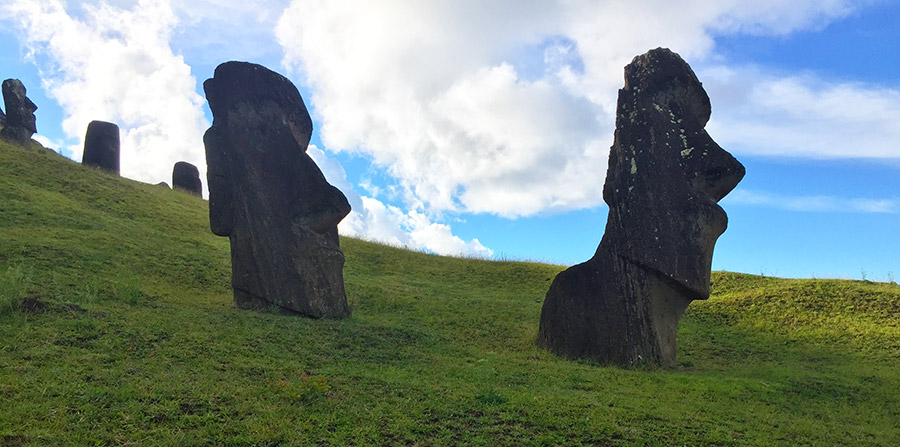
Seeing that photo for the first time I was filled with an eerie sense of foreboding. I had a vivid image in my mind of what it would be like to live on an island so isolated you didn’t know the rest of the world even existed. A chill ran up my spine. For many years to come I wrote this off, figuring that was just a child’s normal reaction to contemplating such a weird and mysterious place.
But it always stuck in the back of my head somewhere, this fascination with what that experience would have been like. And as I grew up, I began to experience incongruous memories that weren’t from my life, of far-away places and long-ago times. Though I was skeptical at first, eventually I was smacked in the face enough times with corroborating details that I couldn’t possibly have known and enough enormous synchronicities that I came to believe in reincarnation. “Believe” doesn’t even feel like the right word, it just became self-evident as the reality of my experience, to where eventually there was nothing to be gained from questioning it any more. In time I noticed a pattern where the things that had fascinated me out of nowhere as a kid usually ended up being tied to a past life experience. It’s funny to look back and realize the odd things I’d written off as meaningless before I had that realization. Every seven-year-old spends a lot of time reading extensively about brain tumors, right?
Occasionally something would spark Easter Island to the top of my mind, like visiting Hawaii and seeing the Polynesian culture there, or watching (and rewatching, and rewatching) nature documentaries about the islands of the South Pacific. I read Jared Diamond’s Collapse and the few other books that existed about Rapa Nui, watched and rewatched David Attenborough’s The Lost Gods of Easter Island documentary about the eerie, starving kavakava figures carved on the island, and the PBS Mystery of Easter Island documentary about the controversy over how the huge Moai were moved from the quarry to their platforms on the coast.
In 2016 I finally got to see a Moai in person, at the British Museum in London, and saw another one that summer at the Louvre in Paris. Standing in front of the broken Moai in the Louve I had an incredibly surreal out of body experience, my entire consciousness vibrating rapidly over the course of fifteen minutes as my body melted away. Damn. I really need to get to this island.
The following summer I began to have vivid memories come back to me of a lifetime on Easter Island. Of standing on a hillside overlooking the island, still heavily forested then, as a storm rolled in off the sea. Swimming deep in the ocean off the coast, with a grace and confidence in the water I’ve never come close to experiencing in this life. Sleeping in a small grass hut and eating with my family around the fire, remembering their faces and how I felt about all of them.
Now I was actually going there and I was nervous. Part of me wanted to wait until I had more complete memories before I traveled to the island, so I’d know where to visit and wouldn’t just be fumbling around, hoping to find something there. But another part of me knew that going there now was far more likely to trigger those memories than meditating in a room thousands of miles away.
But what if I took the time and money to go all the way there and nothing happened? What if I just walked around and it was like “Yep. An island”?
Looking back, I become aware that my life has always been a tug of war between my own analytical, “prove it to me” nature and the bananapants crazy nature of my own experiences. I’ve always been very aware of the ways in which we can fool ourselves and believe what we want to believe, and have always been afraid of becoming one of “those people” who exist in a cloud of their own bullshit. And so I second-guessed and analyzed every odd experience I had. Could it have been this? What if it was just this? A friend once told me I was the only person he ever met who applied the scientific method to spiritual experiences.
Eventually I ran out of alternative explanations and came to accept that I really was experiencing what I seemed to be. In recent years I’ve gradually been overpowered by the vividness of these experiences and have realized that this kind of skepticism is just a way to keep yourself safely small and locked in a box, shutting yourself down before you can experience anything that pushes you out of your comfort zone and challenges your concept of who you are. I’d always second-guessed myself before anyone else could, and that’s a good way to remain a respectable member of society that everyone approves of, but it’s also a good way to get to the end of your life and realize you’ve wasted it.
This has been the hardest blog post I’ve ever had to write, in part because I’m a private person by nature and my experiences on the island were so intensely meaningful to me. But also because I know reincarnation doesn’t fit into the framework of most people’s beliefs. Some odd part of me feels like it’s rude to talk to people about something they don’t think is real, and another part imagines the negative reactions and conclusions of “Well, Sean’s finally lost his shit.” I’m probably underestimating the number of people who reached that conclusion when I was seven. Or when I started talking to a long-dead Japanese monk last summer.
But as the readership of this blog has expanded beyond my friends and family and into hundreds and occasionally thousands of people, I can either crumple into self-consciousness or accept that the point of it all seems to be to challenge myself to share my experiences honestly and completely and let people take from them what they will. If you think it’s all imagination, that’s cool, you do you.
I look forward to the day when these realizations have sunk in bone deep and I can just write, without projecting myself into the head of every person reading this. That sounds like a lot more fun. For anyone finding their way down a similar path, the biggest thing I’ve realized in the last year is that people’s judgments of you generally aren’t about you, they’re about them. Any time someone feels the need to criticize you for something that doesn’t actually impact them, you’ve just triggered something they’re uncomfortable with about themselves. You can’t possibly remember your past lives because they don’t believe they can remember theirs, or that they even have them, or that they could know this for themselves one way or the other. You must be imagining these incredible experiences, because if you can have them, they must be capable of them too, and holy shit that’s a lot of pressure.
At the end of the day, we’re just not that good at caring about other people’s stuff. It’s like the saying “If you’re worried what other people think of you, don’t worry, they don’t.” We spend too much time projecting our own stuff onto other people to really even engage with what they have going on inside them.
This is something I’ve wasted way too much of my life worrying about and not fully understanding. It’s only in recent months that I’ve come to see people’s reactions as a closed loop of them dealing with themselves, and that any energy I invest in that at all is misused. It’s hugely freeing to realize this.
Now sink in, dammit.
Fresh off the plane and walking up the street on Easter Island, I was very quickly overwhelmed by the feeling of being home. Every year when I return to California for Christmas, on the drive from the airport I’m always caught off guard by the sudden feeling of safety and warm nostalgia that rushes in the second I start to recognize the scenery around my home town. I felt a much stronger version of this same feeling walking up the street in Hanga Roa, only I’d never been there before. The emotion of it completely overpowered me.
I’d hoped, at best, that a few more memories might come back to me while I was visiting the island. I had no idea I’d be diving right into in a vast sea of emotions that I’d be surfing the entire time I was there. I’m a pretty abstract, analytical person, barring an ugly breakup or the end of The Iron Giant, a graph of my emotional state is generally a flat line pegged right at “s’all good.” Now all of a sudden I was living in an Italian opera.
“How was Easter Island?”
“I cried a lot!”
“…oh.”
“It was great!”
I spent the first afternoon just wandering around the town in a daze, aimlessly. I felt the vibration of the island sinking deeper and deeper into my body, an unwinding and a slowing down after my hectic travels.
I stopped at the first Moai I saw and practiced my best Moai impression:
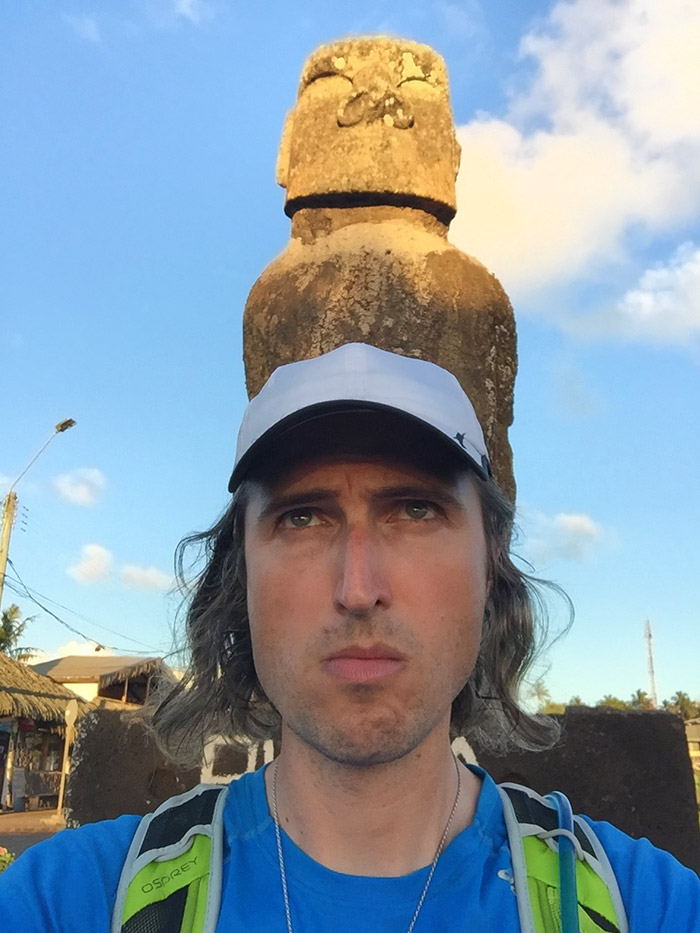
I sat down on a bench at a small park on the beach and watched the ocean roll in. Wow, the feeling of this place is really sinking into my bones. I mentally tuned into my guide Kobo Daishi. He said “You belong to this place, and it belongs to you.” This pretty much dropped a Hiroshima bomb of emotion right on top of me. Holy crap. A deep well of emotions lurched inside me, excruciating and sublime at the same time, and spilled out. Wow. Okay, so I’m just going to be weeping openly the entire time I’m here, that’s cool.
I walked up the coast past the Moai on Ahu Tahai and found a hidden bench to sit on. I took out my map of the island and tried to figure out what the hell Ahu Tongariki and Puna Mao Mao were and what I wanted to see first. In time, locals began to show up, car by beat-up car, eager to have a family BBQ in this same choice spot overlooking the ocean.
A little girl from one of the families walked by me and then turned to her family and whined (in Spanish) “Awww, but there’s a white guy here!”
My Spanish acumen increases tenfold when I’m being insulted. Caballero blanco indeed!
Damned kids today, never respecting their probable ancestors when they’ve been reincarnated and returned to the island as white people. Typical.
I laughed as I thought of all the dead Rapa Nui returning, white as ghosts, to haunt their progeny as tourists.
I ceded my spot to the local family and continued my wander around town.
Echoes of my past life began coming back in odd and unexpected ways. Every time I heard one of the locals speaking Spanish, it felt jarring and odd to me. I wasn’t sure why, since I’d been hearing Spanish all day every day for weeks at this point. And then I realized that when I had lived here before, everyone would have been speaking Rapa Nui instead. The faces looked the same, but now they were speaking the conqueror’s language. Gross.
All around Hanga Roa I’d see families walking with a dog and think “Oh that’s nice, they’re out walking their dog.” Gradually I realized it was actually just a stray dog that was following them. Then it starts following you.
People were being followed by three dogs they smiled at once or dropped an M&M in front of weeks ago, like Scrooge’s Christmas ghosts.
The sheer number of stray dogs on Easter Island was amazing and hilarious. They were everywhere. Whenever a café had customers, the owner would come out to the sidewalk and stamp her feet and clap to shoo away the dogs napping there, so the paying customers would have somewhere to sit.
The dogs were all sweet and had hilarious personalities. Sitting in front of a coffee shop one day, I looked down and this old, scruffy dog looked up at me with a squinting face that clearly and perfectly said “Can you believe this shit?”
The only thing the dogs didn’t like were pickup trucks, which they would reliably attempt to murder every time one drove up the road. They totally ignored the local dudes on motorcycles who would just drive back and forth up the main strip all day, popping the occasional wheelie because they had nothing better to do.
The entire time I was on the island I had the eerie feeling like I wasn’t on a trip. Normally you have a sense of being off somewhere exotic on vacation and that one day soon you’ll return back home. But on this trip it was flipped. It felt, intuitively and unshakably, like I was already home, and that in a few days I’d be leaving home on a trip to visit the United States. It was weird as hell.
I spent the first few days thinking I could definitely move to the island, then by day five or six the extremely small size of the island had sunk in and I realized that after a month I’d just be riding a dirt bike up and down the main strip all day, learning to pop wheelies.
The sheer number of stray everything on Easter Island was amazing. Dogs, horses, cows, just wandering around. Nothing seemed to belong to anybody. There was a nice free vibe to it all.
I made my way back down to Ahu Tahai and watched the sun set the sky on fire.
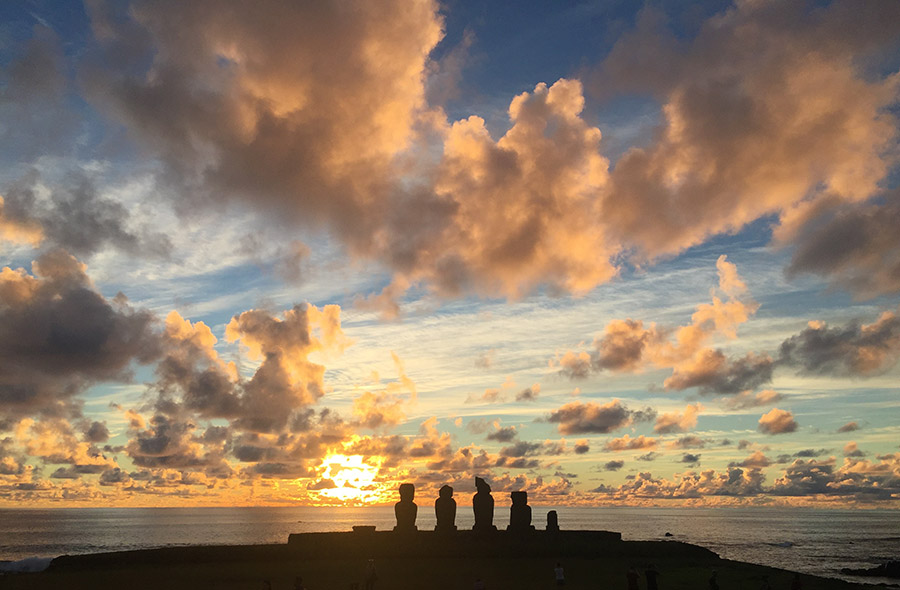
The first settlers came to Rapa Nui from Polynesian islands far to the west some time between 200 and 1200 A.D. That huge range of dates reflects how little historians can agree about what the hell happened on Easter Island pretty much at any point before right now.
I’m amazed by the thought of this original group of Polynesians just going balls out in tiny canoes, across hundreds of miles of open ocean, with no idea where they were going, just in case there was anything out there.
Through chance and skill both they hit this speck of land, landing on Annukena beach on the north coast, pretty much the only sandy beach on the entire island. From there, the civilization spread and grew for hundreds of years. In time, an elaborate culture of ancestor worship developed. Moai statues were carved in a volcanic quarry inland and then transported to ahu platforms along the coast. When a Moai was stood up on the platform, it was finished and fitted with coral eyes, and it was believed at this point that the Moai was infused with part of the soul energy left behind by a departed ancestor. This soul energy would live forever in the stone, both protecting that person’s descendants and allowing the family members contact them for guidance.
As the Moai culture progressed, eventually it turned into an arms race of competitively carving larger and larger Moai. At the time when the Moai production mysteriously stopped, seemingly overnight with nearly 400 unfinished Moai in the quarry and tools strewn on the ground like the work whistle had just blown at the end of the day, there were over 900 Moai spread across the island.
Some time after the first visit from the Dutch in 1722, the Rapa Nui civilization utterly collapsed. By the mid-1800s, the island’s population had dropped from as many as 20,000 people to under 100. During that time the ancestor worship culture gave way to the Birdman cult, and then inter-tribal rivalries that resulted in cannibalism and tribes pushing down and smashing each other’s Moai until there were none left standing on the island at all. All of the Moai standing on the island today were pieced back together and stood up by archeologists from Europe and South America in the 20th century.
The classic view of the island’s devastation is that the Rapa Nui cut down all the trees to make sleds for transporting the Moai in their Moai-building mania, leaving them without the materials to make canoes to fish with. And so they starved to death. This has made the island a popular symbol worldwide as a microcosm of the Earth and what will happen to us all if we ignore global warming, etc.
This “over-consumption killed them off” view has been complicated by more recent evidence that the palm trees that once covered the island were done in at least in part by rats, who ate the palm seeds, preventing the trees from reproducing. Other researchers have found evidence that the population was killed off not by self-imposed ecological collapse and starvation, but by syphilis and smallpox brought by the first European visitors. Also, the Peruvians came in 1862 and took a third of the island’s population away as slaves, which didn’t help anything.
Scientists are currently split between the “You Boneheads!” and “Oops, Sorry, Our Bad” camps.
My first morning on the island, the roosters woke me up at WTF-o’clock. Easter Island is in a bizarre time zone unrelated to its geographical position, for the sake of staying relatively connected to mainland Chile far to the east. So the sun comes up around 9am at the earliest, which would be bitchin if the roosters didn’t still wake up loudly at 3am. I was staying in a quaint little cabin in some lady’s backyard, and some lady had an unquantified number of roosters who seemed to love nothing more than hanging out beneath my window, screaming. In my hazy semi-consciousness I managed to fumble the window shut, which inspired one of the roosters to climb up onto the roof of my cabin right above the window, crane his head down over the edge, and scream into the eaves to make sure I was okay.
The sounds of Easter Island were unique and never-ending, from the Kari Kari island dance show next door that thundered on late into the night every night, to the church bell in town that played songs in the pitch black at 7am and again at various times in the evenings. I spent a good chunk of my time on the island trying to figure out what the songs were, as I couldn’t imagine the church bell was really playing “Farewell My Love” and “Let Me Call You Sweetheart,” and yet I kind of wanted it to be true.
Once the sun had casually stumbled in and apologized for being late, I walked the half block from my extremely centrally-located cabin to the car rental place the guy who picked me up at the airport had told me had the best rates in town. The entire operation was one dude sitting at a desk, farting around on YouTube.
I had been planning on bicycling around the island, but after hiking across Peru and managing not to die on a bike in Bolivia, I was tired and this all seemed like less of a great idea. The next least-expensive option was to rent a scooter, which seemed appealing except for the fact that I’d never been on a scooter before. How hard could it be? It’s not like there are shit-tons of stray dogs everywhere, the constant threat of torrential rains, random cows in the road and massive potholes everywhere. Oh, wait, yeah, there are all those things. Maybe I’ll just rent a jeep.
The rather casual car-rental routine went smoothly until the guy asked me to write down the address where I was staying. I had no idea since I’d been picked up at the airport by the lady’s nephew, holding a sign with my name spelled hilariously wrong on it. One of my biggest surprises on the entire trip is that no one in South America has ever encountered the name Sean before.
I pulled out my phone and looked at the AirBnB listing. No address. Hmmm. I showed the car rental guy and he frowned. Then I described where the cabin was in extremely vague terms (“I turned left and walked by the dog sleeping under the Coke sign.”)
“Oh! You’re staying at Jackeline’s place. She’s like my aunt. Sort of. She’s my friend’s mom.”
He wrote “Jackeline’s House” as the address on the rental form and I pulled away in my little jeep, off to explore the island.
My first stop was the small quarry at Puna Pao where the red rock was mined and used to make Pukao for the Moai. These are the round red “hats” you sometimes see on top of the statues, thought to represent long hair pulled up in a topknot.
The drive to Puna Pao was absolutely gorgeous. Driving up the tree-lined lane, the sun shone through the flowering trees and I was again overwhelmed by the feeling of familiarity and love. The whole thing felt like a fuzzy memory coming into focus and I was continually choked up. Stopping at the parking lot for the quarry I looked in the rear-view mirror and was startled by the light reflecting in my eyes. Often after a long meditation or a particularly spiritual experience you can see people’s eyes almost glowing, and I hadn’t seen mine like this since after the sweat ceremony on the reservation last December.
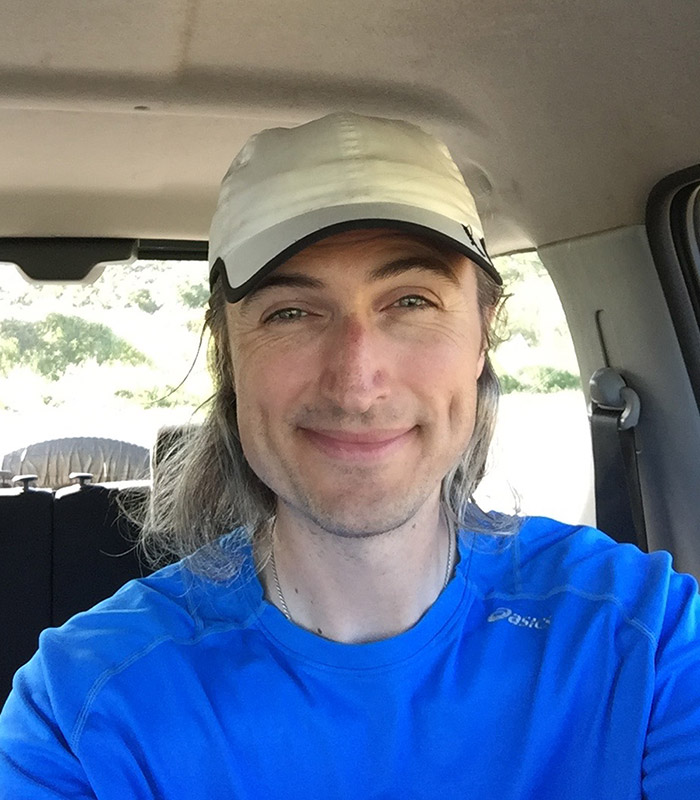
Getting out of my jeep, there was a puppy waiting for me at the back hatch.
“Where we goin’?” asked the puppy’s upturned eyes.
Okay, so now I’ve got a dog following me around. They should hand these out at the airport instead of the leis.
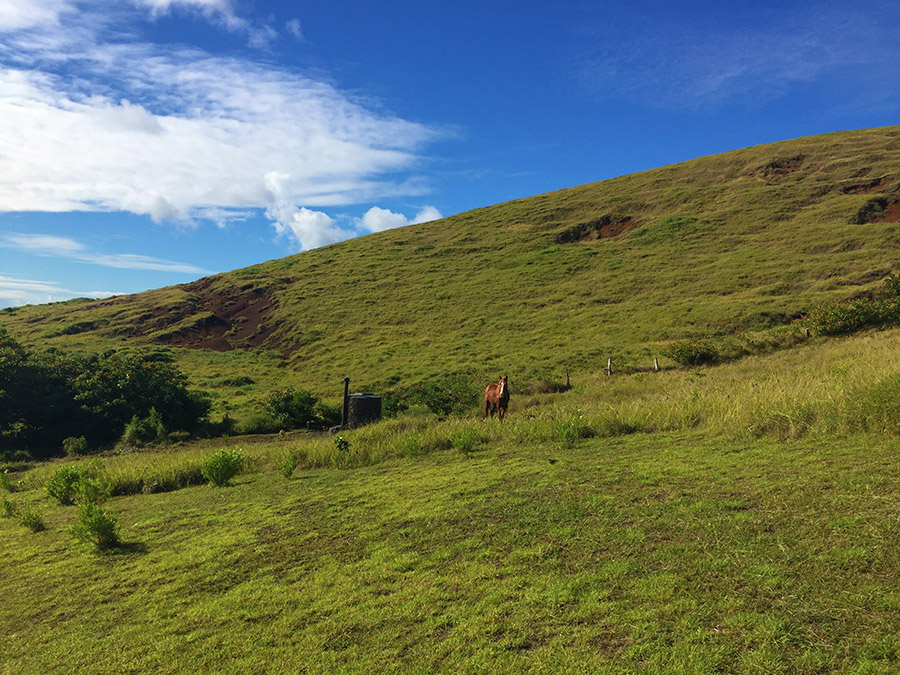
The view from the top of the volcano where the quarry was located was beautiful, the island rolling out peacefully in all directions.

After Puna Pao I made my way (sorry puppy, you have to stay here) to Ahu Akivi, the only platform on the island where the Moai are facing toward the sea rather than having their backs to it. This has raised all kinds of theories, from the seven Moai representing the first seven explorers who landed on the island to these Moai looking west into the afterlife and contemplating the beyond. Some have argued that the Moai just always faced the village, looking over the people living there, and that at one point there was a village between Ahu Akivi and the sea. Now there’s just a patch of woods full of horses looking at you like “What? WHAT.”
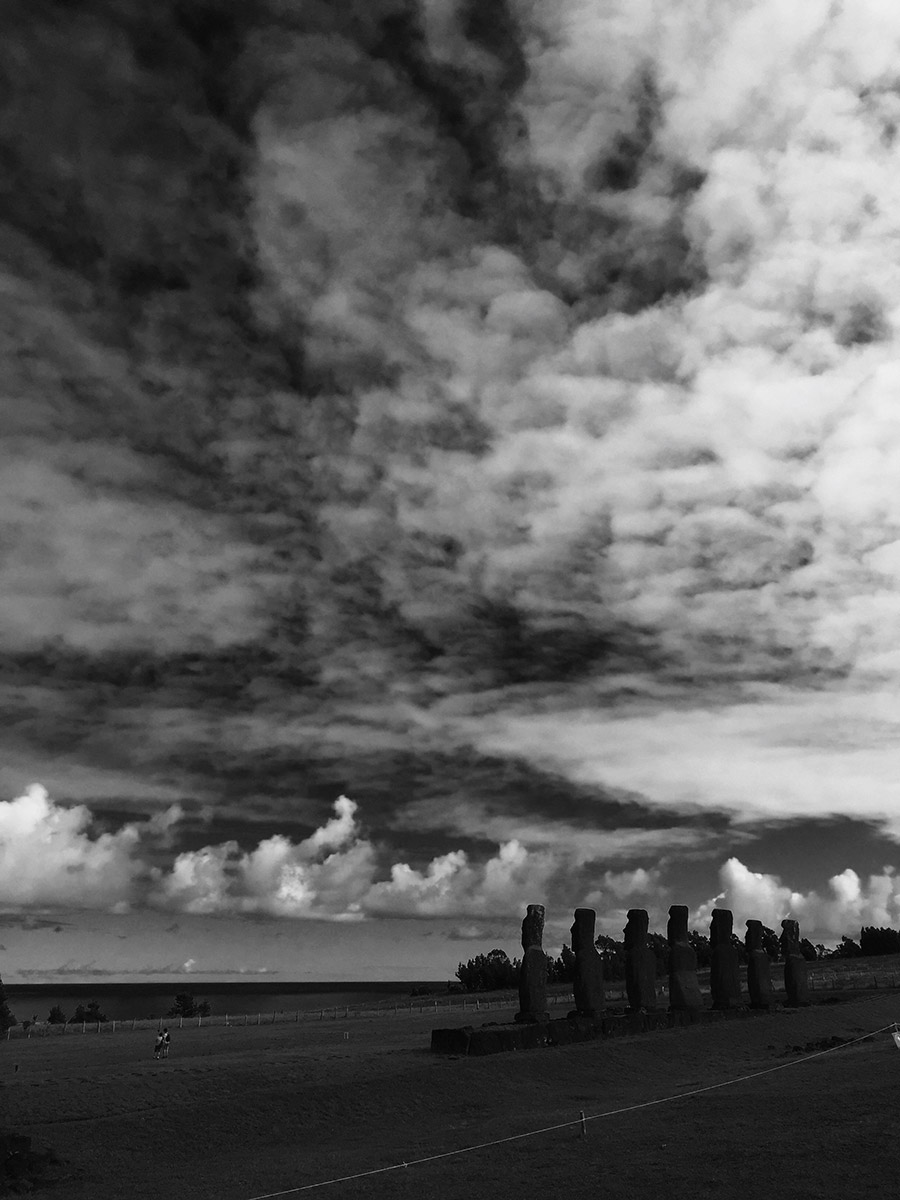
Near Ahu Akivi the trail to hike up to Terevaka begins. This is the highest point on Easter Island, at the top of the island’s largest volcano. I left my jeep and set out on foot for the few hours it would take to hike to the top.
Walking up the dirt path, past fields of wild grass and horses that were never taught it’s rude to stare at people, it suddenly dawned on me that I had a body buried somewhere on the island, from that past life. Who knows, at any point I could be walking over my own skeleton moldering down in the ground. Weird.
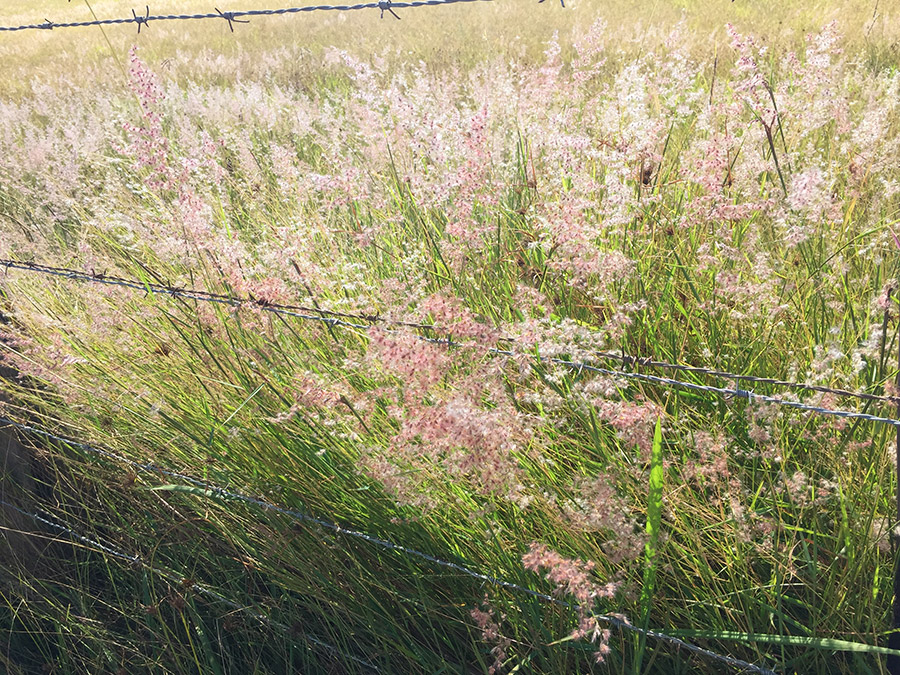
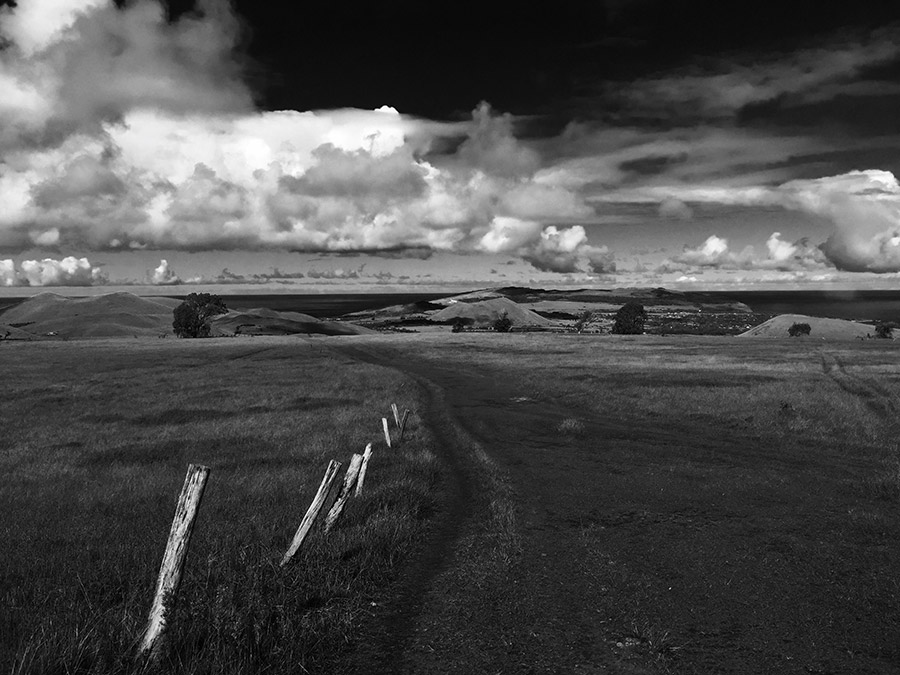
I have a friend who has a theory that as you travel through life, visiting new places and meeting new people, you gradually pick up pieces of your soul you didn’t know you were missing. This felt like that.
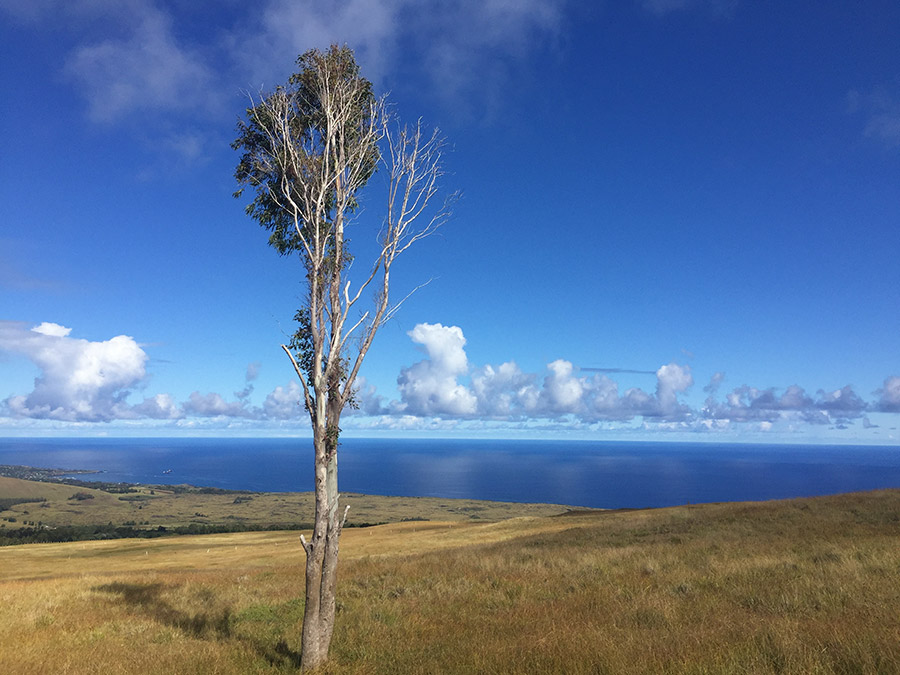
Up at the top of Terevaka there’s a small sign and a large pile of sticks.
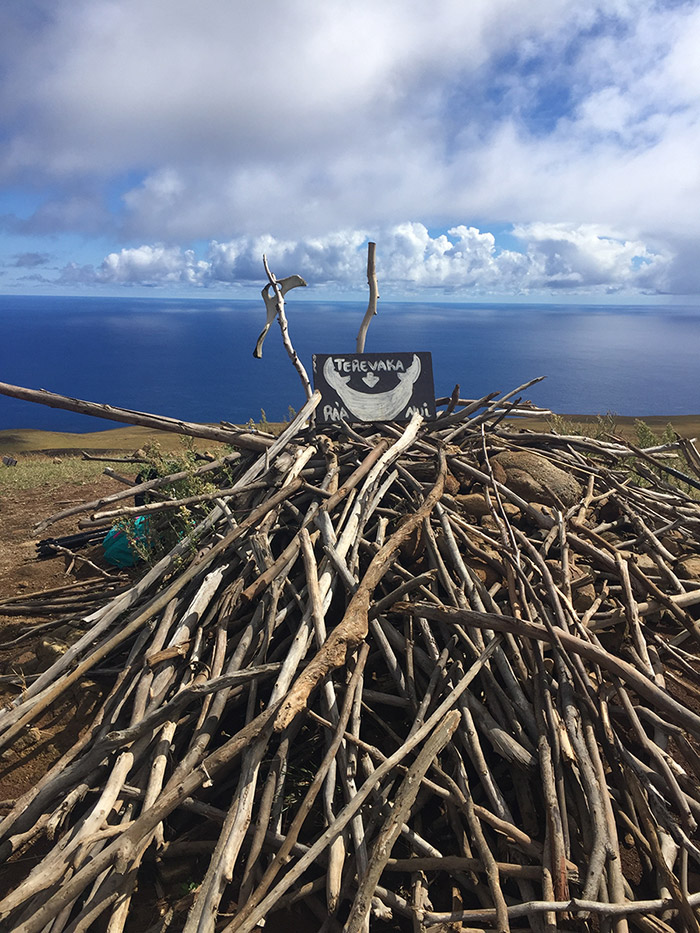
From this point you can spin around like Julie Andrews in The Sound of Music and see the ocean around you on all sides, the entire island at your feet. Nothing brings home how far you are from everything else in the world like seeing endless ocean in every direction, 360 degrees all around you.


After sitting and contemplating this for a while, I headed off the trail and hiked over to a grove of eucalyptus trees that were perched mysteriously in the distance. On an island famous for having no trees at all, it feels bizarre to hike through a forest.
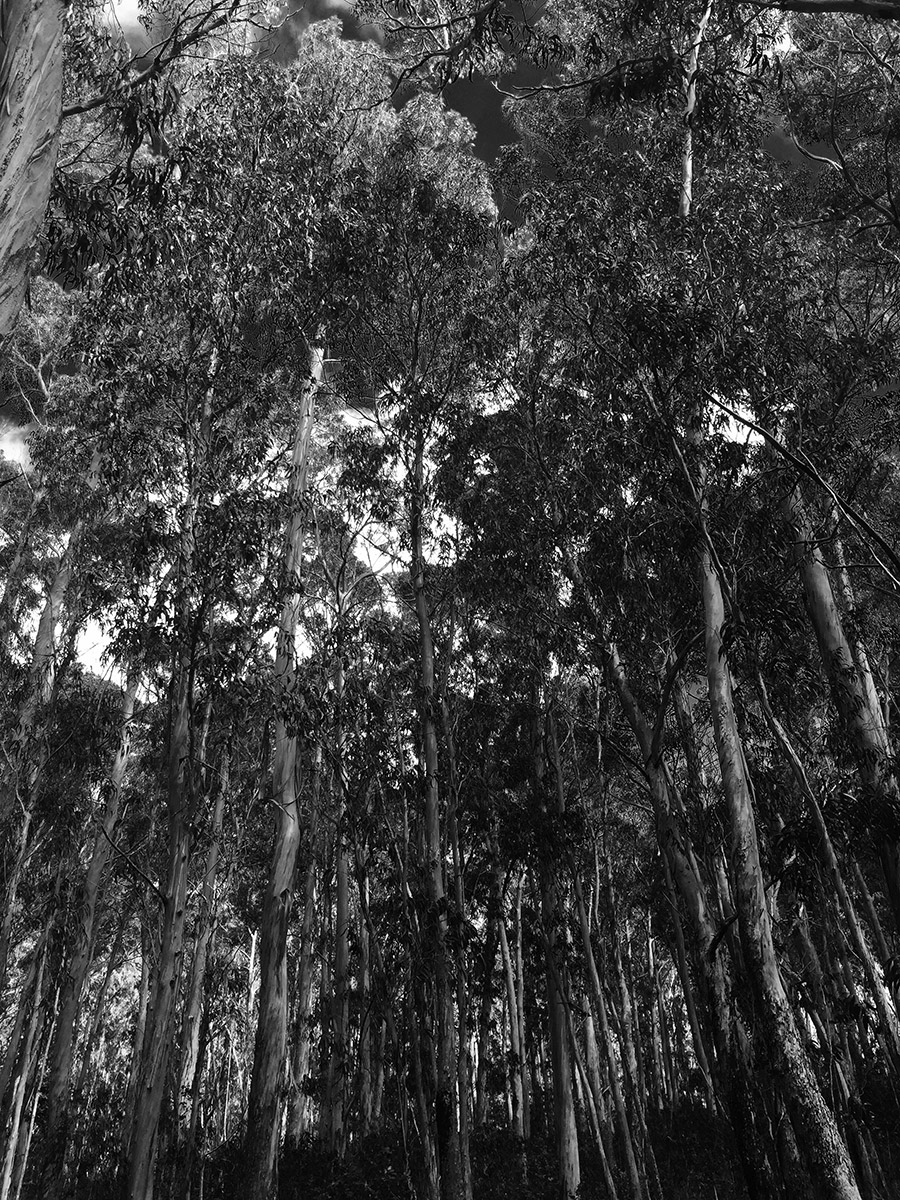
Coming out the other side, I spied a lone tree up on the hill and hiked up to sit beneath it, on its impressive zigzag of roots splintering off in every direction.
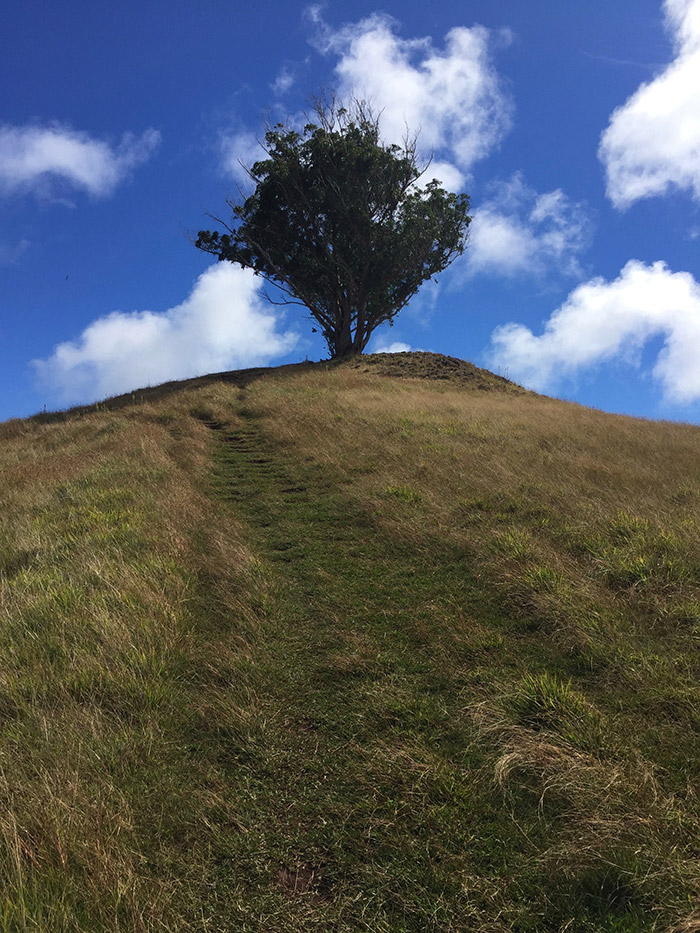
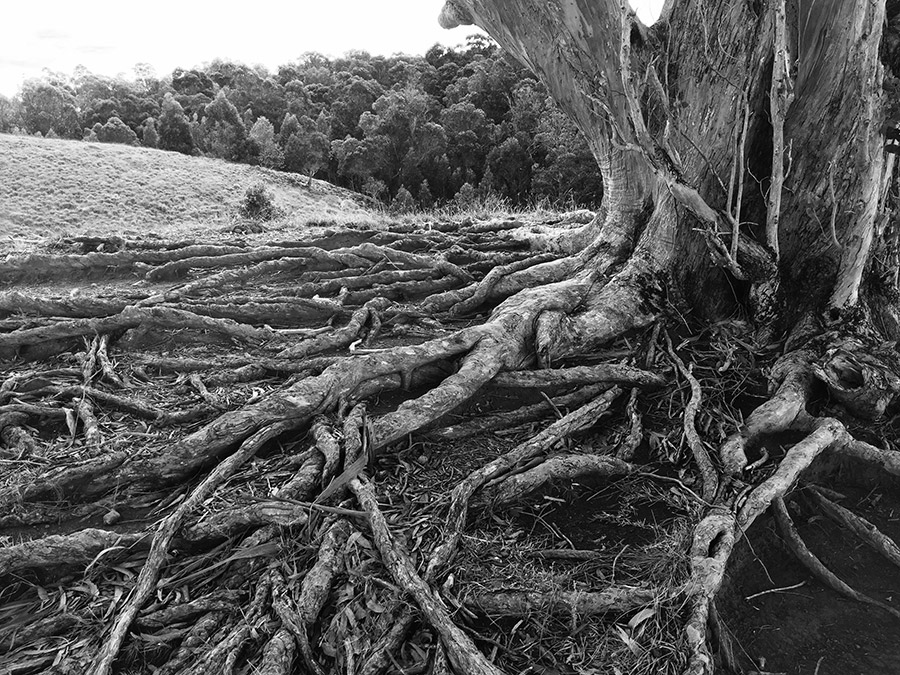
On the hillside at my feet, hundreds of dragonflies dodged and weaved in the breeze, creating a magical scene. Further below, the entire island spilled out before me. I could see Hanga Roa way off in the distance, at the island’s far end.
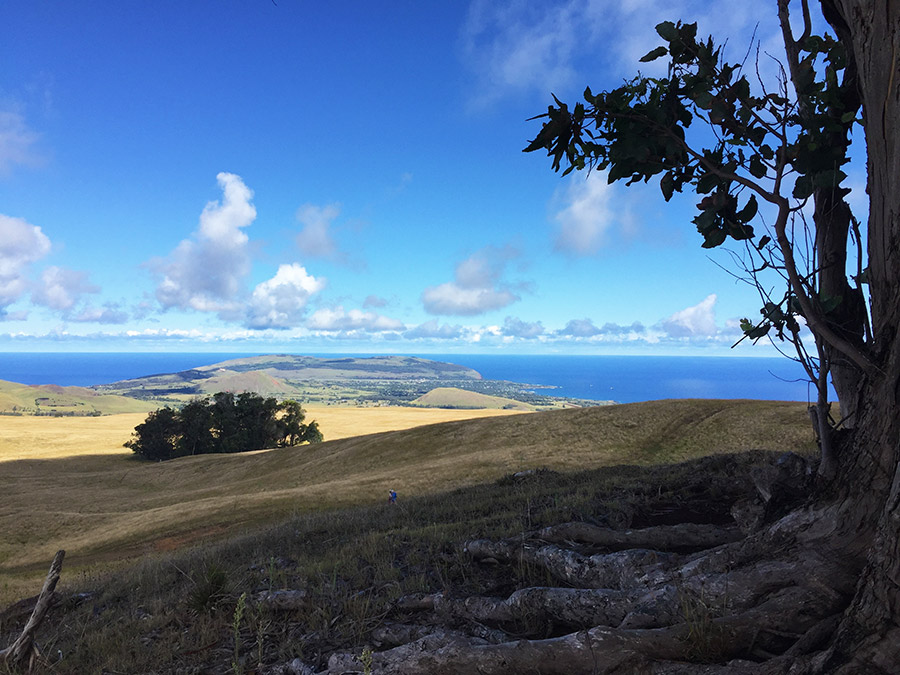
Sitting there, images started to pop into my mind as memories came back to me. I remembered being a little boy sitting in this same spot, looking over the entire island and wondering what was beyond the water. Pictures and emotions began to swell in. I felt very lonely and wondered if I hadn’t had any siblings in that life. Or did that boy have some awareness that there was much more to the world he’d never see, stranded on an island in the middle of the Pacific? Maybe some vague memories of lifetimes before that one, or just an intuitive knowing that there was more.
I thought about that little boy dreaming of the rest of the world and laughed as I realized it made perfect sense for me to be drawn back there now, in this lifetime where I’m traveling the entire world. This life is like that little boy’s dream come true. Wow.
Some people believe that our lives all exist simultaneously and eternally, which made me wonder if that boy and I were tied together in that moment, sitting in that same spot hundreds of years apart, leaving him feeling a little less lonely.
I hiked back down the slopes of the volcano to my waiting jeep.
From there I made my way to Ana Te Pahu, a series of caves in the lava tubes beneath Terevaka. At various times these caves were used as homes, water reservoirs, and places to hide when the Peruvians visited the island on slave raids. The entrance of the caves forms a natural nursery full of banana and avocado trees, protected from the wind. Inside the cave, man-made stone barriers would have forced invaders to enter one-by-one, making them easier to hit in the head with a rock. Bees swirled around inside the dark cave as the sound of water dripping echoed off the cave walls.
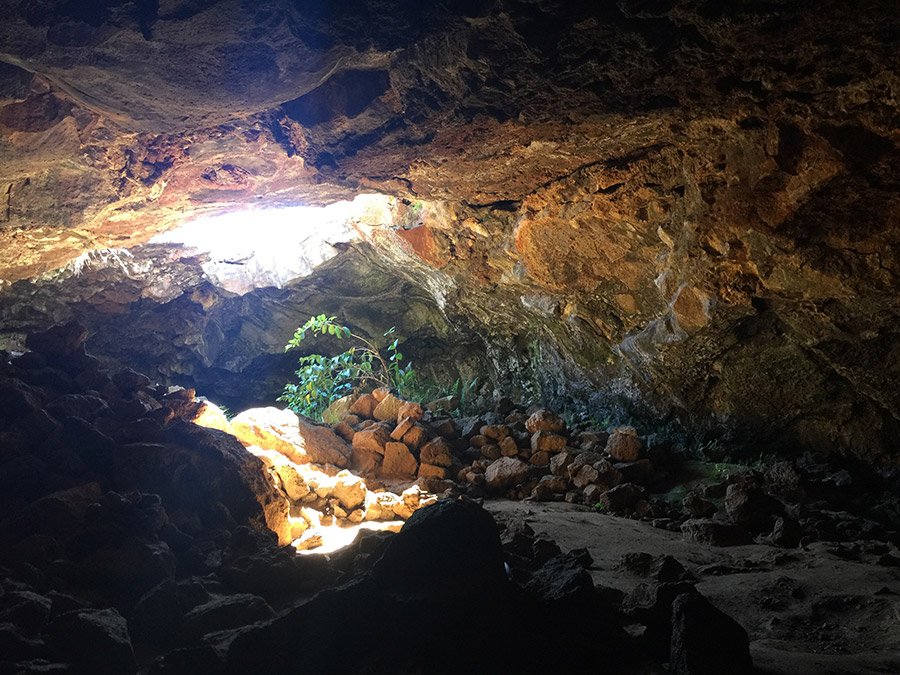
From there I hiked to Ana Te Peu, an isolated Moai site on the west coast of the island that doesn’t get many visitors, due to its location and the only road being closed. I only had to share it with a few wild horses.
Ana Te Peu has not been restored, and what remains is how the ancient villagers left it. I walked past the foundations of several “boat houses” (thatched huts with a stone foundation built in the shape of an overturned canoe) including the largest one on the island, thought to have belonged to the king of the island and where he carved the first Kava Kava figure. Nearby there was a chicken house, a low stone structure the Rapa Nui would herd their chickens into at night so they didn’t wander away or get themselves stolen. One of the irregular stacked rocks that made up the structure was the “door” which could be pulled out. Only the owner would know which one, preventing theft. The chickens had to be trained to follow the daylight out the door when it was removed in the mornings.
Nearby, stone rings had been built to protect saplings and other crops from the wind.
The main attraction, however, which the horses and I were there to see, is the Ahu Te Peu, the large platform where the Moai once stood. Most of the structure of the platform was still standing, but in front of it lay the shattered remains of several Moai. Bodies strewn at odd angles, heads snapped off and looking up at the sky, half-buried in the rubble.
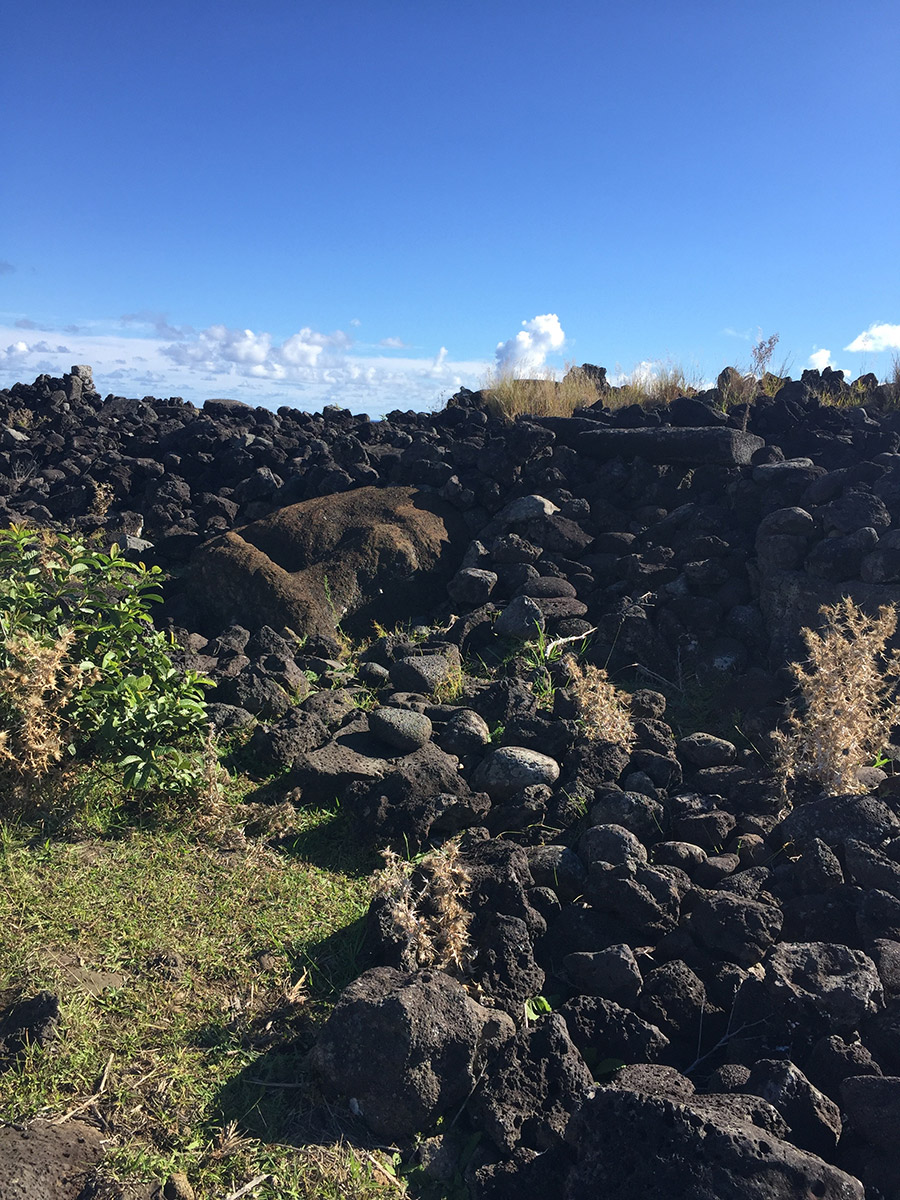
I was caught completely off guard by how incredibly sad seeing all of this made me. I had approached the site with the normal tourist mindset of seeing something interesting from a forgotten culture, to learn and take a few photos. But seeing the broken Moai, I felt completely devastated. It felt like someone had shit all over something I held sacred. It wasn’t a mental experience, like “Oh it’s so sad this culture collapsed and it would be nice if these statues were standing up.” It was a deep feeling of being personally offended, like someone had kicked over your mother’s gravestone. Only it was worse than that, it was like this actually was my mother somehow. I realized that if I had lived here while the culture was at its peak, this was my first time seeing it in ruins. It was really hard to stand there and look at it all. My heart was broken.
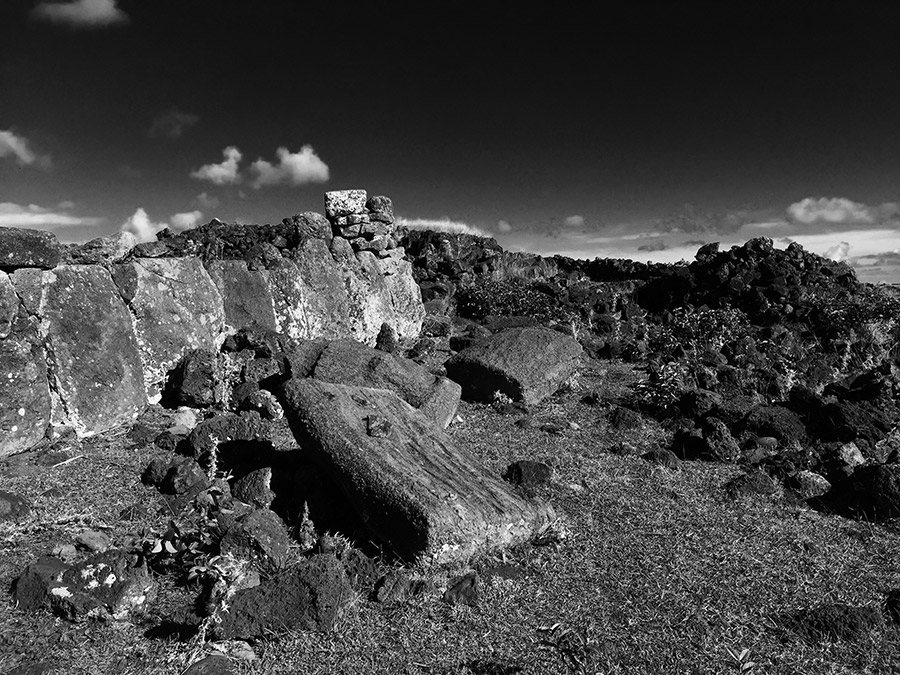
I made my way back to the beach in Hanga Roa and quietly watched the sun set.
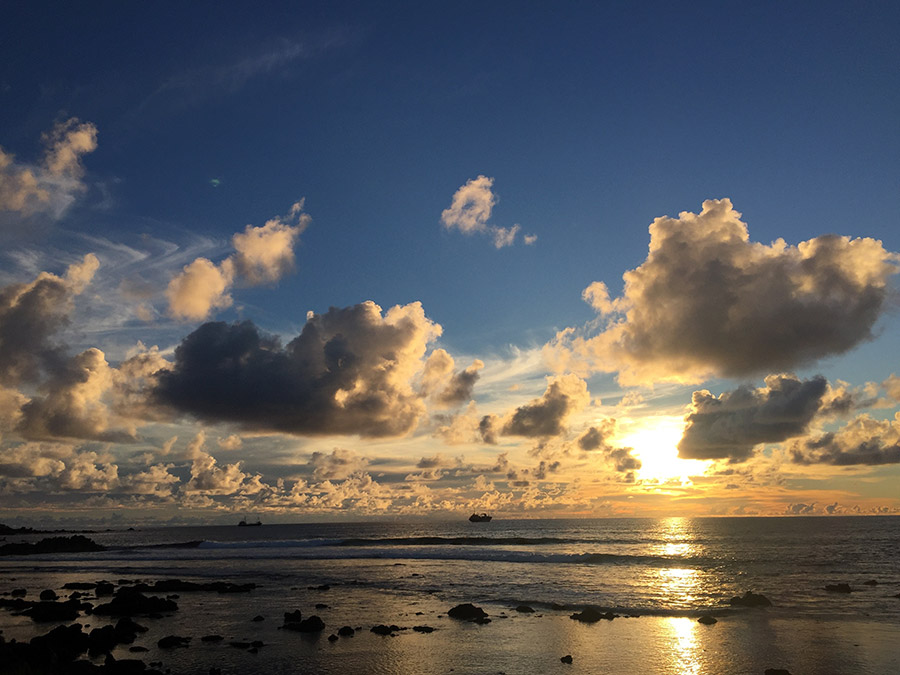
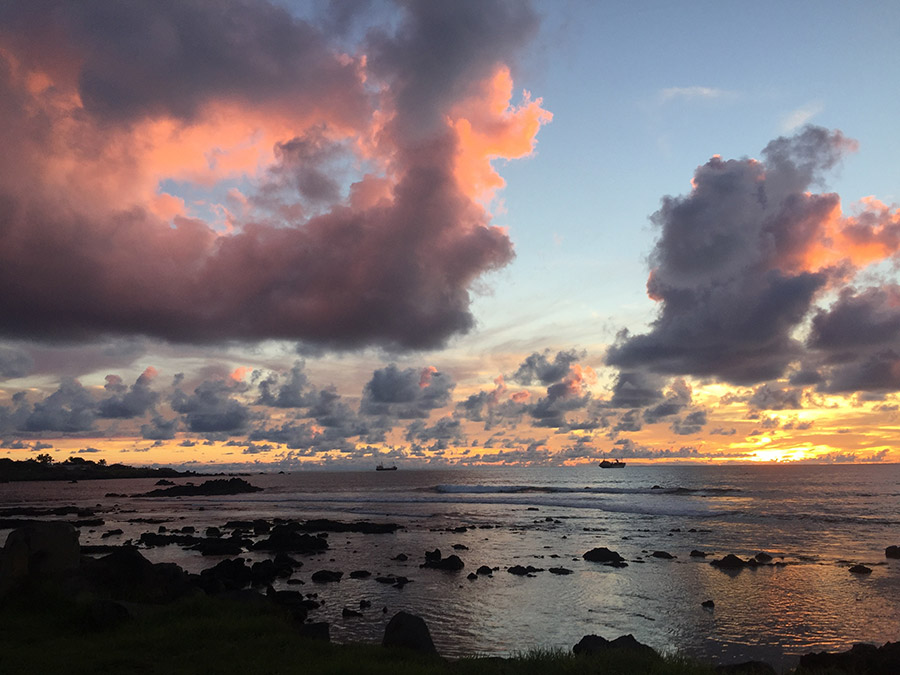
I woke up the next morning to the sound of roosters running around on my roof and the Japanese tourists in the next house over moaning “Oh God shut uuuuuuuuuup” at the crowing roosters, who crowed in response.
I wanted to see the sun rise at Ahu Tongariki, the island’s largest ahu, topped with fifteen restored Moai. I set out in the dark in my jeep, cruising through the empty streets to the main highway that runs up the east coast of the island. I was on the lookout for horses in the road, not wa-BABAAAAAASH!!
Oh Jesus I just hit a speed bump so massive it might have actually been a bridge for dogs. I was going 50 miles an hour. My jeep lurched violently into the air, then scree scree screed to a stop at an awkward diagonal angle up the road. Wow. Sorry jeep!
I hoped the guy wouldn’t look up from his YouTube videos when I returned this thing.
After the GPS on my phone was able to pick up where the jeep had landed, Google Maps figured that hadn’t been adventure enough and tried to take me on what I’m sure was the shortest route by distance to get to the ahu, which involved snaking up perilous cliffside coastal roads that looked like shitty hiking trails. In the dark. In a place I’d never driven before. Okay, yeah, this is insane. I backed up all the way to the main road and took the highway instead.
Shockingly, I was not the only person to have this “sunrise at Ahu Tongariki” idea. And so I got to take in the sunrise with a couple hundred of my closest friends. Clearly, every tourist on the island was there. I wondered if any of them had achieved sick air off that speed bump, too.
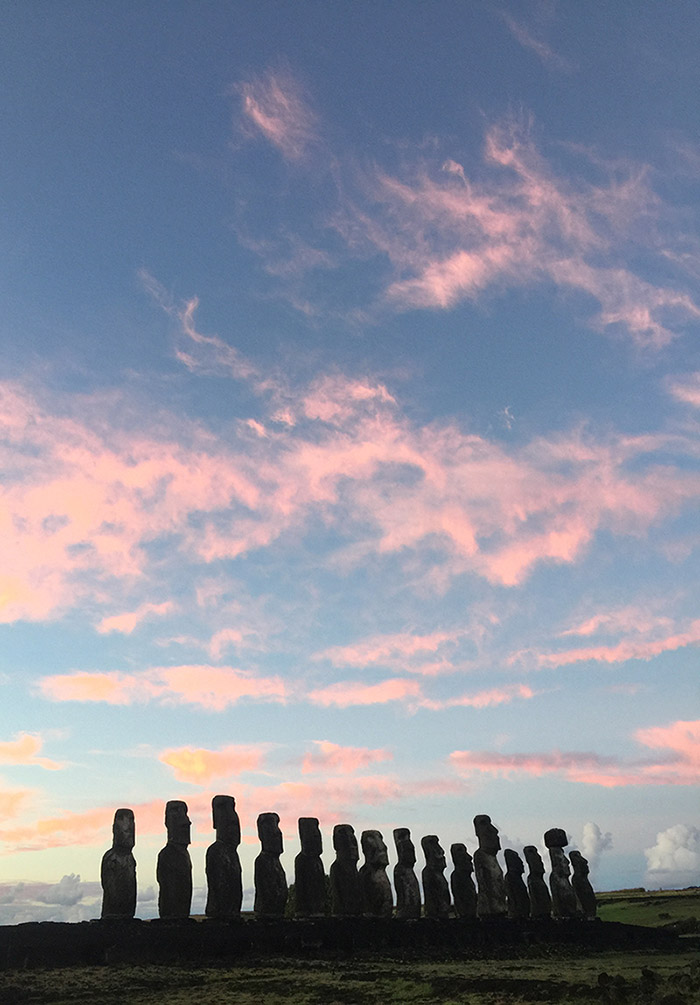
An obnoxiously blonde woman in a baseball cap had obnoxiously set up a gigantic camera on a tripod right in the middle of everything, like she was the only person there, and was tsk-tsking anyone who tried to get into position to take their own photos. She had done the same thing at sunset at Tahai the night before. I really need to get off her schedule.
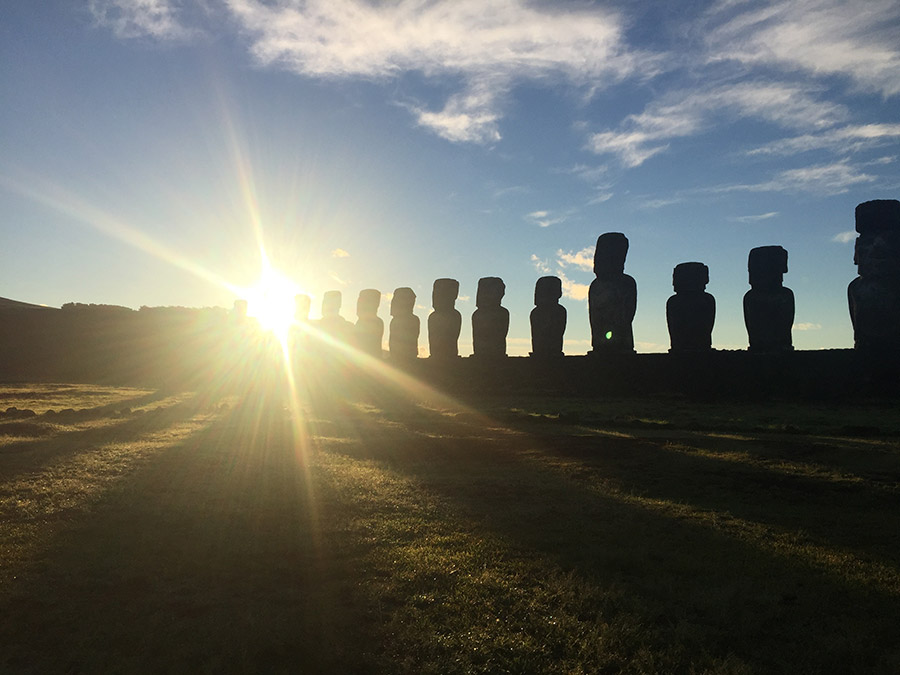
The biggest trick on Easter Island is figuring out the tour bus schedules, and making sure you’re not wherever they are. The vast majority of the people who come to Easter Island come for two days and zip around on tour buses, hopping off for ten seconds to take a selfie in front of a Moai and then darting back into the air conditioning and off to the next selfie spot. There were quite a few Japanese tourists doing this, which didn’t surprise me since I knew the Japanese have a particular fascination with Easter Island. One of the sites I’d had to drop off my itinerary in Japan due to time was a spot on the Japanese coast where they’ve erected several fake Moai in honor of Easter Island.
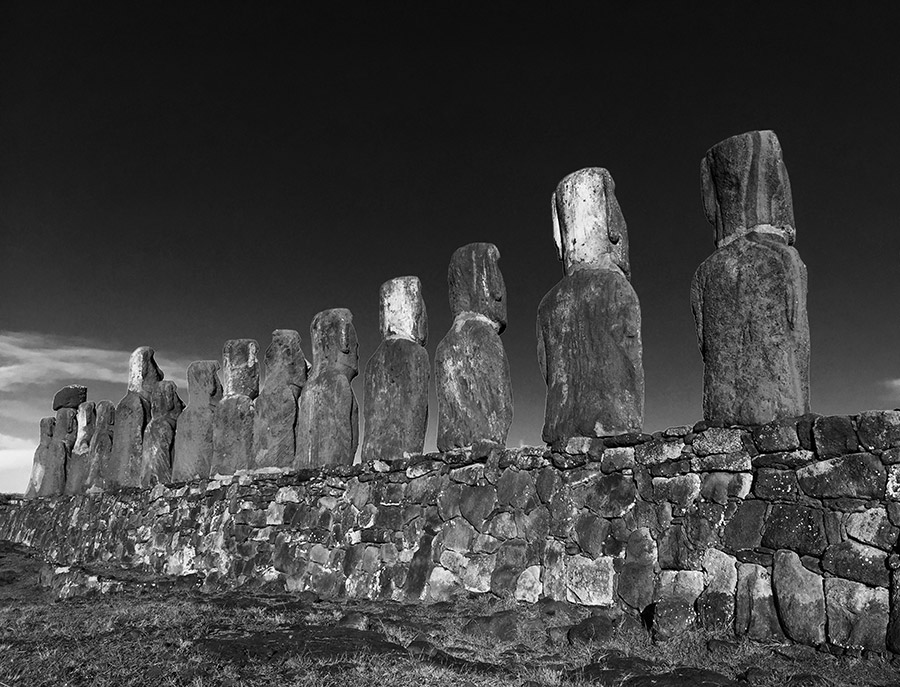
Near the entrance to the site there stands a single statue, the Traveling Moai. This was the statue Thor Heyerdahl used in his experiments to try and figure out “how the Rapa Nui moved these goddamn things” to quote words I just made up and assigned to him right now. This same Moai was lent to Japan for the 1970 World’s Fair in Osaka, as a thanks to the Japanese company who donated the crane that was used to stand up all the Moai here at Tongariki. Now he’s back, and all the other Moai pretend to humor him every time he tells the same stories over and over about “that time I went to Japan.”
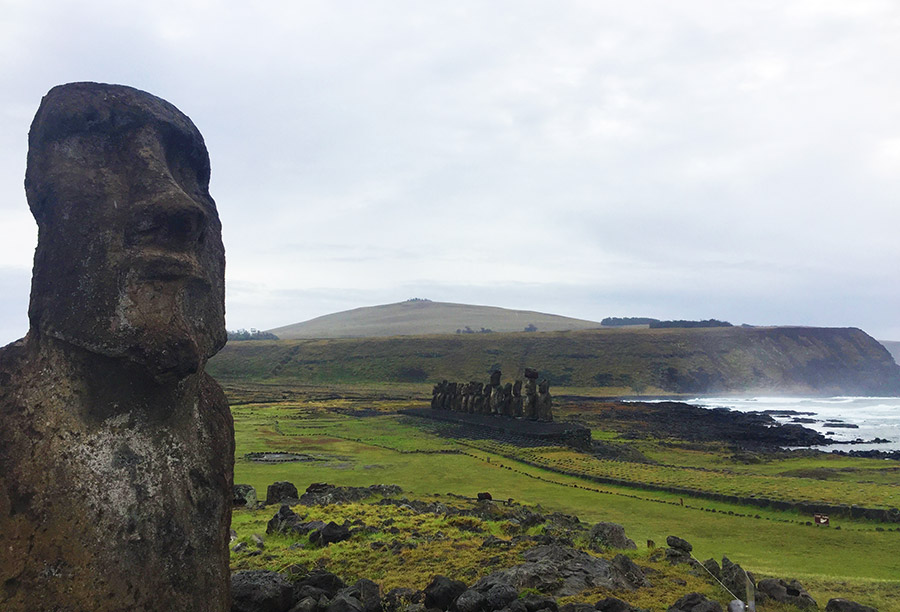
The Japanese tourists were joined by a healthy contingent of Chinese and more than a few Chileans. Everyone just seemed to be into it for the Moai selfies. I sat quietly on a rock and waited as the throngs of people cleared out, their selfie sticks telescoping back down and their babies wailing to greet the new day. Before long I had the entire place to myself.
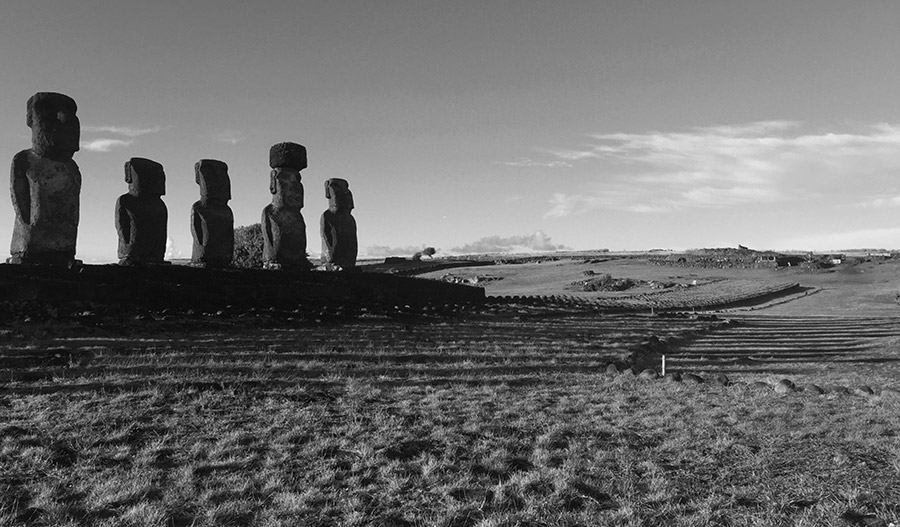
I sat and meditated, looking at the fifteen Moai and clearing my mind. As I took in each one, my eye kept returning to the second one from the right. Hmm. Is there something special about this one? My mind tried to logic it out, as I thought about how it was less eroded than some of the others and it was the only one with the topknot still intact. That must be why I’m feeling drawn to this one. Hmm. I stared at that Moai some more.
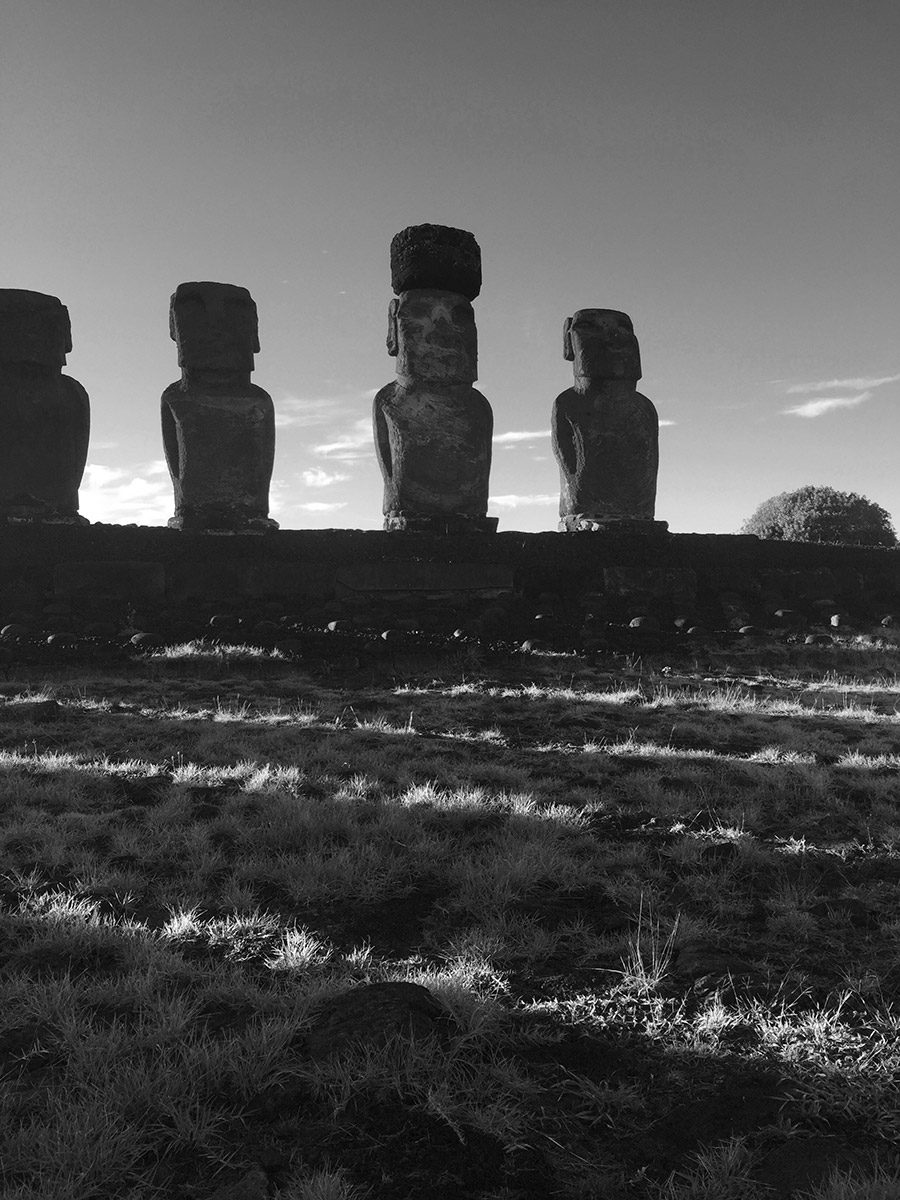
And then I suddenly burst out crying. Oh wow, okay. What’s this? I had no method to logic this reaction away, something was coming up from deep inside me. I cleared my mind and looked at the Moai again.
Images flickered into my head and I began to remember. This was the Moai of my grandfather from when I had lived on the island. I saw him as he had appeared when I was a boy, memories coming back of all the times he looked out for me. I was filled with such a feeling of love.
Then I began to hear his voice in my head, softly. He talked about how I have so many ancestors and guides watching over my life, so much help is available. He said I could tune into him any time I needed, like I’ve been doing with Kobo Daishi ever since my trip to Japan. Wow.
The longer I looked at the Moai, it started to appear more and more feminine to me, subtly curving and morphing before my eyes. I thought this was odd since all of these Moai were statues of men. But the longer I looked, my mind cleared and I realized it was morphing into the image of my grandmother from this life. And I quickly saw that the soul of my Rapa Nui grandfather had reincarnated as my grandma who raised me. I had a hard time believing this at first, but a few nights later I had a very vivid dream that I was at a museum on Easter Island and they wanted me to donate an album of my family photos. And as we opened the album and looked through the pages I realized my grandmother and some of my other family members on her side were all figures from Rapa Nui history.
As I sat in front of the row of Moai, my eyes wandered from my grandfather over to the tallest Moai a few statues to the left. Hmm. This guy’s interesting. Do I know him? I let my eyes go soft and cleared my mind again. Suddenly a louder voice in my head said “Be proud of yourself.” Huh! This hit with more weight than I would have expected from such a simple sentiment. I tuned into the Moai again, and the voice spoke again. “You are forever.”
In that moment something shifted inside me and I moved into another state of consciousness where I saw and experienced that I exist outside of time. This is a concept I have mentally understood for a long time, but in this moment I actually experienced it for the first time, which is a huge difference. I saw that there was no need to worry about any of the things I’d had pressing on my mind. About if I was going to be able to see everything on the island, if I was going to connect deeply enough while I was there and accomplish what I came there to do. All of these were worries about doing the right thing in a limited amount of time. In that moment I saw that there is no limitation, when you exist forever there is time enough for everything. It was like Phase 2 of the “Stop making yourself so small” message I received at Shiprock four months before, another glimpse into our true nature.
This realization and this moment rippled out further and more deeply in the days that followed. The best way I can describe it is becoming deeply at peace with the moment, no matter what the moment contained. On the flight back to Chile we hit some turbulence and the plane suddenly dropped very sharply. Normally in that scenario, my body would tense up before my mind even reacted, a sudden clenching and a sense of reflexively willing the plane to not fall out of the sky. But when it happened, I felt none of that. I was completely at peace. Even if the plane dropped straight into the ocean, that couldn’t touch the reality of who I am. It didn’t matter, on the scale of eternity.
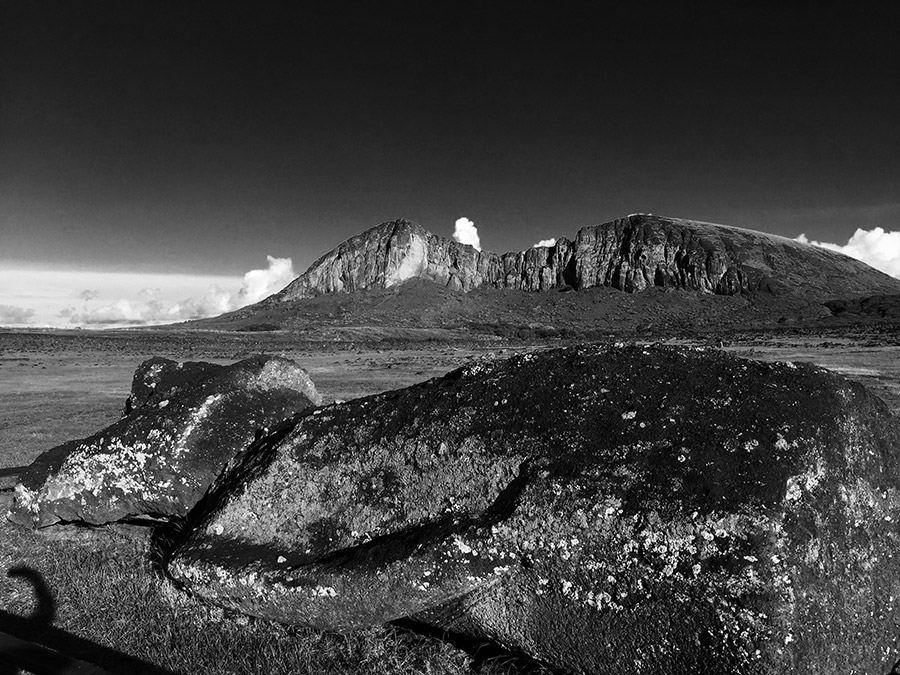
On the way back to my car I ran into an American woman who had left her headlights on this whole time, her battery utterly dead. The Rapa Nui ticket-taker for Tongariki and I spent about half an hour repeatedly pushing her jeep to the top of the hill, getting it rolling downhill and then jumping and and popping the clutch to try to get it started. On one of these runs the guy dropped his phone and we miraculously somehow managed to not run over it with the jeep. It was all for naught though as this jeep was deader than disco. The woman was pissed, she had clearly not got the “you are forever” message from the Moai.
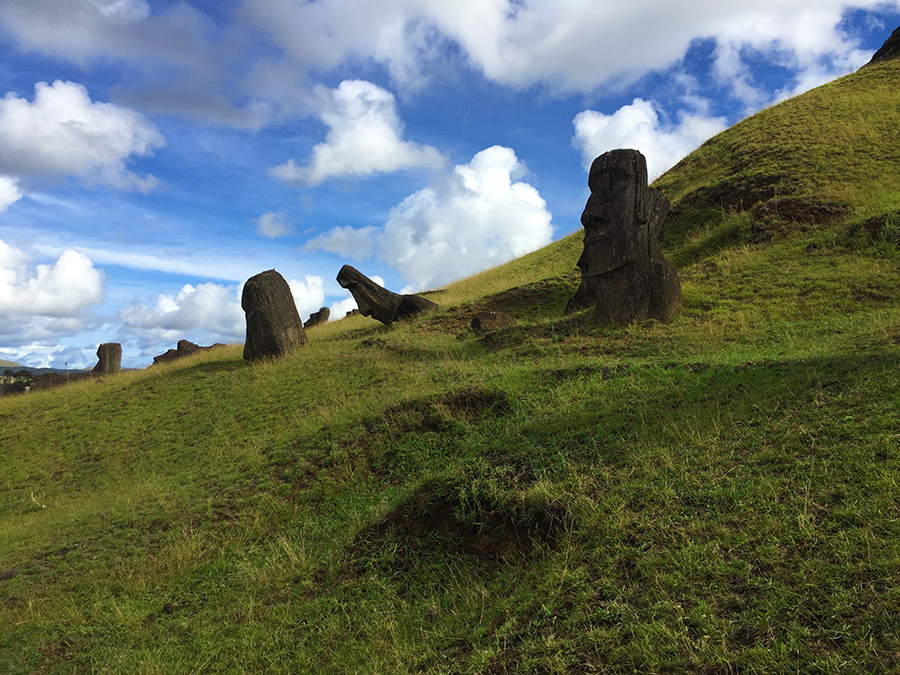
That famous photo of Easter Island I’d seen as a kid was taken on the slopes of Rano Raraku, the volcanic quarry where all the Moai on the island were carved. Over hundreds of years the sides of the volcano have gradually eroded away and slid downhill, partially burying the Moai standing on the lower slopes. Because this one photo constitutes the entirety of most people’s exposure to Easter Island, almost everyone thinks of the Moai as just giant heads, simply because the bodies of the statues seen in that photo are buried under the ground.
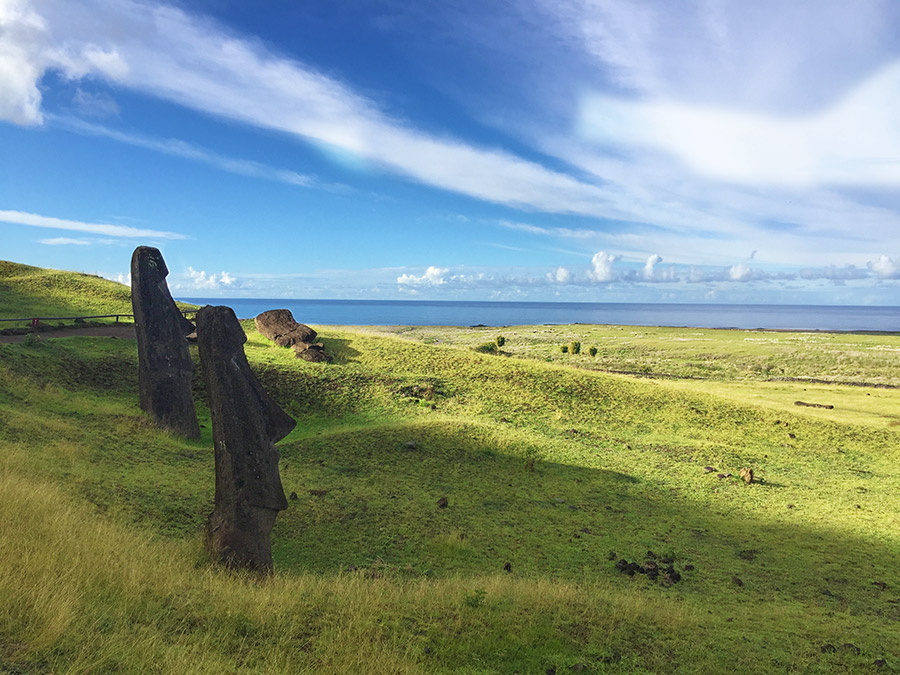
It makes sense that this would be the lasting image of Easter Island, as these were the only intact Moai standing by the time the camera was invented, and it remained this way until Thor Heyerdahl started standing the fallen Moai back up again in the 1950s.
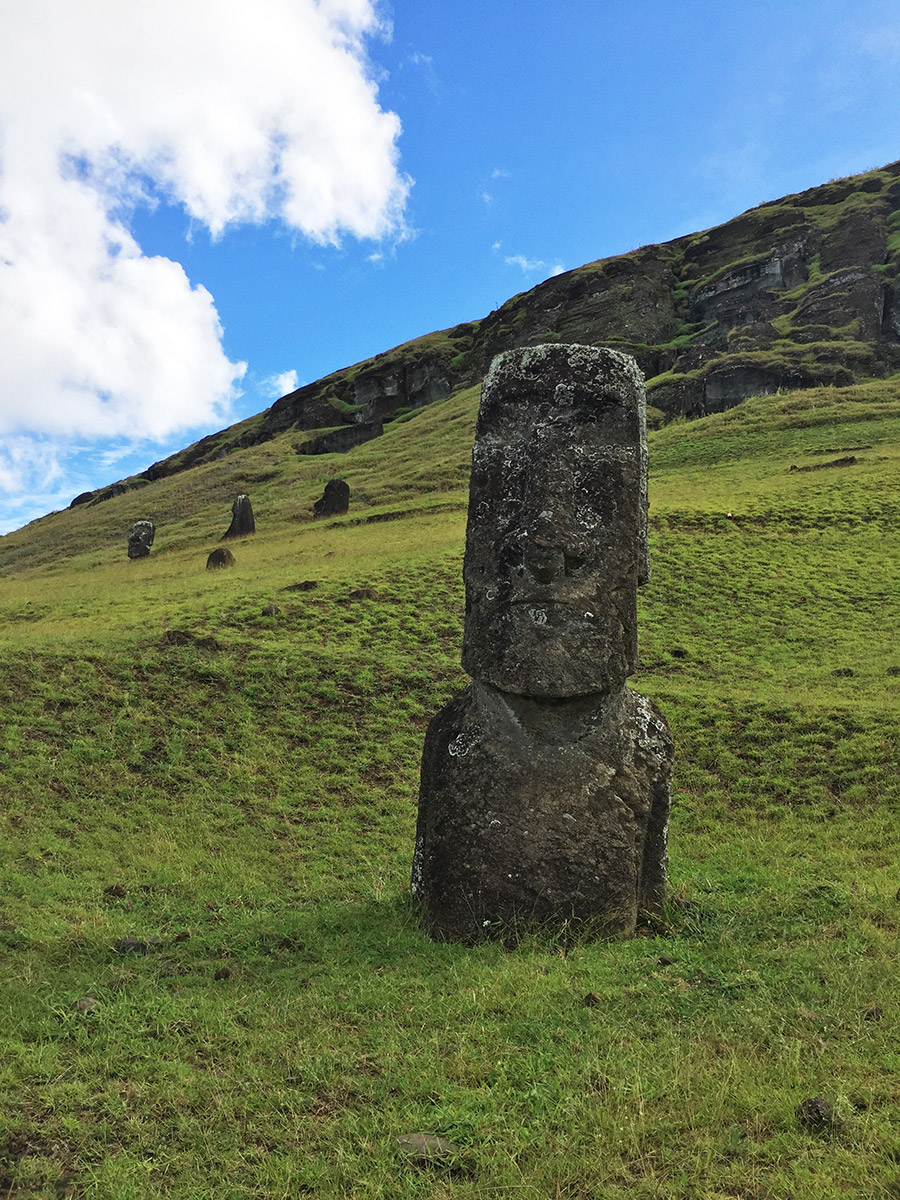
The visitor to Rano Raraku is spoiled for choice, as there are Moai everywhere. Paths snake up and down the sides of the volcano, past dozens and dozens of Moai in various states of incompletion and varying wildly in size. Some of the Moai still attached to the volcano’s rock walls are so huge it seems like they were abandoned unfinished only because somebody suddenly realized “Oh holy shit, we’re gonna have to move this thing!” I laughed as I imagined the carver getting carried away in the throes of creation, while the goons who had to move the Moai all the way across the island shouted over his shoulder “Whoa! Whoawhoawhoa dude! DUDE!”
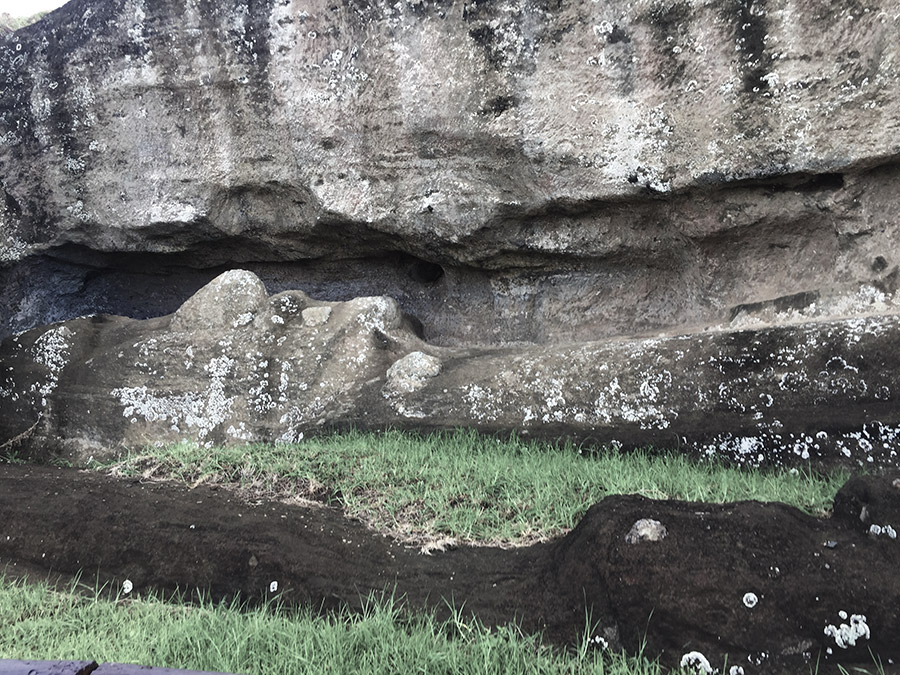
The Moai were carved by teams of workers under the direction of a master carver who was in charge of the design, all of them commissioned by whoever was rich enough to feed all these guys for the year it took to carve and transport a 20-ton statue.
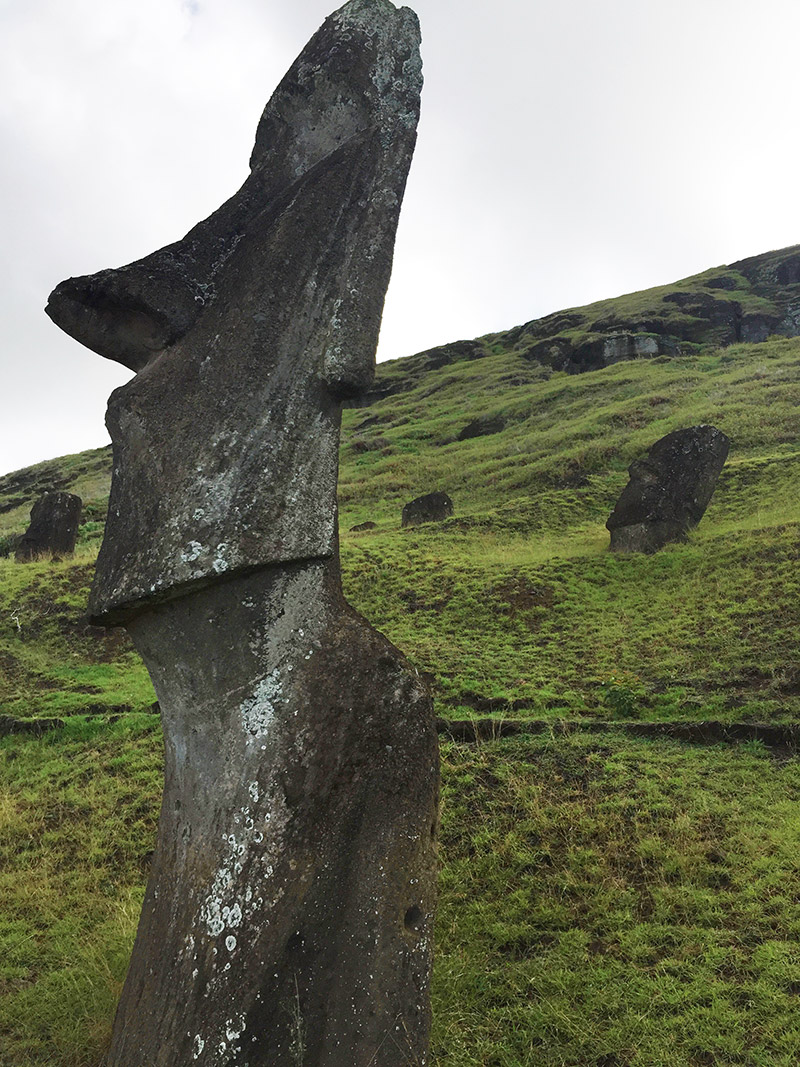
After seeing Moai all over the island, you get a feel for how the design of the statues evolved over time, gradually being refined from almost round-headed statues similar to other Polynesian art, to gradually taller and thinner stylized designs. There are a couple of oddities an Rano Raraku, like this Moai with a European ship carved on his chest:
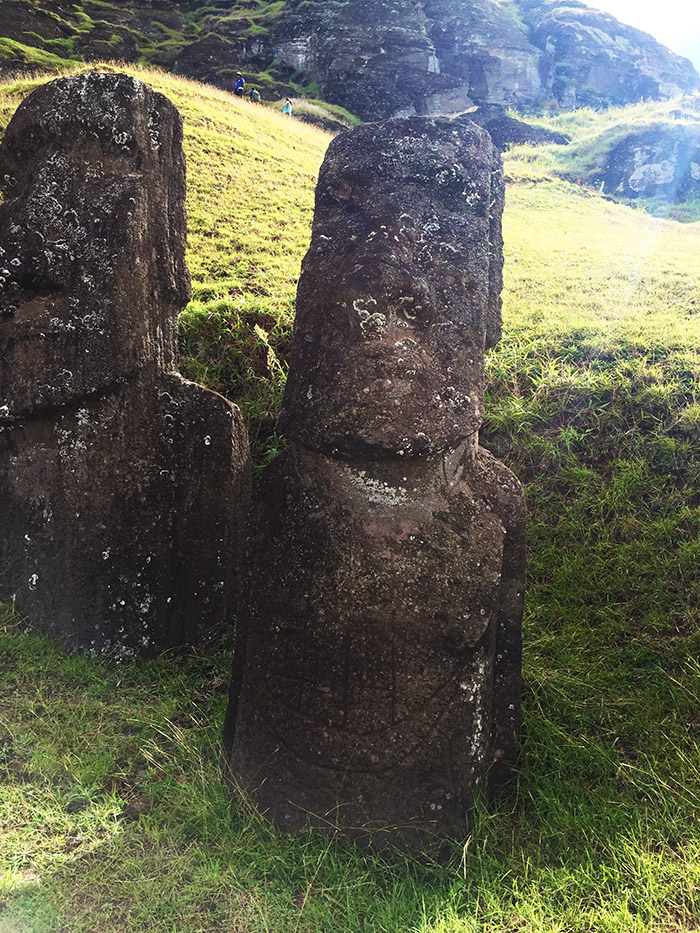
And the submerged Moai in the back whose head has been carved into another entire Moai:
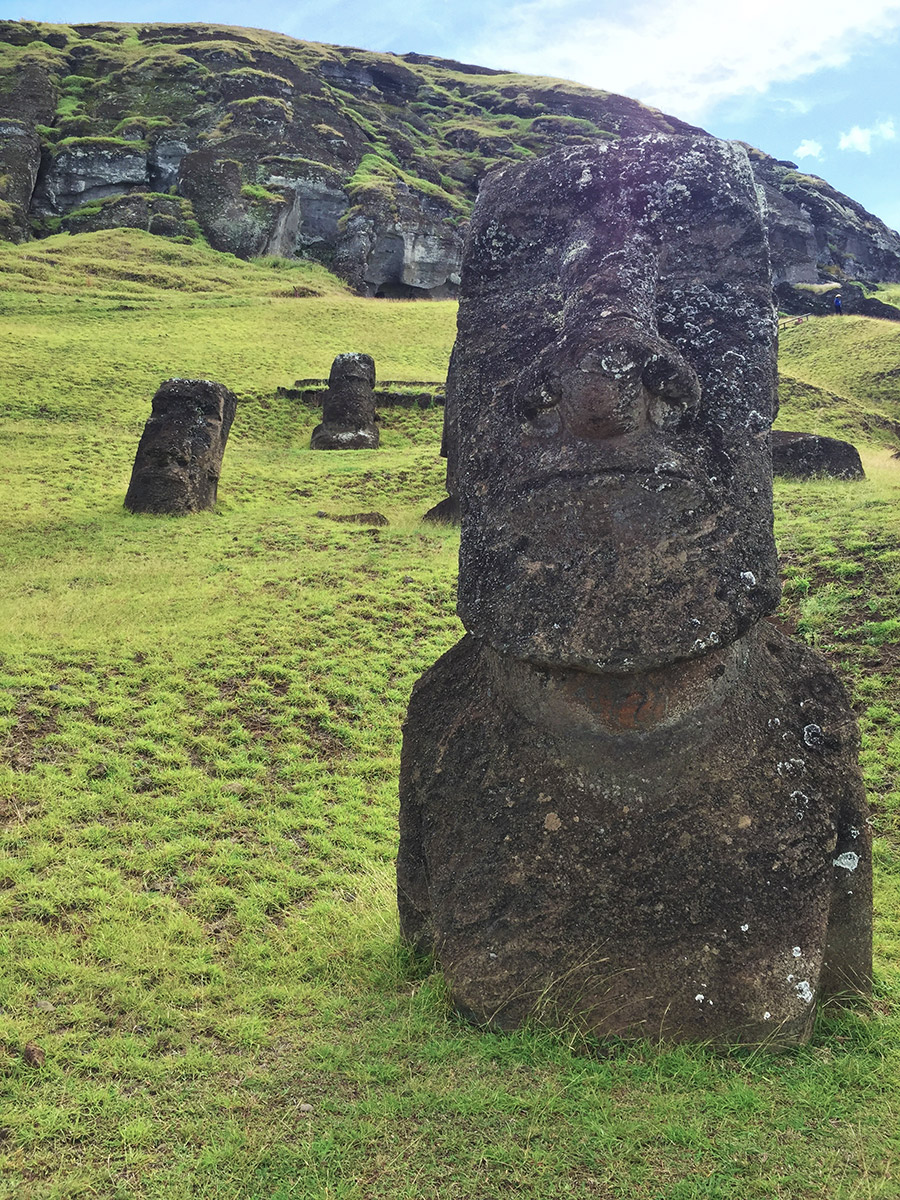
But the strangest Moai at the quarry is Tukuturi, a kneeling, bearded figure hiding around the corner on the other side of the volcano:
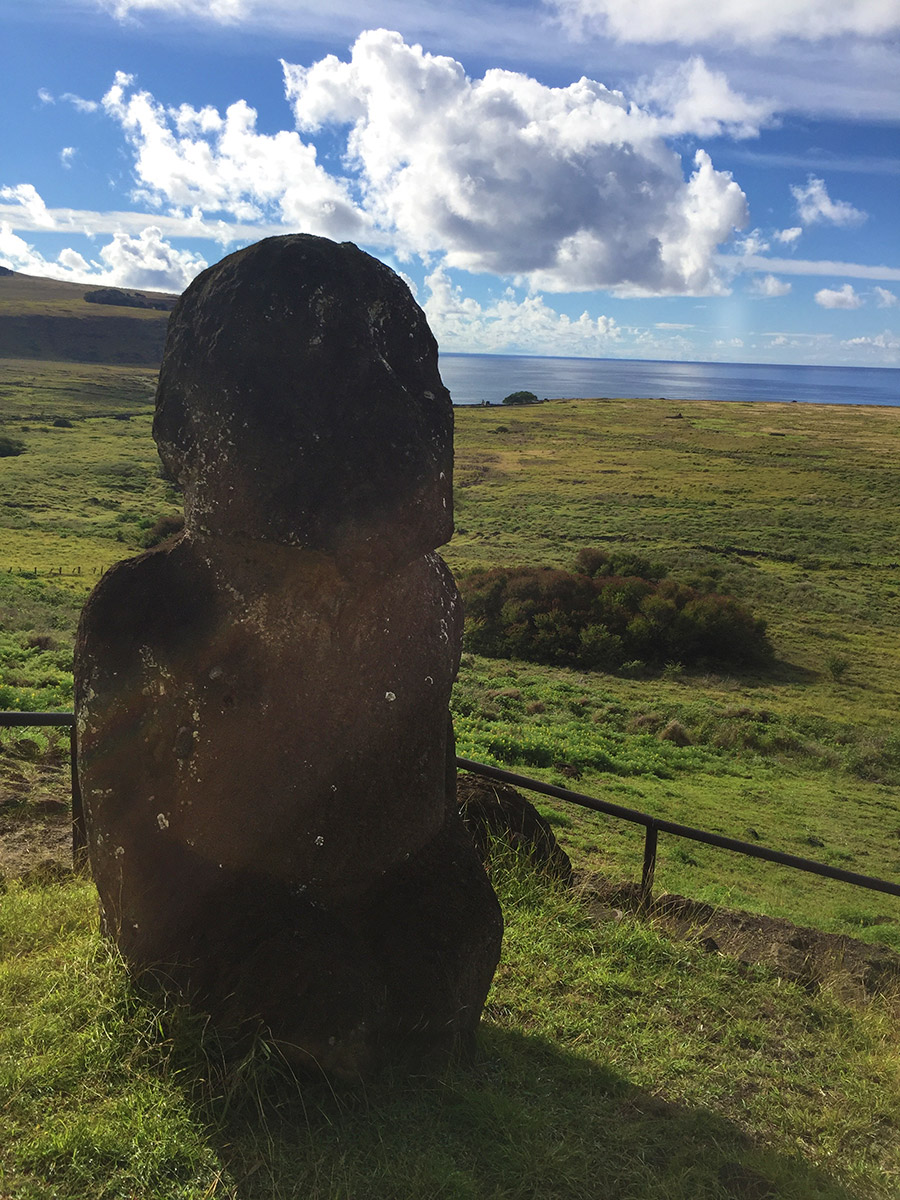
Nobody knows what in the hell is going on with this guy. He looks nothing like any of the other Moai on the island. A high-powered mutant of some kind never even considered for mass production. He’s thought to represent a festival singer, carved long after the era of ancestor worship had ended.
Inside the crater of Rano Raraku there’s a freshwater crater lake, which was just mud and reeds when I was there. In February every year, the Tau’a race is held here, where the competitors race across the lake in handmade kayaks, then run around the lake damn near naked while carrying two huge bunches of bananas, before tearing ass back across the lake in their kayak. This is, however, nowhere near the island’s coolest athletic event. That would be the Haka Pei, where the athletes, still damn near naked, luge down Cerro Pui hill at mind-bending speeds on two banana tree trunks tied together. I was there in the wrong month to see this in person, but they were playing footage on TV and it’s both hair-raising and a reminder that Jackass is in no way a modern invention.
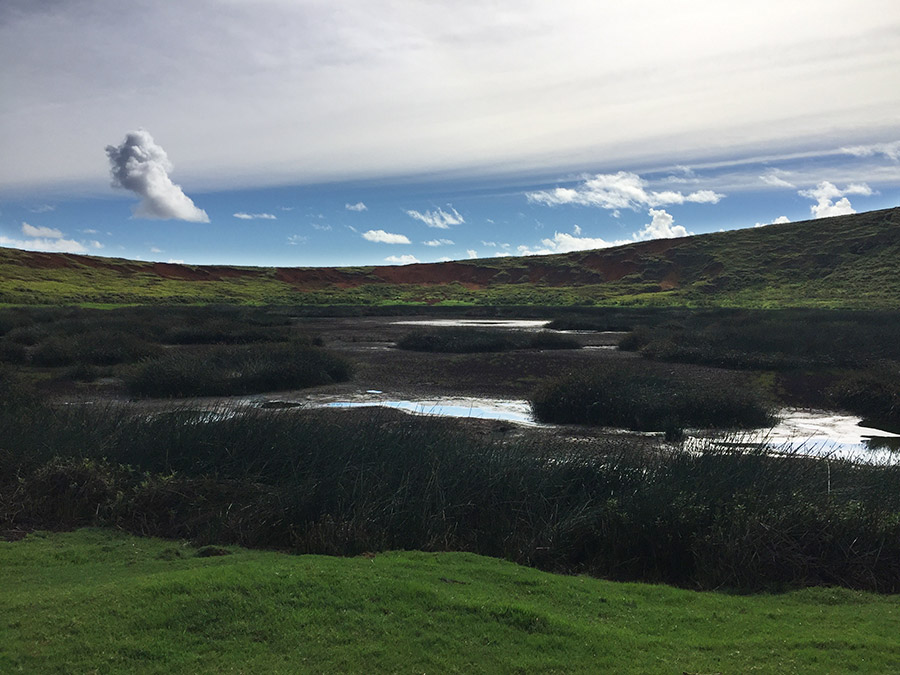
I sat under a tree inside the Rano Raraku crater for long while, enjoying the sunshine and looking up at the unfinished Moai clinging high up on the rock walls, beneath the rim of the crater. Moai-mania had reached such a peak that all the carving spots on the outside of this huge volcano were claimed, so those truly desperate to get their Moai on started carving them inside the crater itself, necessitating moving the massive finished Moai down the slope, across the crater, up over the lip and down the volcano again. These guys were not messing around.
From Rano Raraku I made my way to the north coast of the island and turned off a hidden little dirt road, parking on a patch of dirt near the face of the coastal cliff. I got out and set off on foot to climb Poike, the volcano on the northeast corner of the island. Poike is Easter Island’s second-highest point, and this peninsula gets no tourist traffic whatsoever.
Hiking up past where the road ends, I found a small gap in the barbed wire fence and ducked through. I decided to hike along the north coast until it turned south, so I could touch the northeast corner of the island before turning and climbing Poike itself.
The northeast coast of Easter Island is different from all the rest, as the scrubby grass was regularly interrupted by stretches of eroding soil in vivid hues of orange and red, creating an absolutely Martian landscape.
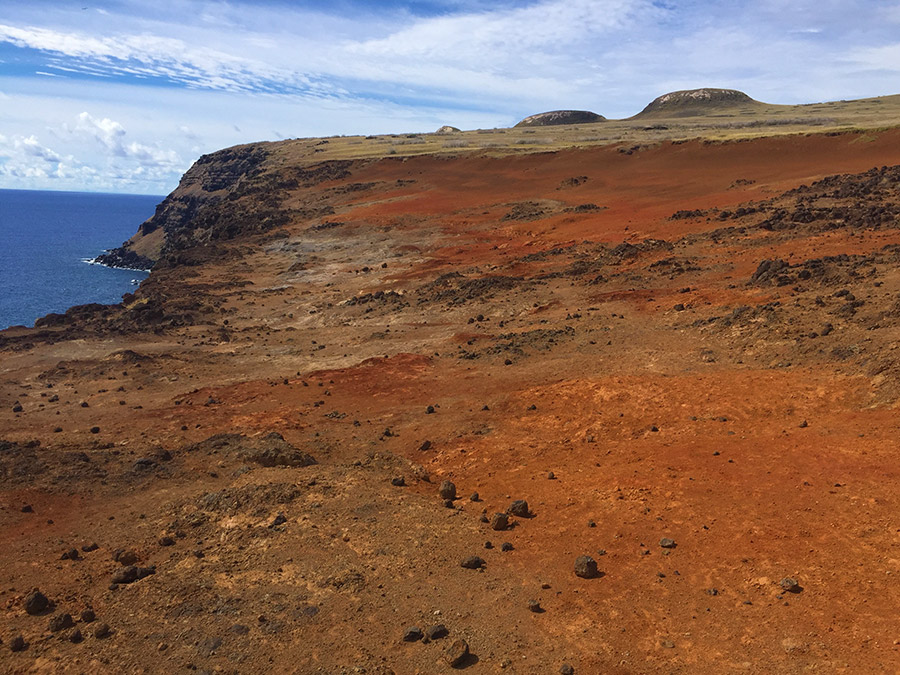
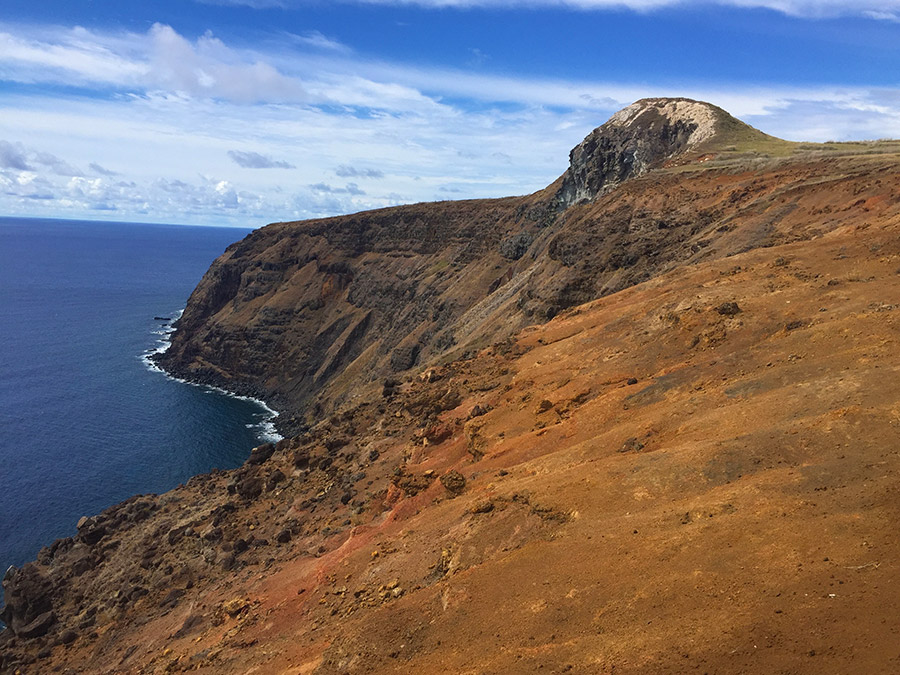
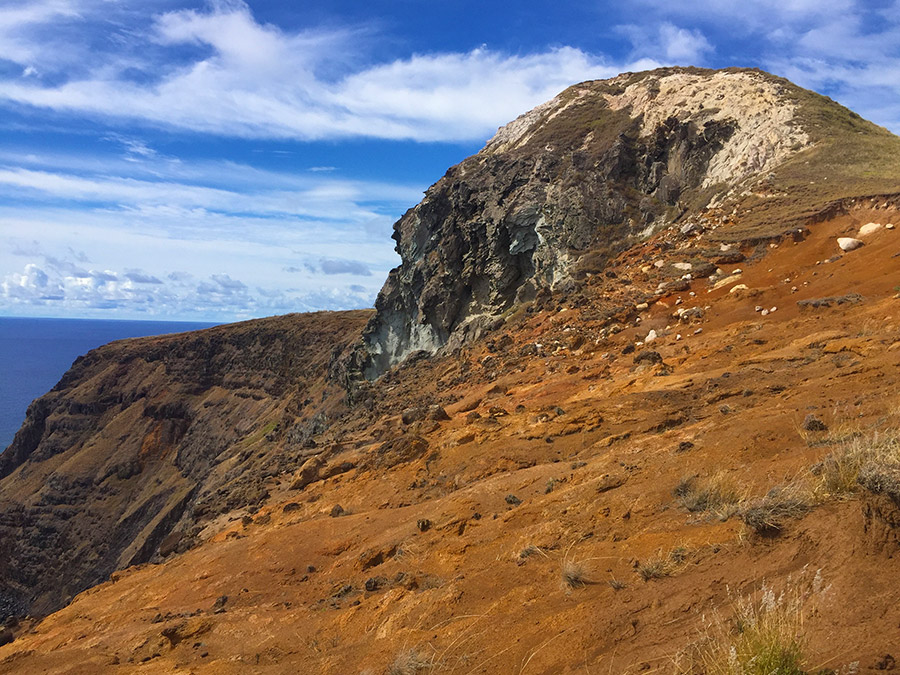
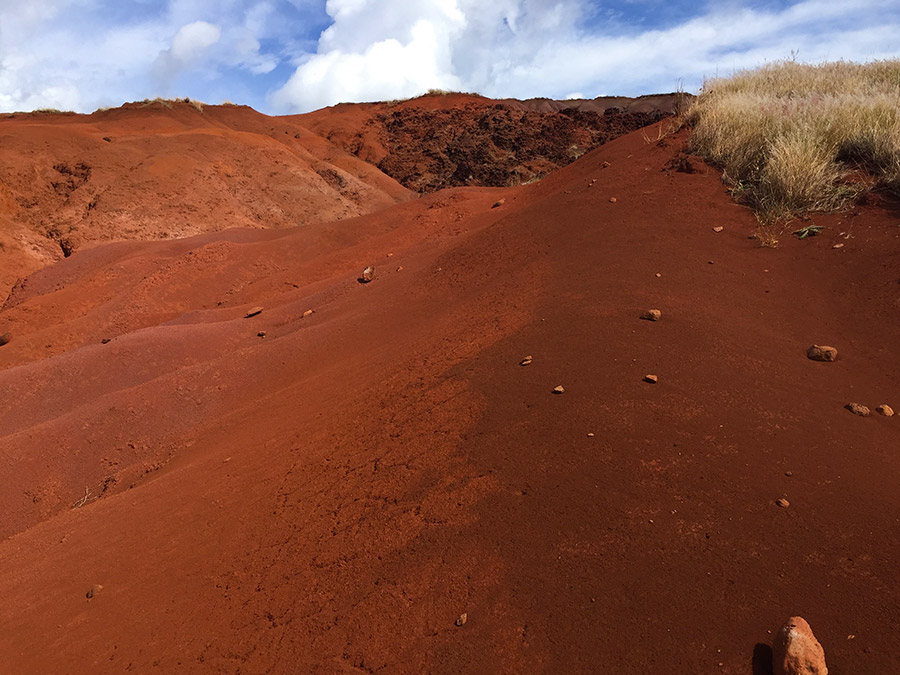
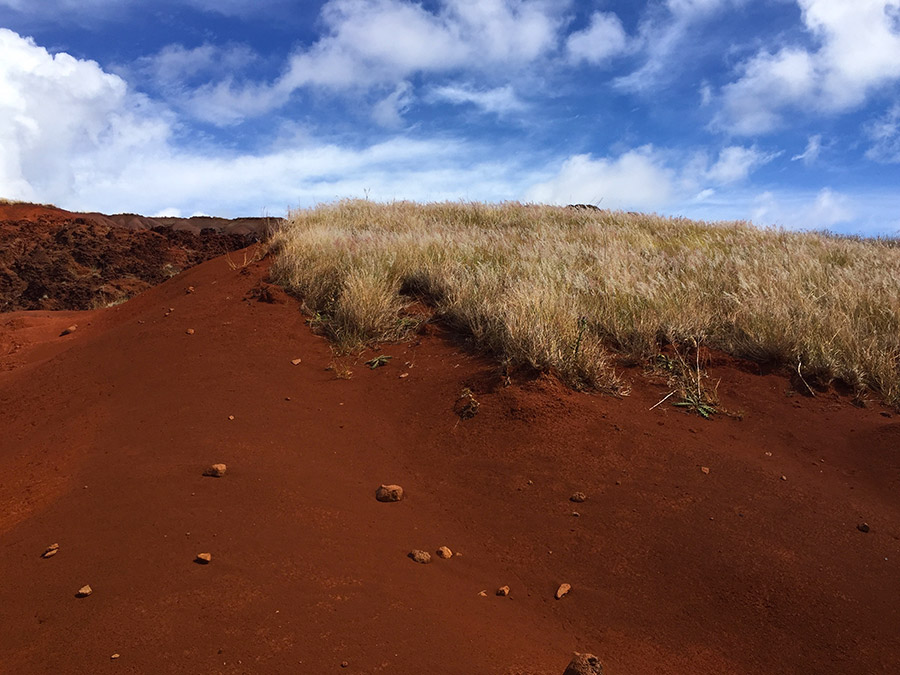
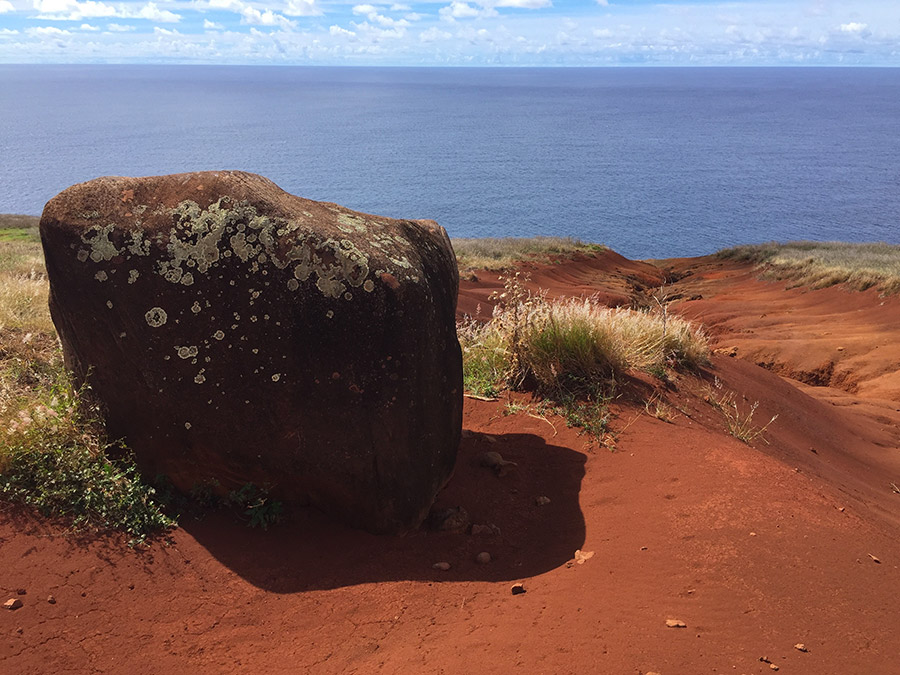
My guidebook that said nobody ever goes to Poike hadn’t lied, it was just the hawks and me. Chimango Caracara hawks hunt rodents all over the island, and they pretty much have the northeastern headlands all to themselves. Their wailing screams make them sound like a much bigger bird than they are. A pair followed me as I hiked up the coast, clearly plotting something.
I saw what might be some ruins up the hill, which I thought could also just be naturally occurring pile of rocks. I stood and debated for a minute about walking closer. The lack of visitors to this part of the island meant that it had sat unchanged for over 300 years. So there could be ruins anywhere. Would I be trespassing on something sacred to walk closer over these rocks?
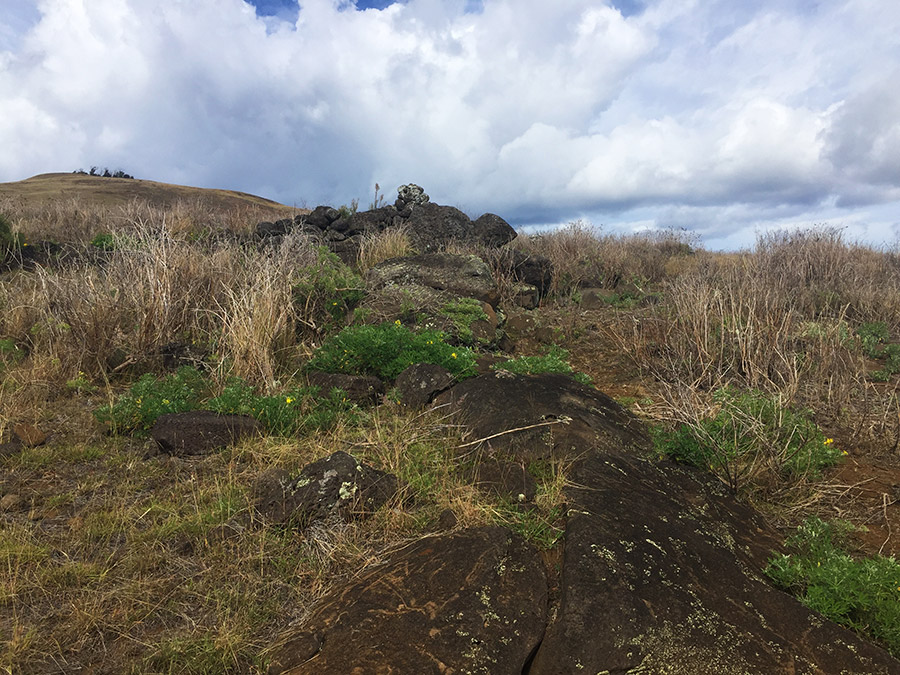
I tentatively took one step off the trail and the instant my foot touched the ground, some kind of bird exploded out of the bushes at my feet like a shotgun blast, causing me to shit my pants and then suck it all back up into my body in one deft motion. The bird hauled ass across the sky making a “YIPE YIPE YIPE YIPE!” sound like a scolded dog in a cartoon. Okay yeah I’m just going to continue up the coast.
I later learned this bird was a Chilean Tinamou, which is sort of like a little emu and they only fly when you scare the holy shit out of them.
The guidebook had said there were a couple ruins of note on the northeast coast, but that you had no chance in hell of finding them without a local guide. I took this as a personal challenge.
I found some small Moai remains in a few spots:
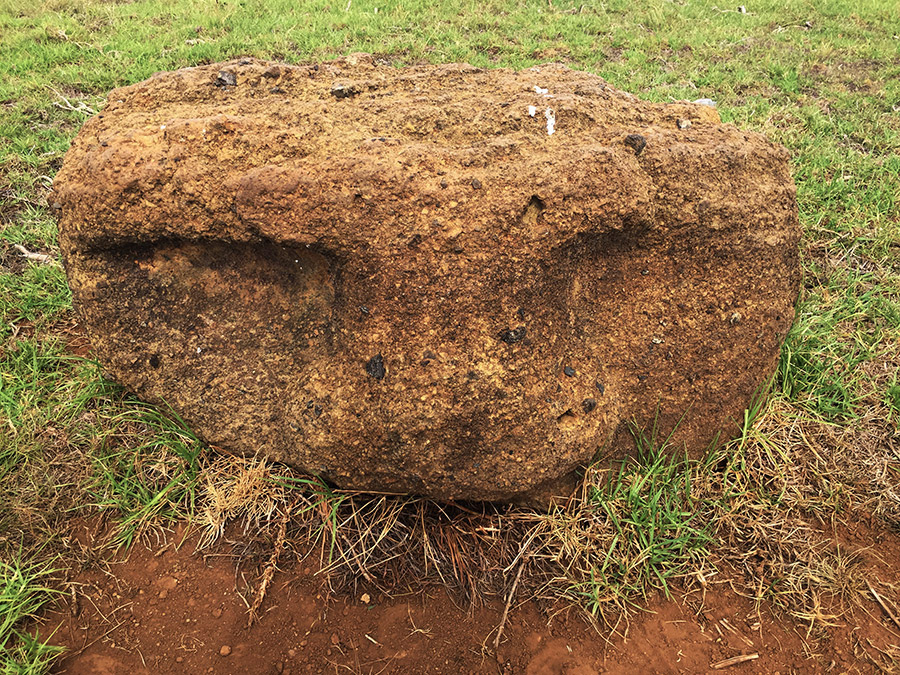
But the holy grail was the Cave of the White Virgins, where young girls were kept living in the dark to preserve their fair skin tone for religious ceremonies. Finding this seemed unlikely, since it was supposed to be tucked into the sheer cliff faces that drop 600+ feet straight down into the ocean from the ledge where I was hiking.
Eventually I found what seemed to be it, and I climbed very carefully down the cliff face to get a peek.
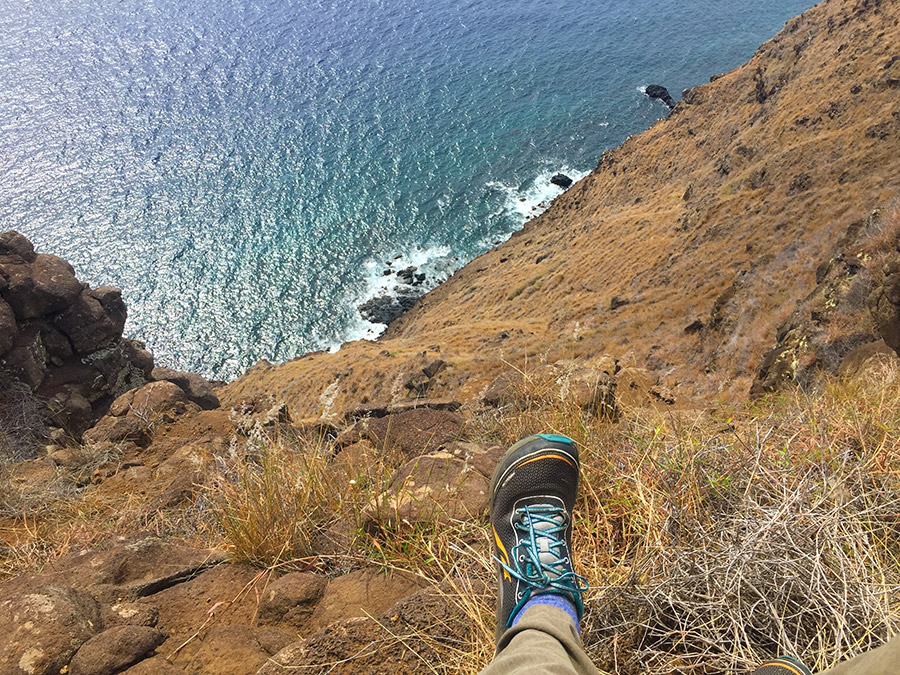
Angling my way down the cliff face, I became aware of how tired I was after weeks of hiking and that I was probably too weak for any life-saving acrobatics should I slip off the cliff. I got down to the entrance of a cave and snapped a few photos from above as my legs began to shake and I looked down at the waves crashing on the rocks hundreds of feet below. Okay yeah this is far enough.
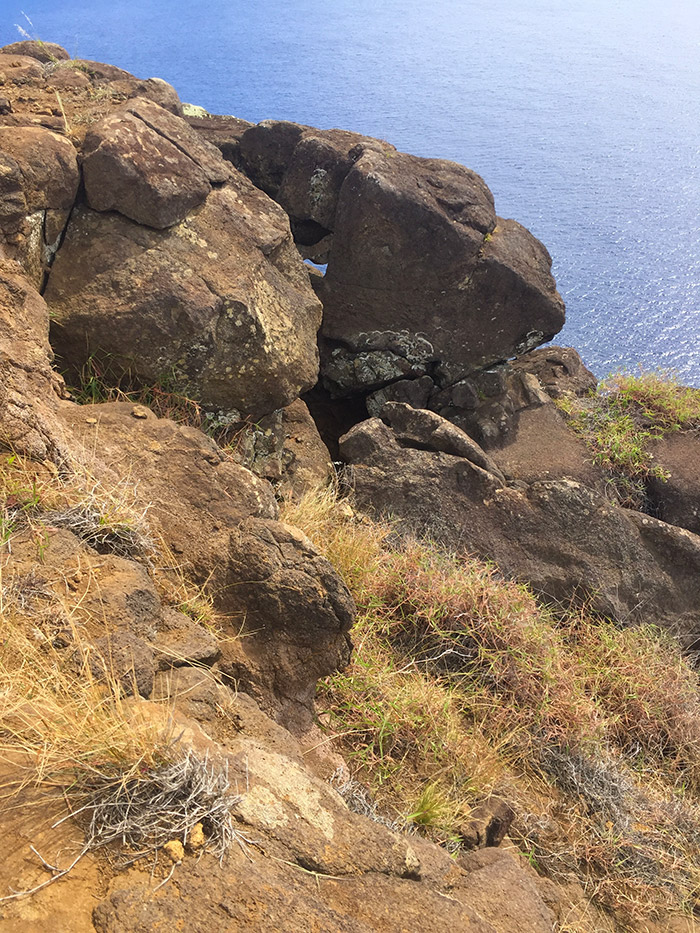
After making the turn southward at the far corner of the island, I pivoted and made my way up Poike. This was pretty much a long, straight shot up the slopes of the volcano, the only obstacles being the many lava rocks hiding in the tall grass waiting to roll your ankle. Normally hiking through tall grass like this I'd be concerned about snakes, but Easter Island has none. I briefly wondered about ticks. No deer, so? Hmmm.
Up top I crested the lip of the volcano and discovered a forest inside the volcano’s caldera, which seemed utterly out of place. Coming up over the rise, there it was, magical and sudden, sitting there eerily.
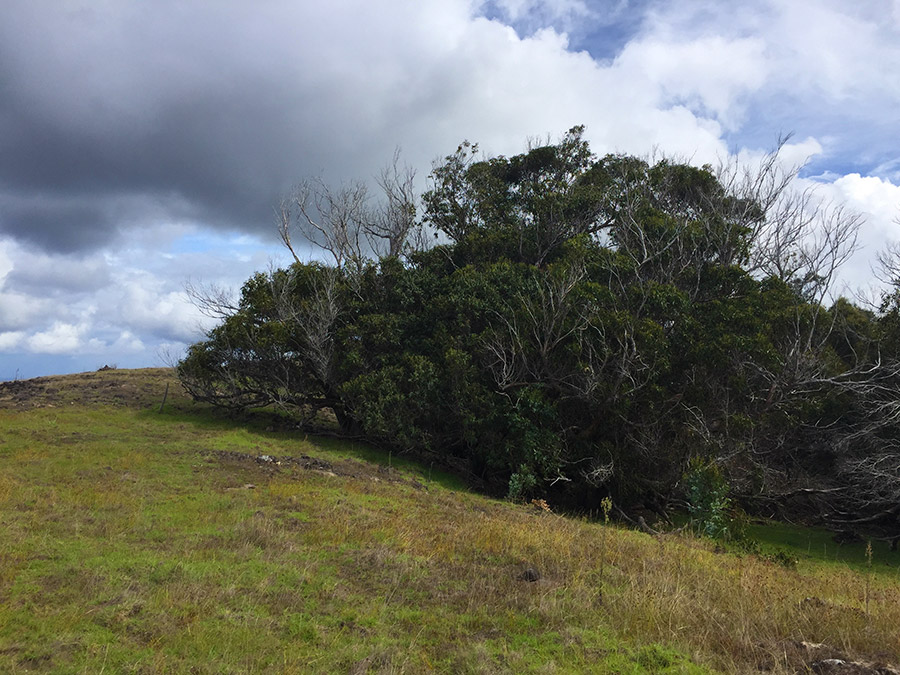
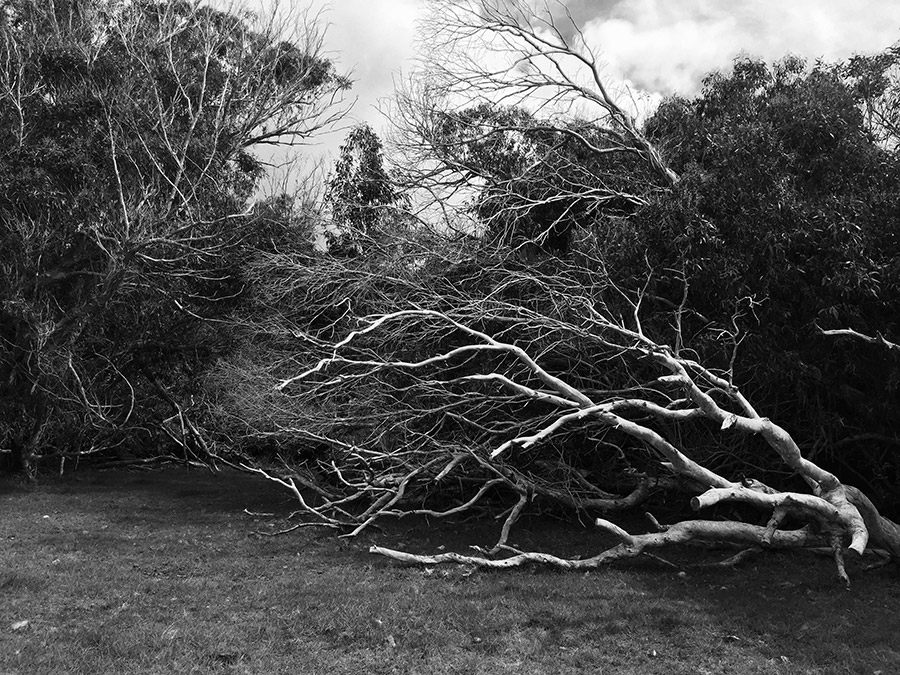
If you’re ever going to have a witch materialize and trick you into a bargain for your soul, this is definitely where it would happen.
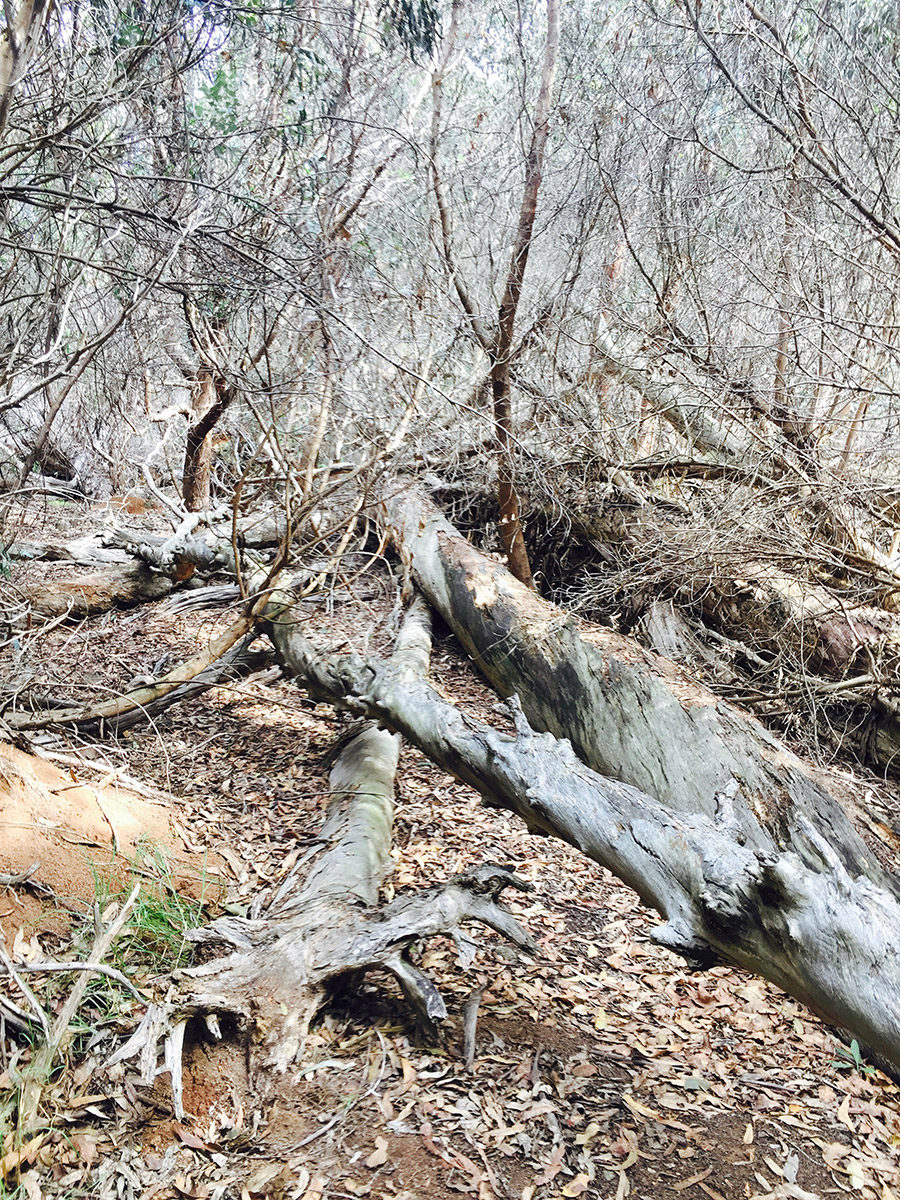
Coming out the other side of the forest, I took in the view of the entire island as a couple of little technological shanties that appeared to be some kind of weather equipment silently monitored behind me.

My phone suddenly sprang to life and bubbled over with new messages. My friend Tia who I’d met on the Inca Trail hike in Peru was coincidentally going to be spending time on Easter Island while I was there, and she had just landed. I hiked down the volcano, nodding to several of Easter Island’s 6,000 roaming wild horses (who outnumber the people, and are all just biding their time to make their move) as I passed them by.
The next day, the rains began, and they did not fuck around. Before long the power was out across the entire island. After a pre-deluge return to Tongariki to see my grandpa, Tia and I took this rainy chance to visit the island’s museum, which was open in spite of all the lights being off inside.
I was fascinated by the drawings from the 1800s showing what the island and the people looked like then:
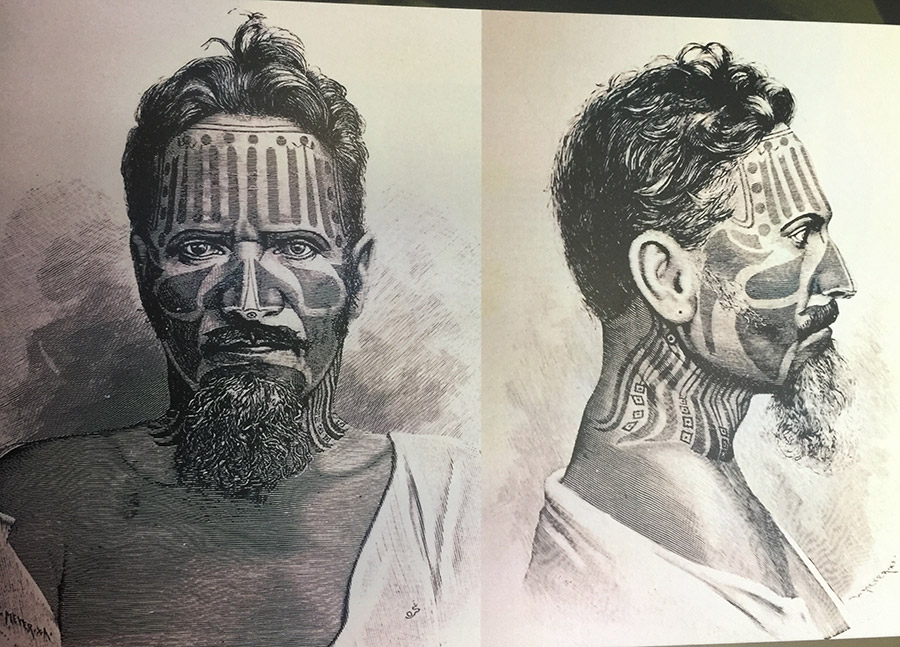
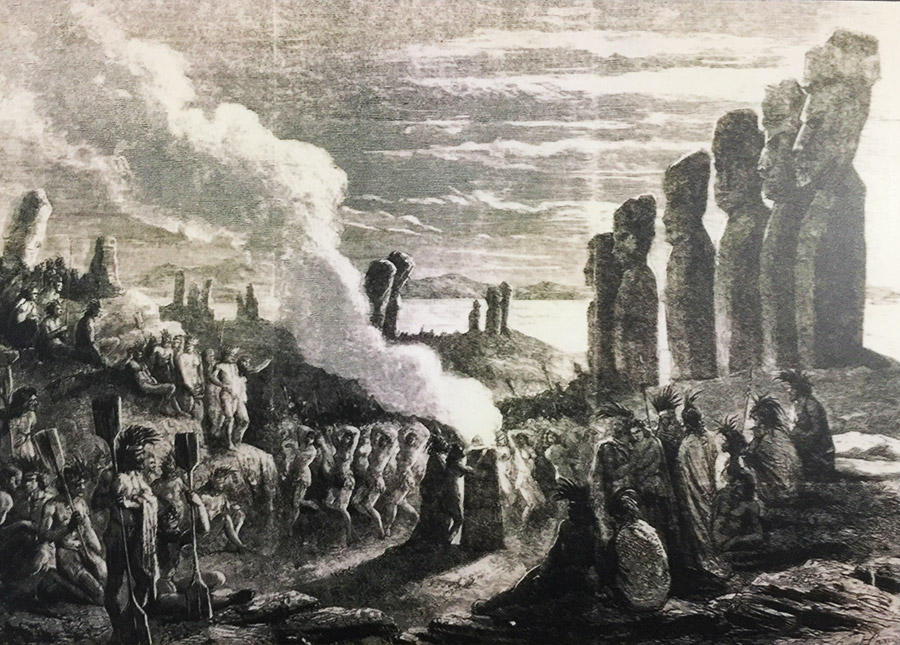
The museum also featured plenty of oddities, like a rare female Moai statue and replicas of tablets containing Rapa Nui writing, which no one has ever been able to translate.
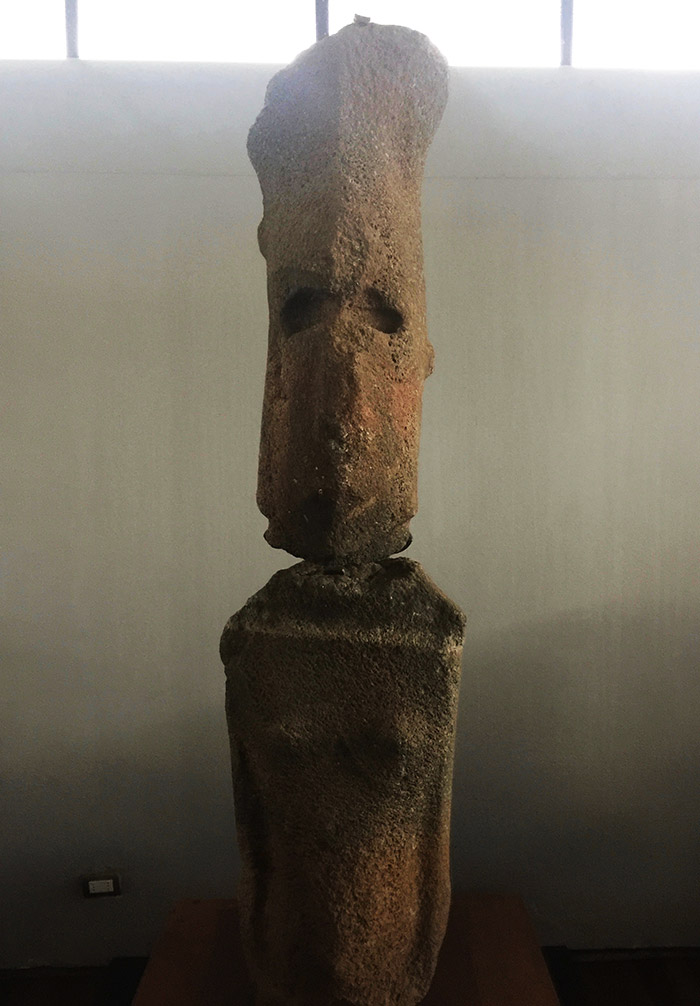
Thanks in part to the rain, Tia and I spent a lot more time and money in restaurants than either of us had planned, but there were too many great conversations to ever regret this.
The church up the street donged out one of its mysterious songs. Tia identified it as Ave Maria. I was pretty sure it was Gin & Juice.
Walking back to my cabin late that night, I passed through a dark corridor where locals sold shitty Moai souvenirs during the day. In the near pitch black, the six dogs walking around me suddenly broke into a huge melee, snarling and barking and wrestling each other, the sounds chaotically swirling all around me. For a second I thought I was in deep shit, but after a few moments I realized nothing was biting me, the dogs in fact were totally ignoring me as they violently debated Chilean politics with each other. My only challenge was to get out of there without accidentally stepping on any of the warring dogs in the dark.
I turned the corner up the dirt road to my cabin. Whew, that was kind of stressf- An ear-piercing commotion of barking hit my face as a large German Shepherd lept out of the darkness and collided with the fence I was walking along. Holy shit! Oh thank God, he's on the other side of the fence. Whew. My body unclenched. I continued walking up the road and the dog ran along the fence, barking furiously. Thank God for that fence!
Then, because of course, the fence just ended and the dog ran around the end of it. He then turned and sprinted toward me full tilt, up the muddy road and out of the blackness. I pulled out my car keys and threaded them through my fist, really, really hoping I wouldn't have to stab a dog with them. The German Shepherd bore down on me at full speed. Gulp.
Right as he reached me, the dog abruptly stopped, and sat down at my feet. Oh, whew! This is going to be okay. Jesus Christ dog.
The dog licked my hands. Aww, that's sweet.
I pulled my hands up to my chest to keep them from getting completely slobbered, and the dog jumped up to the level of my face and nipped my hand. Oh shit, what's happening now? He did it again and I started to worry again. It took me a second to realize he thought my car keys were some kind of a treat and he wanted to get him some of that. I switched my tone from “Hey buddy, who’s a good stray dog?” to a deep “No! Stop!” and he immediately sat down and chilled the fuck out.
All right, now I've got a posse. Look out Andre the Giant.
One of my goals for the trip was to hike the remote northwest coast of the island, from Annukena beach in the north to Ana Te Peu on the west coast, a forgotten stretch of the island where there were no roads or tourist sites to speak of. The tough thing about the hike is that it’s not a loop, so if you’re alone you have to do the 4-hour hike, then turn around and hike 4 hours back to your car, unless you’re clever and work out a taxi or something to pick you up at the far end.
Or, you make a friend in Peru and they show up on Easter Island like “Wassaaap dog?” and you say “Ain’t no thing, G, and I definitely talk like this in real life” and they agree to pick you up after your hike where the road begins again on the west coast of the island.
Tia and I drove up the Annukena beach and paused briefly to take in this weird fucking statue:
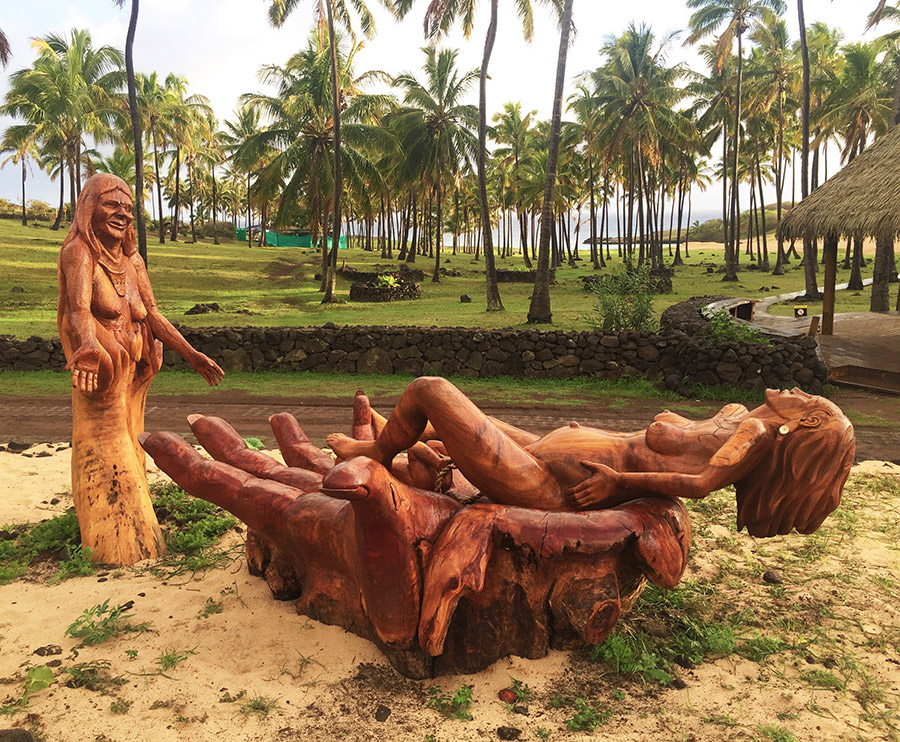
And the line of Moai on the beach where the original Polynesians landed on Rapa Nui:
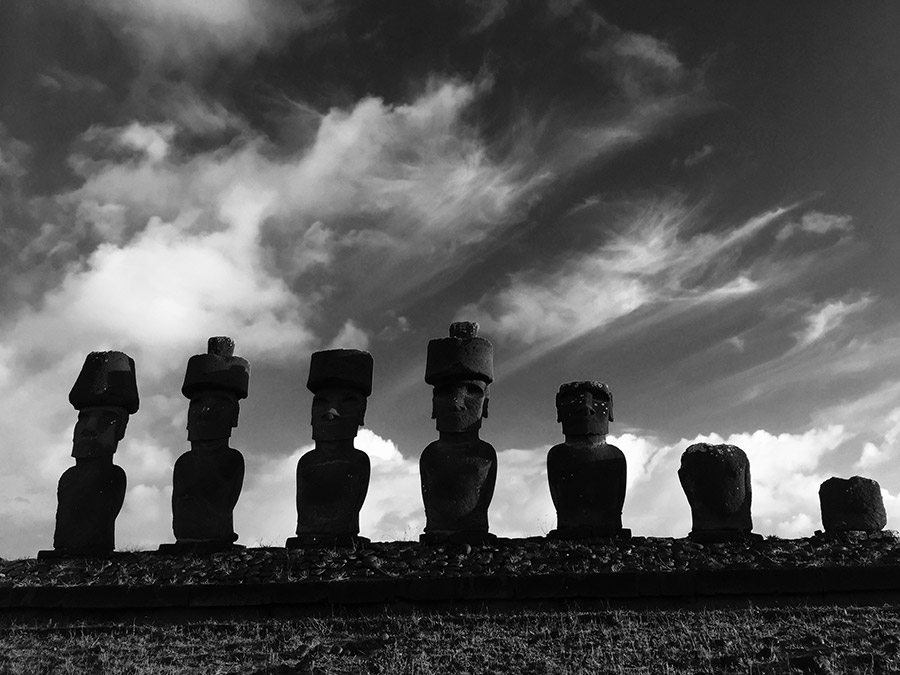
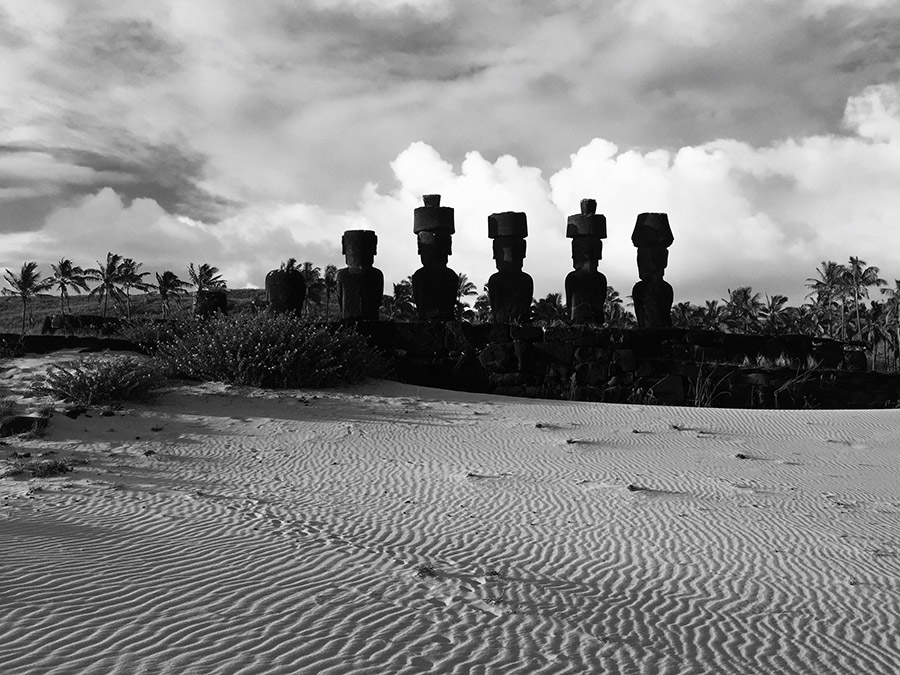
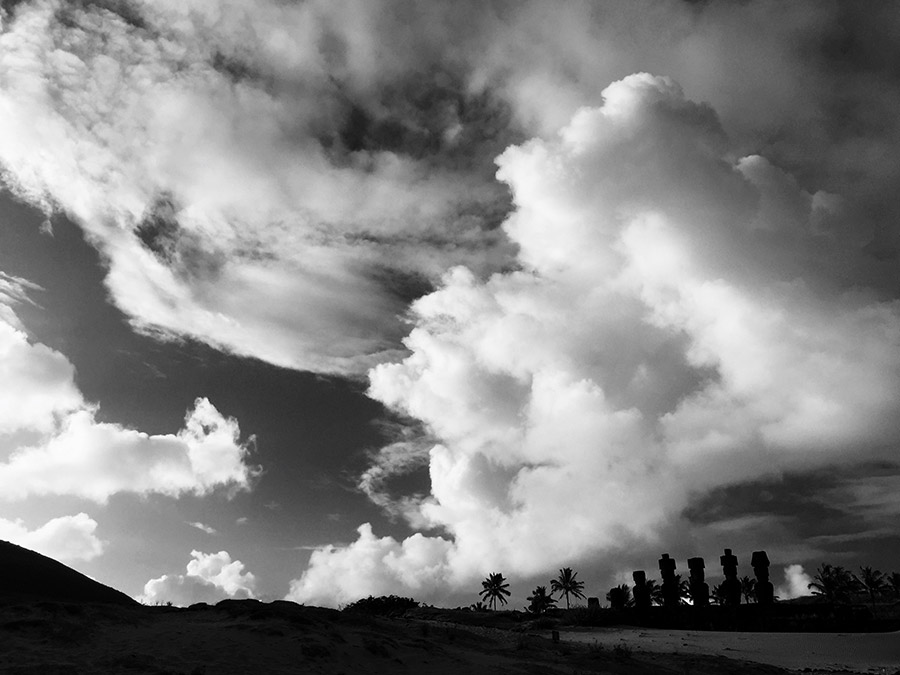
Tia wished me luck as I handed over the keys to the jeep and set off to hike where no man had boldly gone very often. I slipped through a fence at the edge of the beach and headed west up the rocky coastline, as waves crashed and swelled against the cliffs on the shoreline.
Immediately it was clear that I was hiking across someone’s land. This concerned me slightly but the Easter Islanders don’t seem especially uptight about this kind of thing. If anything came up I could just point to all the wild horses and cows and whine “How come theeeey get to do it?” No one was around, anyway, so it didn’t seem like it was going to matter.
A ways up the coast I came across the strangest thing I saw on the entire trip. I was so taken aback it never even occurred to me to take a photo of it, which now seems strange in retrospect. Near the cliff, there was the complete skeleton of a horse lying on the ground. I’d seen a lot of random horse bones during my hike up Poike, making it clear that wild horses were just dying wherever they died and returning to the earth with no human intervention in the process. But I’d never seen an intact skeleton like this before. And the weirdest thing about it was that all of the horse’s hair was lying in the grass in a perfect horse-shaped halo around the bones, like it had been hit by lightning or taken by aliens. It reminded me of the electrocuted cat in Christmas Vacation.
Shaking off the Nine Inch Nails music video I had just wandered into, I continued up the coast until I hit a barbed wire fence. I walked down toward the edge of the cliff to see if there was a way around it down there, but the fence went off the cliff like the guy just kept building it until he hit the water. I turned and walked back up the hillside, looking for a gate or a suitable gap I could squeeze through.
And that’s when I saw the horseman. I know you’re picturing a biblical figure riding the skeleton horse right now and I really hate to mess with what you’ve got going there but sadly, it was just a dude on a live horse.
Ah, shit, this is probably the land owner coming to ask me what the hell I did to his cliff horse. It was fine this morning!
As the horsemen approached I realized he was wearing some kind of uniform. I hadn’t seen a single police officer on the island up until this point, so of course I was going to run into my first one while I was trespassing out in the middle of nowhere and there was a dead horse on the ground.
He asked if I spoke Spanish, and I said a little. I asked if he spoke English and he grimaced.
The cop asked what I was doing and I explained, in my own adorable Spanish/English hybrid language, that I was hiking the north coast of the island.
He shook his head immediately. “Not possible.”
Mierda. Por que?
It turns out they only let people hike the northwest coast in groups, because if you’re by yourself and you fall off the cliff, there’s no one to point and do the Nelson “Ha Ha” laugh from The Simpsons and then post the video on YouTube. And, I guess, call for help if your friends are super good people. This had apparently happened enough times that they had to make a rule about it.
I laughed as I thought back to my much more dangerous hike up the northeast coast a few days before. I wasn’t even going to climb down any cliffs on this one! I realized that if I had done this hike in the opposite direction, starting from the deserted west coast instead of the popular beach at Annukena, there wouldn’t have been anyone to tell me I couldn’t do it until after I had already done it. Oh well, I’ll keep that in mind if I ever fly back to the end of the world to hike to the end of the end of the world.
I chuckled to myself as I thought of Tia and my conversation at dinner the night before, when we sang the praises of independence, the single life and solo travel, the joy of not needing anyone. Apparently the north coast of Easter Island disagrees.
I followed my anticlimactically mortal horseman friend back to Annukena. I hadn’t been gone too long, so there was a chance Tia would still be enjoying the beach and we- Nope, Tia’s gone. Damn.
There’s no cell service on the entire northern section of the island, so I was on foot now.
The bright side of wandering around the north of the island on foot is that it improved my chances of finding Ovahe, the only other sandy beach on the island, which is difficult to locate and a bit of a local secret. Compared to the other local secrets I’d been climbing down cliffs to see, this one turned out to be relatively easy, though the tiny dirt road turn-off would be very easy to miss in a car. Take that, people with cars and/or the ability to call their friends!
The Ovahe beach was tucked into a tiny cove, and getting there required timing the incoming waves and scrambling over sharp craggy boulders in the moments when the waves sank away. I passed more parched horse bones as I hopped from boulder to boulder.
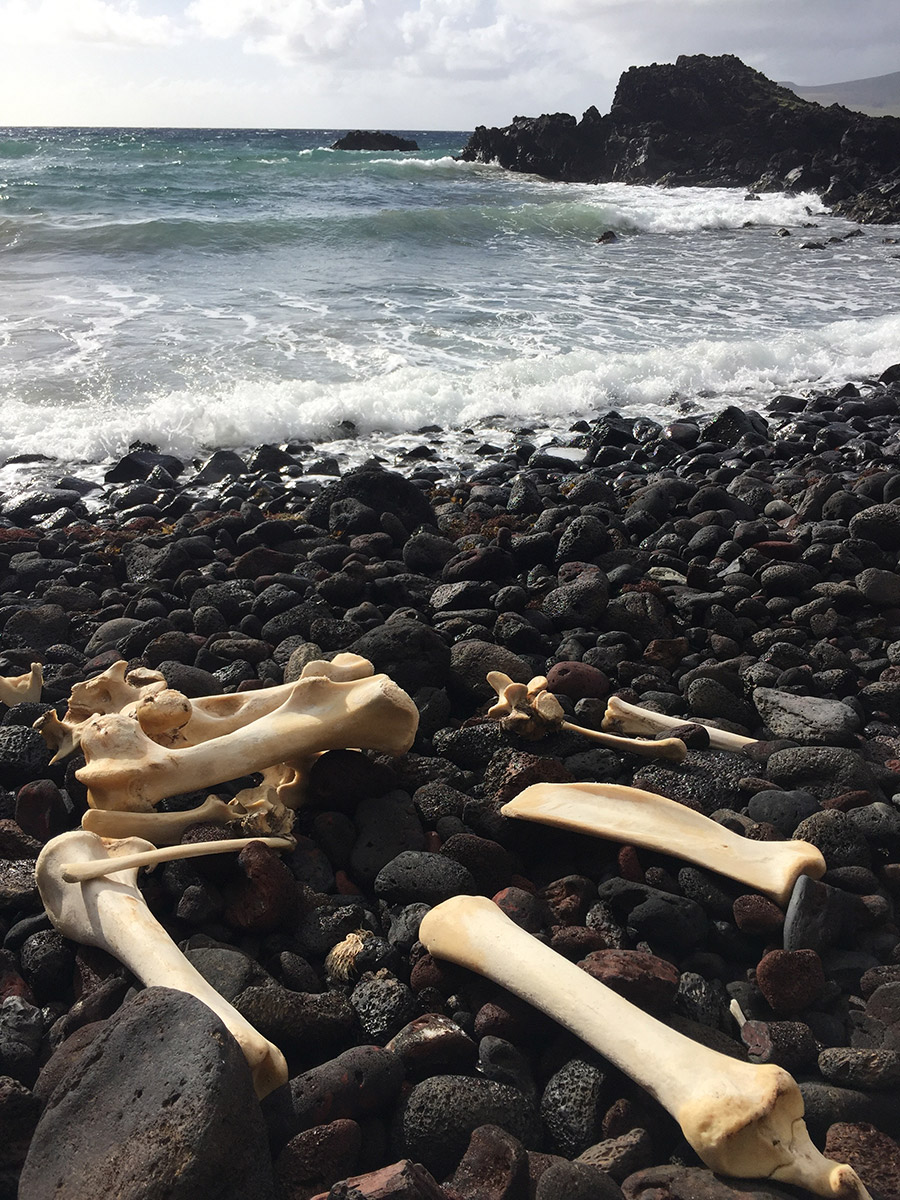
In the cliffs above there were caves of obvious archaeological significance, marked with signs saying please don’t climb up here and ruin these archaeological finds, dingus.
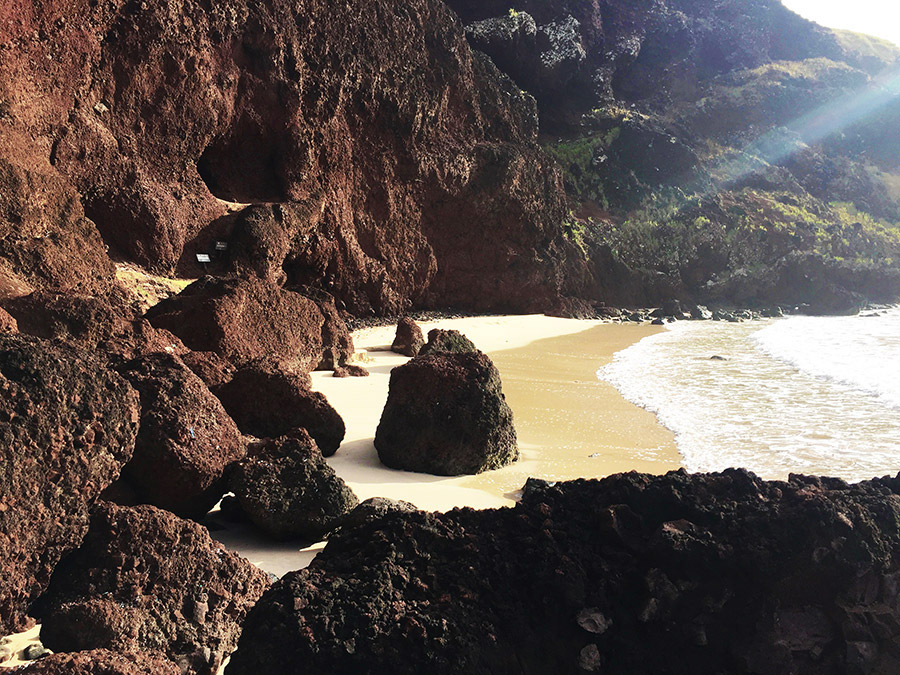
I sat down in the soft sand and had a nice long meditation as the waves rolled softly in. What a peaceful spot. After about an hour I realized the waves were getting closer and closer each time they rolled in, and if they came up much further they’d cut off my route over the rocks back up to the road. Time to go! I scrambled back up over the sharp, craggy rocks to the road while I still could.
Walking south on the main road, I pulled out my phone again. Still no signal. Tia had almost certainly gone to Rano Raraku to see the quarry, so all I could do was to walk in that direction and hope she was either still at the quarry by the time I got there, or that I eventually walked far enough south to get cell reception again. The worst-case scenario would be if I got there after she left Rano Raraku, since as far as she knew, she was picking me up all the way over on the other side of the island on the west coast, so this slow-motion pursuit could go on all day. It was four miles to the quarry.
Trekking along the road was actually quite nice, as it sank in to me that this is how we would have got around back then, before the Europeans brought the first horses to the island. And the landscape up in the north had likely changed little since then, aside from the appearance of the road I was walking along.
Then the wind picked up and I was less thrilled with walking straight into a stiff wind for four miles. Then it started to rain sideways. Balls.
I pulled my rain coat out of my pack and slipped it on. Occasionally cars passed, the drivers looking at me like “Jesus, what’s your problem?”
Then eventually a pickup truck stopped in the middle of the road. The guy didn’t really look at me as I walked by. But why would he stop here if it wasn’t to give me a ride? I stopped and looked back at the truck. The guy looked at me through the windsheild and pointed at his eyes and then at the landscape, like “You can see it’s pissing rain sideways out there, right?” I walked around to the passenger door and got in.
His name was Charlie and he was very enthusiastic about the joint he was rolling. So much so that we drove down the road with him turned completely sideways to face me, not looking at the road at all, while asking me questions about myself and simultaneously rolling a joint with both hands.
“Yeah dude… I’m from the US- Hey! We almost hit that lady on a scooter- I’m an analyst- Wow we just missed that truck!”
Charlie was in high spirits (and high) and excitedly explained that he grew his own weed and didn’t use any fertilizers, it was all natural, man. This entire conversation took place in Spanish and was by far my most successful Spanish conversation of the entire trip. Some people are visual learners, I’m a surreal situation learner. We talked about the weather, weed, why I didn’t have a lighter that he could use to smoke his weed, how the truck we were running down and forcing to pull over belonged to his friends who probably had a lighter, weed, what his favorite sites on the island were, how he felt about surfing, weed, and whether or not he thought there were too many tourists on Easter Island. And if they had any weed.
At some point I realized we were on a road I didn’t recognize at all, which was more significant than it sounds since there are like four roads on Easter Island. I briefly wondered if I had got myself into trouble, but I couldn’t sense any ulterior motive in Charlie. He barely had a primary motive, beyond getting that joint smoked. It turned out he was taking me on a shortcut to Rano Raraku, and before long we were there.
Charlie expressed his enthusiasm for having a friend in the United States now, let me know that I was cool and a good guy, and then he was off to almost hit all manner of vehicles, horses and cows on his way to the other side of the island.
I walked into Rano Raraku and there was our jeep in the parking lot. Oh thank God. I walked up and peeked in the window. Oh shit, somebody stole my sweater! I shouldn’t have left it in-never mind this isn’t our jeep, my bad. Everyone is renting the same jeep on this island.
Down the row of cars, tucked in at the end, was the jeep that did have my sweater in it. Cool.
Totally unnecessarily, my phone chose now to spring back to life, and I was able to let Tia know I was waiting for her in the café. I passed the time by pushing a French woman and her teenage daughter’s jeep out of the mud they’d got it stuck in and watching a little boy chase bewildered chickens around the café in an endless loop.
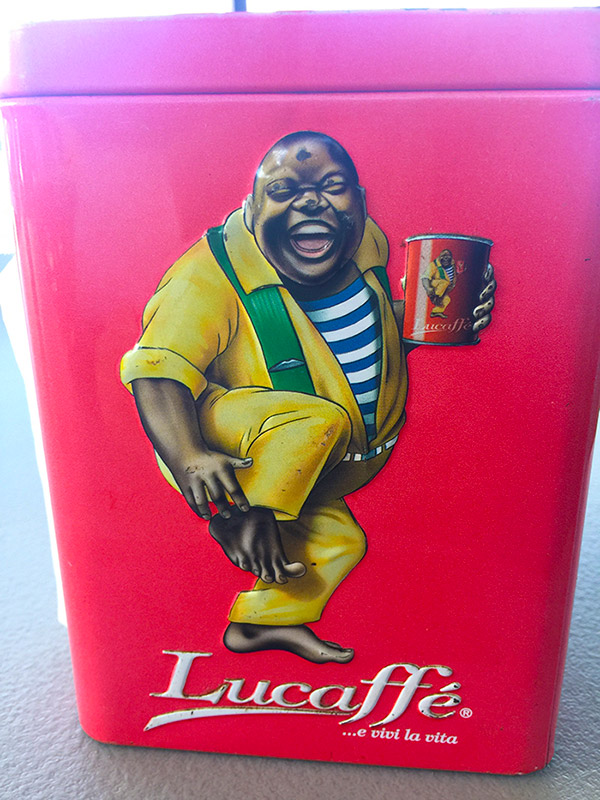
Tia and I left Rano Raraku and hiked up nearby Te Ara O Te Moai, the route that the ancient Rapa Nui had used to transport the Moai from the quarry to the ahu platforms on the coast. It quickly became evident that as difficult as it was to carve a Moai, these things were an absolute bitch to move.
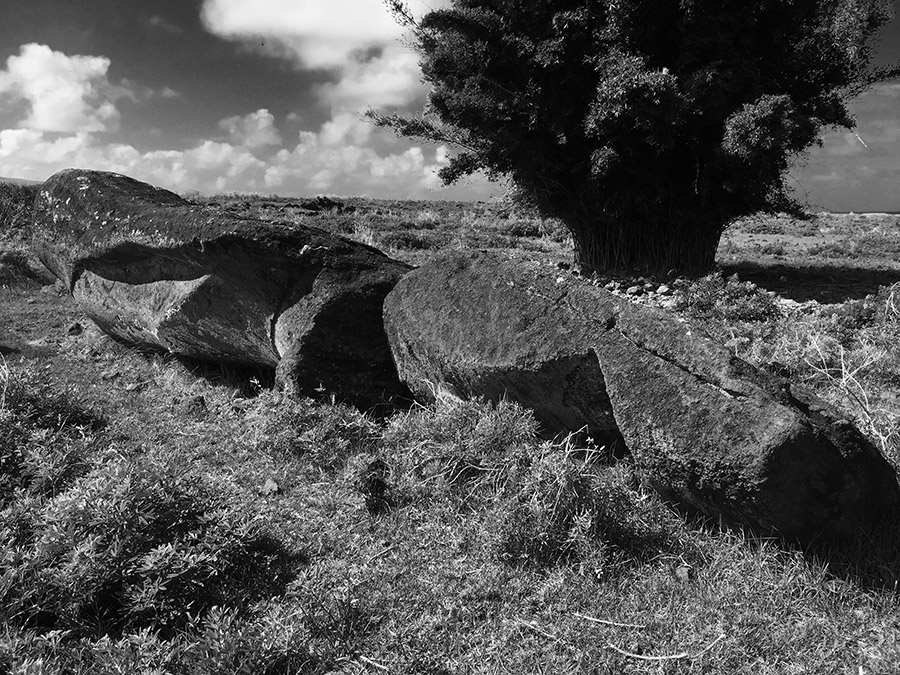
At frequent intervals along the path, we encountered Moai that had face-planted during transport and had just been abandoned there, forever face-down in the mud.
No one knows how the Rapa Nui moved the Moai, which could weight as much as 90 tons. But it was clear from the discarded statues all around us that once they fell over, they were done. There wasn’t much that could be done to remedy the situation.
When the first European visitors asked the Rapa Nui how they moved the huge statues, the locals said the Moai walked across the island. This was met with universal responses of “You jokers!” and “Look if you don’t want to tell us, you don’t have to, no need to be an asshole about it” for about 200 years.
Early archaeologists believed the Moai were laid on their backs on sleds and dragged across the island, a process that would have required the help of over a thousand people. Later theories contended that the Moai were dragged over rollers lubricated with palm oil, which would have required fewer people. Various experiments attempted to recreate these processes with fallen Moai, to varying degrees of success.
Eventually a third theory emerged that when the locals said the statues “walked,” they meant they were transported upright and rocked back and forth by teams of men pulling on ropes. With each diagonal pull, the statue would swivel and rock forward in that direction, then the other team would pull it forward from the opposite side. Early experiments with this method worked, but also damaged the base of the statues, rendering the results inconclusive.
Further research on the fallen Moai along the trail we were hiking along found that their bases did show patterns of wear consistent with being rocked back and forth, and comparing them to the Moai on the platforms, it appeared that the Moai were carved with slanted bases that caused them to lean forward, making them easier to “walk” in this way, and then the bases were carved flat once the statue reached the ahu.
Coming to the island I’d already been a believer in the “walking” theory, based on the Moai they’d successfully moved this way in the PBS special and me just tending to take the early Rapa Nui at their word. Seeing the downed Moai along the road, two things seemed to heavily support this theory. For one, if the Moai were transported on their back on sleds or rollers, I don’t know why there would be so many abandoned ones along the road. Most of them weren’t broken, so the fact that they’d just been left here heavily suggested they had tipped over and couldn’t be transported that way or stood back up again. The second thing was that every single one of the downed Moai was face-down on the ground. You’d never transport them on a sled that way, for fear of breaking the face, and the face-plant is exactly what would happen if you dicked it up while rocking the statue forward to move it.
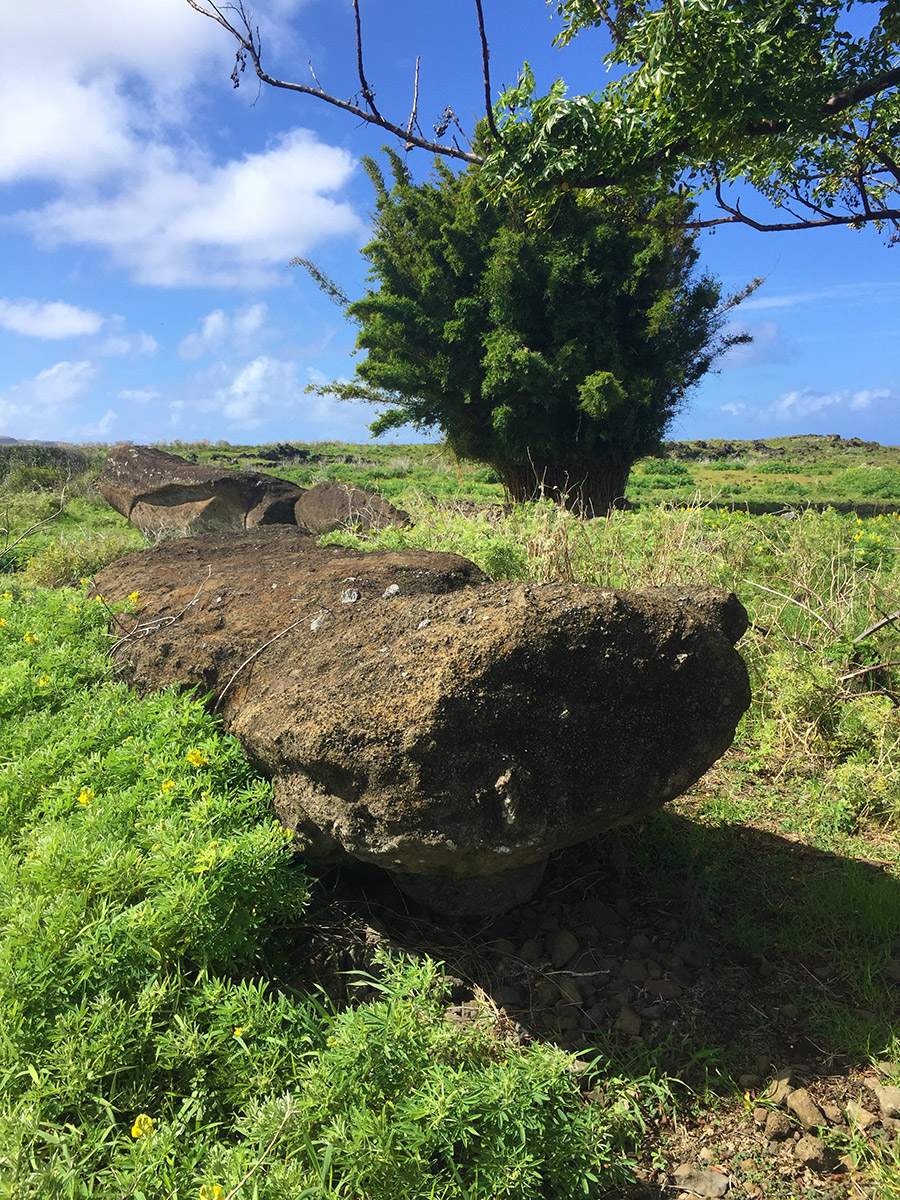
The weird thing about seeing these toppled Moai is that it didn’t inspire the intense sadness I’d experienced in seeing the Moai that had been knocked down off their ahu. Perhaps this reflected some subconscious knowledge of what I’d learn while I was on the island, that it wasn’t until the Moai were erected on the ahu and the carving of their eyes was completed that they were infused with the spirits of the ancestors. Up until that point, they were just a big rock somebody had carved.
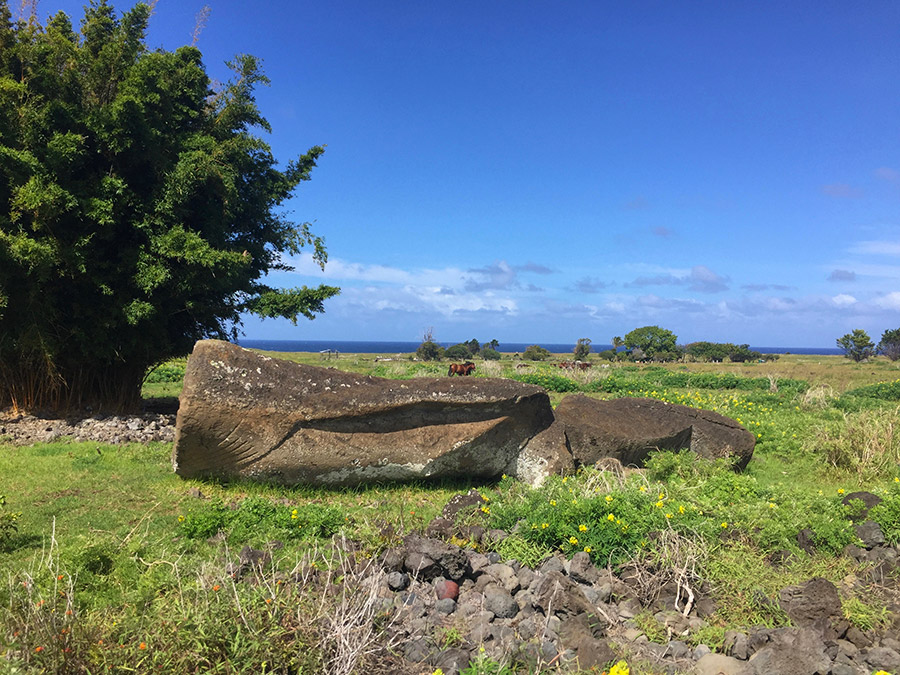
Seeing the downed Moai on the trail was actually fascinating because you could get as close to them as you wanted. All the ahu on the island were marked with signs asking you not to step on the platform, which meant you never got closer than maybe 30 feet away from the Moai themselves. I wasn’t sure if the signs were a recent addition since I’d seen tons of photos of people standing on the ahu with the statues, which is just shitty since the ahu themselves are sacred. In 2008 a Finnish tourist was jailed and fined $17,000 for breaking an earlobe off one of the Moai for a souvenir.
The first few face-down Moai at the beginning of the trail near Rano Raraku had wooden railings erected around them to protect them from selfie damage, and sported the ubiquitous signs featuring a crossed-out pictograph of an idiot climbing on a Moai. Even with these barriers you were still only about six feet away from the Moai, which was cool.
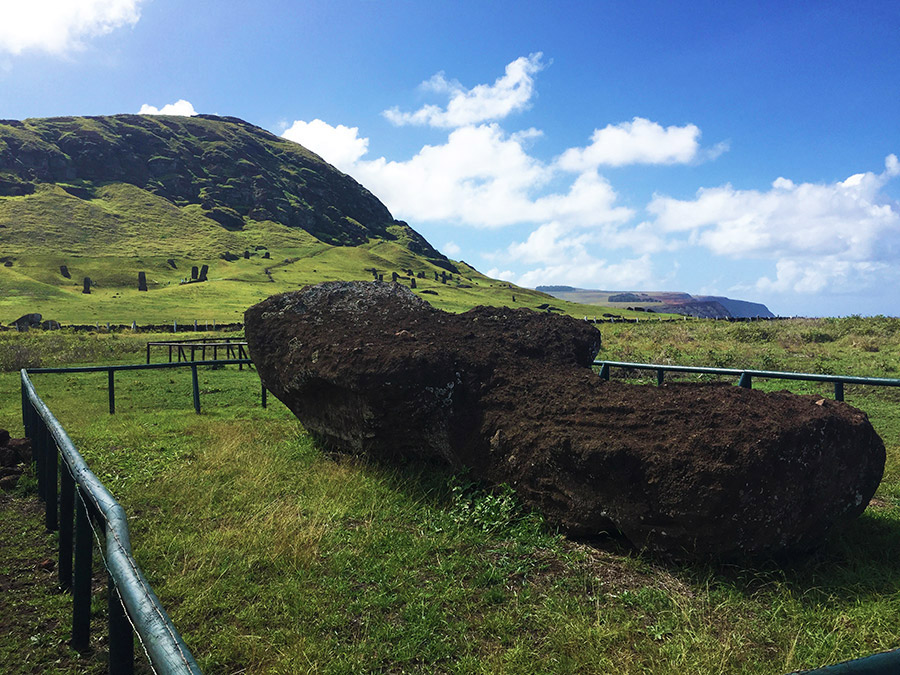
But as you hiked up the trail, very quickly it became obvious that almost no tourists make it past the first two or three Moai on the trail, this was clearly the furthest extent of their tour bus leashes. At first I laughed when the fourth downed Moai up the trail had no railing around it at all, like wow, nobody gives a shit about this guy. But then I realized it was just the practical matter that you couldn’t see this one from the parking lot, so it was safe from the masses.
All the rest of the fallen Moai along the trail were out in the open, and it was amazing to get to see them up close, to see the carving marks and how the features had eroded over time. Some of the Moai we only found by spotting the little “don’t climb on this, dingus” signs, otherwise they blended in with the lava rocks of the landscape.
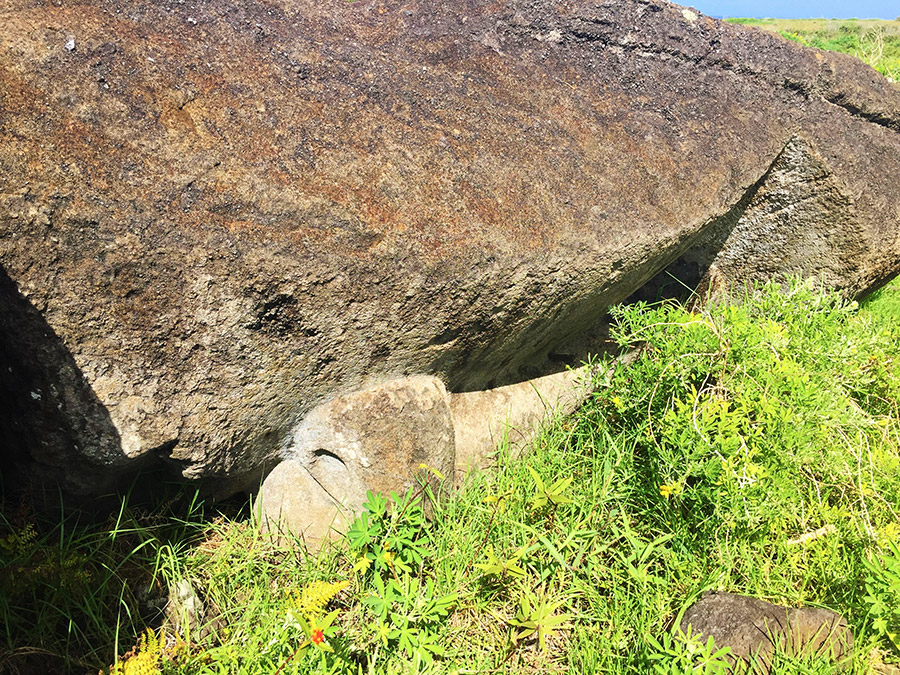
The further you got from the quarry, the more sporadic the downed Moai became. There was a certain point where if you were good enough to get it this far, you were probably going to get it all the way to the coast. The most heart-breaking downed Moai were the ones the furthest along the trail. If I was going to drop one of these things, I’d rather do it right out of the gate, not after I’d already pulled it a mile. It must have been a real kick in the nuts to have your Moai slooooowly tip over with the coast in sight.
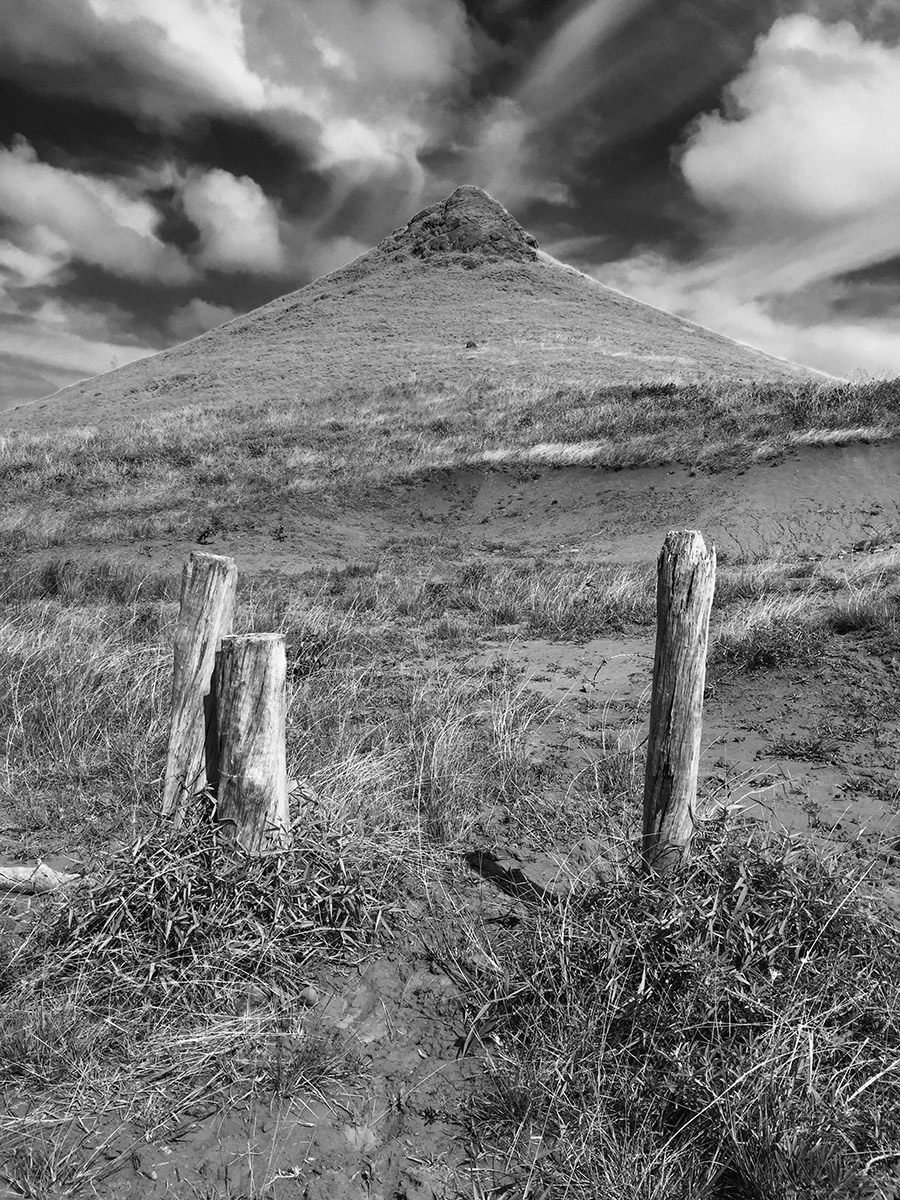
We hiked back to the jeep and cruised into town to see maybe the oddest thing I had on my Easter Island wish list: I wanted to go to jail. “In jail on Easter Island” had become my running joke answer to “Where the hell is Sean?” in recent years, my vision of the most obscure place a person could possibly be. So I couldn’t exactly visit the island now and not pop in.
This was considerably harder to find than I had expected, since there aren’t exactly “Jail! This Way-->” signs all over the island or anything. We found the right neighborhood but didn’t see anything that appeared very jaily. Down the street we found the police station, which seemed like it would probably be it.
The police station was closed. It wasn’t a weekend or a holiday or anything, it was just… it’s Easter Island, what the hell do the police have to do? But someone came over and unlocked the door in response to our peeking in the windows, to ask us why the hell we were peeking in the windows. I somehow managed to communicate “I want to go to jail!” without giving them the wrong impression entirely, and the cop gave me long, detailed directions in Spanish, which I understood about 8% of. Goddamn you, Duolingo.
We drove up the street in the direction the cop had been gesticulating as he babbled his not-English language at us. The only thing over there was something that looked like military housing, which made sense since before we found the police station we had nearly driven into an army base of some kind. Some locals walked through a turnstile into the fenced-in compound.
The sign said “Gendarmeria De Chile” and had a picture of a castle, which meant exactly nothing to either of us. I looked up “Gendarmerie” on my phone. Military police. Hmmm.
Whatever it was, I wanted to bumble in and check it out. Tia wasn’t so sure, so she hung back in the jeep.
I headed through the turnstile and walked past all the plain, identical houses on the wide streets inside the compound, feeling very conspicuous. I headed toward a white building in the distance. It definitely didn’t look like a jail, I wasn’t sure what it looked like. Is this a bar? But there were thin bars on the windows. Certainly much less than you’d see on the windows of houses in the choice neighborhoods of Los Angeles. Maybe they’re just to keep raccoons out, who knows. This might be an Elk’s Lodge.
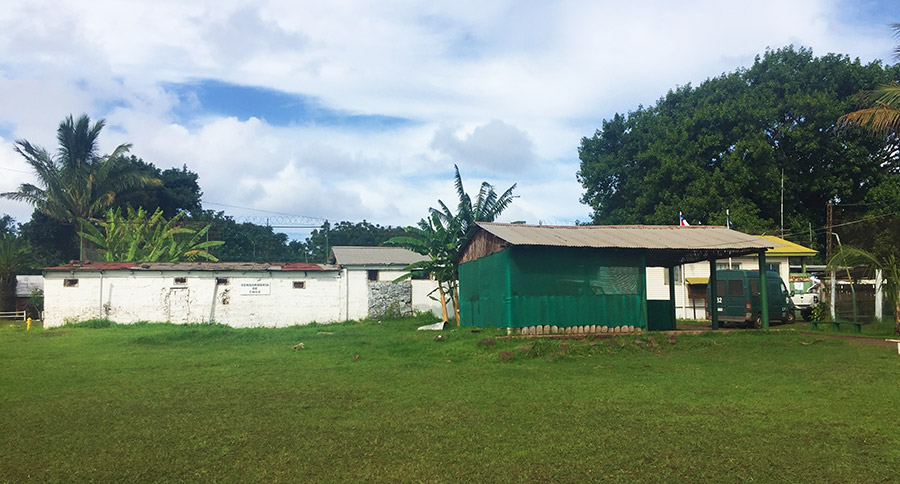
I approached a small carved wooden sign on the front of the building. GENDARMEREIA DE CHILE. There was a carved seal of a castle with a Moai in front of it. Hmm, yeah, this isn’t helping at all. I read the curved writing on the seal. COMPLEJO PENITENCIARIO DE ISLA- Ooh, penitenciario! I’m in the right place.
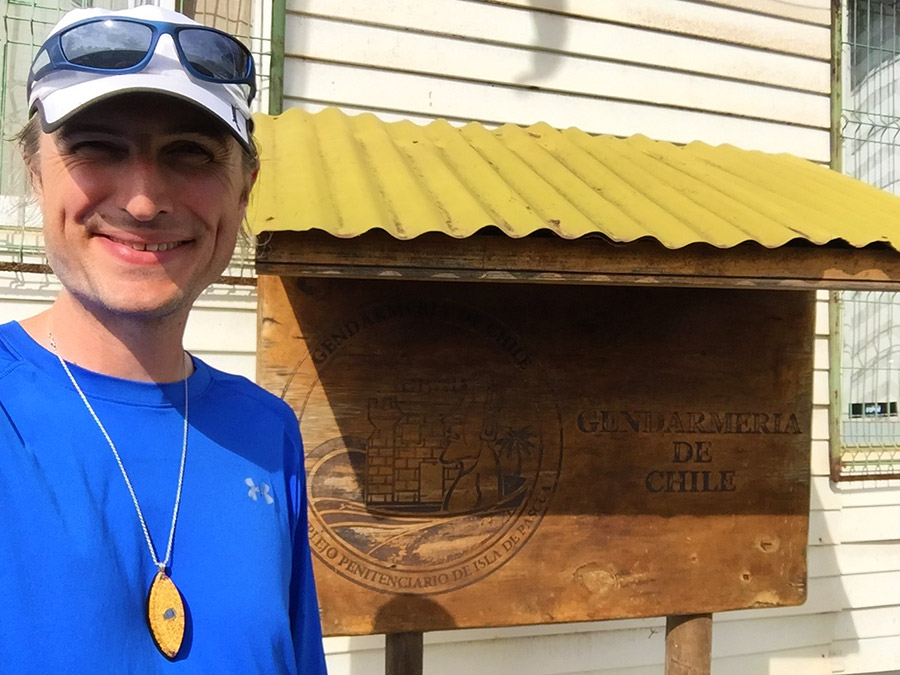
I mean, by any reasonable measure I’m definitely in the wrong place, but this is what I was looking for.
There was no front door. Hmm. I walked around the side of the building, up a narrow alley and into an unmarked side door. Yeah, this definitely might go sideways.
Inside, I waked up to a set of barred doors and a woman in a uniform buzzed me in. Okay. I walked in and the guards looked at me silently, though nonchalantly. No one stopped me so I kept walking. Inside, there was a bizarre room full of hand-made wooden crafts. People were milling about and looking at random Moai figures and assorted junk.
I did a loop. Hmmm. To one side, a barred door led into a courtyard. I peeked through and oh hey, there are the prisoners. They were carving blocks of wood in the courtyard between their cells. Oh, okay, they’re making all these handicrafts that people are coming in to buy. It seemed less like a “prison labor” situation in the US and more like occupational therapy.
I looked at the guard and gestured toward the door, which she silently opened. I started to step through and she stopped me, frowning. I stood in the doorway and took in the tropical scene. It was all extremely laid back. Not bad at all. If you have to be in jail some place, this is probably your best option.
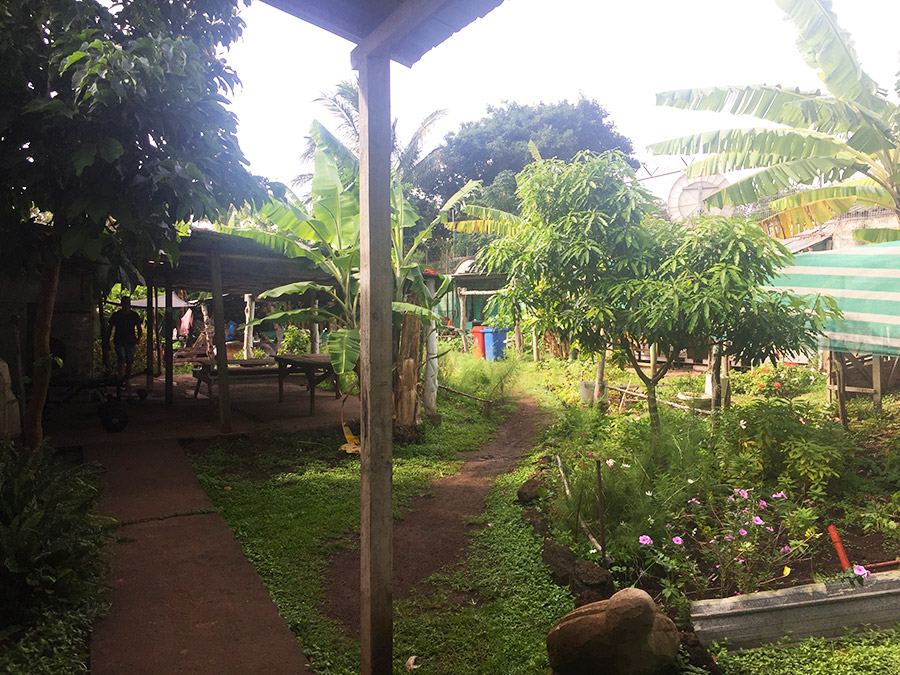
I turned to the guard and asked if I could have a tour of the inside of the compound. She was smiling and friendly until she realized what I was asking. Ha ha, no, are you crazy? This is a prison! All right, that’s cool. I snapped about ten photos in a row before she told me I couldn’t take photos. Not “you have to delete those” or anything uptight like that. Ten was apparently just the limit.
I woke up in the middle of the night, damp, and thought I was on Noah’s Ark. The sea swelled thunderously all around my cabin. Wow, the ocean is so loud tonight! Wait, I’m nowhere near the ocean. Holy shit, that’s the wind and rain. Rain was streaming in through the window sideways.
Shit. This morning was going to be my last chance to see the ceremonial village of Orongo, the best archeological site on the entire island. Hopefully this is just an overnight shower.
The main advantage of the hellacious storm is that it had washed all the roosters out to sea and after slamming the window shut, I was able to fall deeply back to sleep in my damp bed.
Tia and I had driven up the volcano to see Orongo twice already. The first time, the entire top of the volcano was shrouded in fog, so we just took in the Rano Kau crater’s misty majesty and drove back down. The second time we got some nice photos.
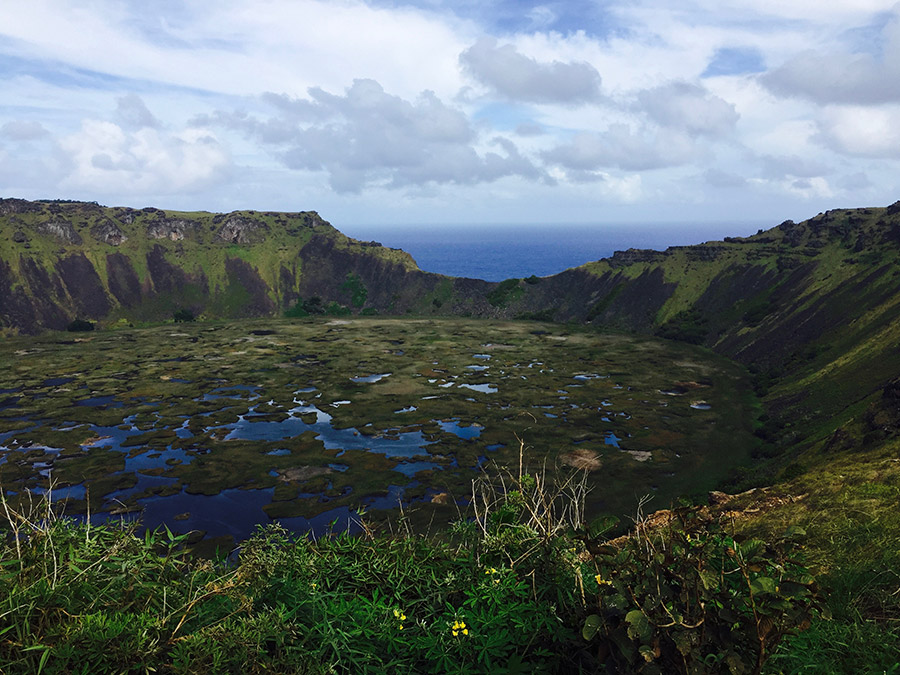
The Easter Island parks pass only allows you to visit Orongo and Rano Raraku, the stars of the island, once each. They’re the Space Mountain and Indiana Jones Adventure of Rapa Nui, so you don’t want to waste your Fastpass if it’s foggy and shitty and you’re not going to be able to actually see anything. Better to come back the next day. The parks employees made it clear you can go to all the other spots as many times as you want, hell you can sleep there, we don’t give a shit.
We returned to Orongo the next afternoon in better weather. Right as we pulled up, a parks employee came out and told us it was closing time and we had to leave. It wasn’t closing time, at least by any posted notice, but I couldn’t argue with the fact that when all the employees decide “fuck it” and go home, the place is closed.
I was getting good at driving the winding road up the side of the volcano. On our way down after our second failed attempt, I weaved between the many cows hanging out on the road. As a huge cow who was blocking the entire road moved out of the way, I rolled my window down while driving by and said “Hey. What’s up.” The cow gave me a sad, worried look that seemed to say “All I want to do is eat the grass but people want me to move all the time, I don’t know where I’m supposed to be, I just want to eat the grass you know?”
My alarm went off and it was time to make my third and final attempt at Orongo. I sat up and listened. It no longer sounded like I was inside a dishwasher; the rain must have stopped. I popped my head out the front door. Dark clouds hung ominously in the sky, but they were keeping it in their pants. All right. Orongo, here I come.
I texted Tia to see if she was up for a morning drive up the volcano. She still had a few more days on the island after I left, so this wasn’t her last chanc- Okay yeah she’s sleeping in. Probably smart.
I wound my way up the volcano and parked at the locked gate for Orongo at the peak. It should be open by now, but it’s Easter Island, not Germany. They’ll get up here and open it eventually.
I sat in the jeep and read a book as the wind picked up. And then it picked up some more. And then it tried to pick up the jeep! The wind was blowing so hard the jeep was rocking violently back and forth, and I wasn’t 100% certain the jeep wasn’t going to tip over. I peeked out the passenger side window and tried to figure out if the jeep had room tip over on its side without rolling back down the volcano.
A couple of cars drove by, and park employees hopped out to open the gate. The wind was nearly ripping their clothes off of them as they staggered toward the gate and wrestled to get it open. Eventually the gate relented and I followed them up to the visitor center.
All hell was breaking loose as we parked in front of the center. Everyone who got out of their cars was failing hilariously at the task of walking in a straight line, as their hair shot straight up into the air and they made barely perceptible progress toward the visitor center’s door.
Once I saw that they’d got the front door unlocked, I cautiously opened the door of my jeep. The second I broke the seal, the door flew forward, yanking the handle straight out of my hand, and the door exploded to its fullest extension with an expensive-sounding crunch and a jolt that shook the entire vehicle. Oh man. Sorry again, jeep.
I stepped out into the chaos, my clothes attempting to jump off my body as my hair all blew straight up my nose and into my mouth. I wrestled the door shut and lurched my way to the front door of the visitor center.
Inside there were some museum exhibits explaining the history of Orongo and the meaning of the various sites you’d see once you headed out the back door. I headed toward the door and one of the park employees stopped me.
(In Spanish) “Whoa whoa whoa, you can’t go out there. You’re gonna get blown off the goddamned cliff.”
“I’ll be careful.”
“Sorry, I can’t let you.”
“Is there some kind of waiver I can just sign or something? I’ve been up here three times and this is my last chance to see it before I leave the island this afternoon.”
I’m not sure if she felt bad for me or if she had no idea what I was saying and was just tired of the sound of my voice, but after thinking about it for a second, she agreed to let me go out as long as she came with me so she could point and laugh if I fell off the cliff.
Once we got out the door I realized why she’d been worried. The entire site is on an exposed cliff face, and there was definitely a very real chance of getting blown off and falling a thousand feet down into the sea.
The parks woman and I chatted in my shitty Spanish and her no English at all (yeah she had clearly just been tired of the sound of my voice earlier) as we browsed the rows of low stone houses built into the hillside.
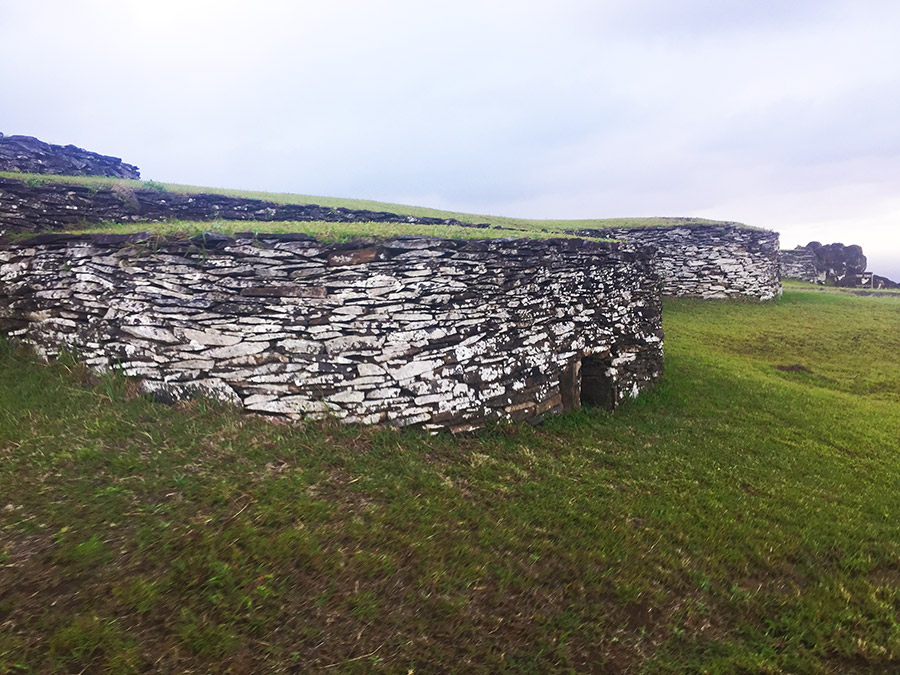
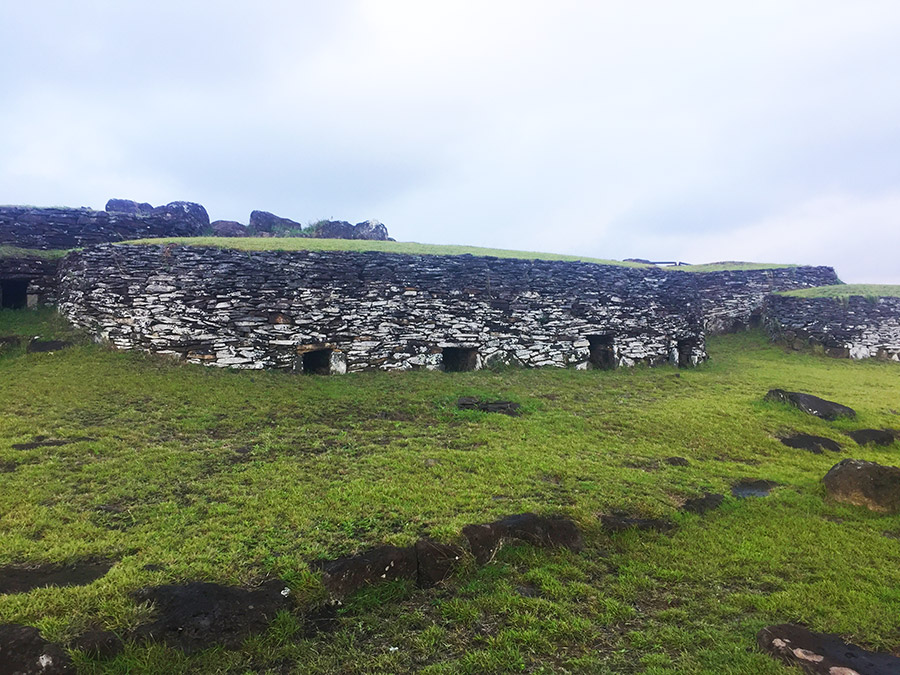
Eventually we reached an overlook, from which you can see Motu Nui, the tiny island off the coast that was famously the center of the island’s Birdman competition.
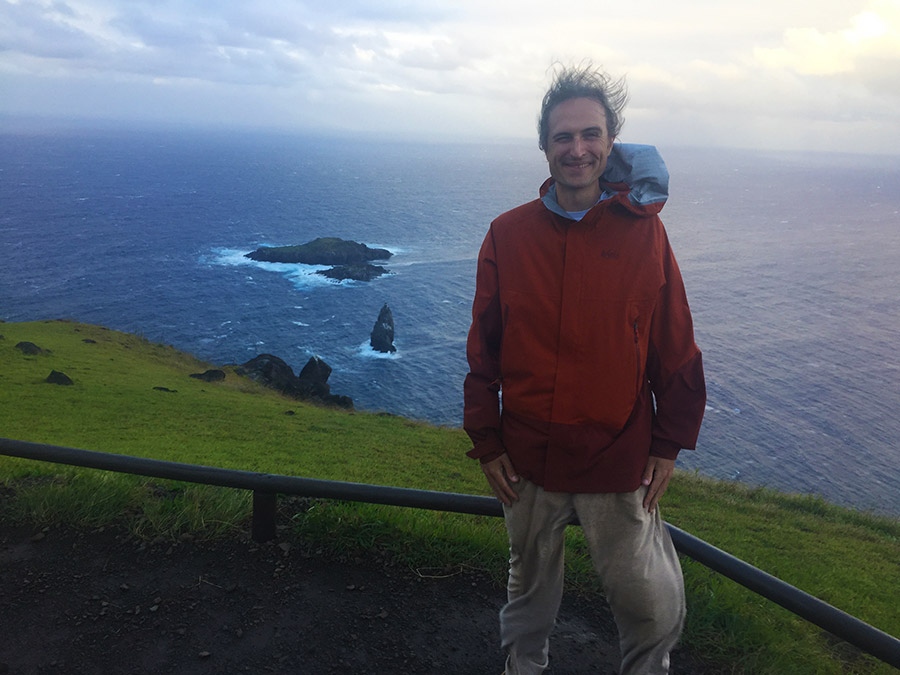
After the Moai-based culture on the island collapsed, it was replaced by the Birdman cult. This religion involved a yearly competition where a representative from each clan would compete to capture the first sooty tern egg laid on Motu Nui that year and swim with it through the shark infested waters back to Rapa Nui, finally climbing the cliff back up to Orongo. If they managed to pull this off without falling to their death or being eaten by a shark, the head of their clan would essentially be the king of the island for the year. This wasn’t as great as it sounds though since the king had to shave his head, paint it red, and live in seclusion for five months while his fingernails grew out. So basically the prize was getting to be the Howard Hughes of Easter Island.
As we reached the highest point on the trail, I asked where the carvings of Make-make, the god of the Birdman cult, were located. The parks woman pointed over to the narrow point of the cliff face, beyond the railing and surrounded by rapidly eroding soil falling off dramatically on all sides. The point was audibly cutting through the hellacious wind like a knife. We both looked at each other and burst out laughing. Yeah, nobody’s going out there today.
Then it started to rain sideways. Time to go, the parks woman signaled, and I agreed. I slowly staggered back to the visitor center, leaning into the wind and hoping it didn’t suddenly shift directions.
Once I got inside I settled into reading the various exhibits and plaques in the museum. I was about three minutes into this when one of the parks employees tapped me on the shoulder and nicely told me to get the fuck out of there. They were closing the whole place for the day after 20 whole minutes of it being open and me being the only person who actually got to see the site. I couldn’t blame them though, as other tourists were starting to show up and there was no way they were all gonna avoid being blown off the cliff into the sea. Better luck tomorrow, guys. Or maybe the next day.
Tia and I said our goodbyes over lunch, after I had pissed off the owner of the island’s pizzeria by trying to order a pizza without any cheese on it. We’d ended up ponying up for the island’s expensive restaurant eats far more than expected, as it turned out that my disgusting spaghetti ingredients from Santiago made disgusting spaghetti. Who knew?
As I packed up and waited for my ride to the airport, I spent a frankly ridiculous amount of time sorting out my trash and finding the right recycling bins for all of it, because what kind of asshole travels to a place famous for being a microcosm of our environmental short-sightedness and then just tosses all his shit in the trash?
I returned my poor, abused jeep and though the guy did pause YouTube briefly to make sure the jeep wasn’t actively on fire when I returned it, the whole process went smoothly. Jackeline gave me a ride to the airport, which had a hilariously casual baggage-scanning procedure that seemed to be entirely voluntary. Before I knew it, I was up in the air and leaving Rapa Nui to return… home? My entire concept of this was all mixed up now.
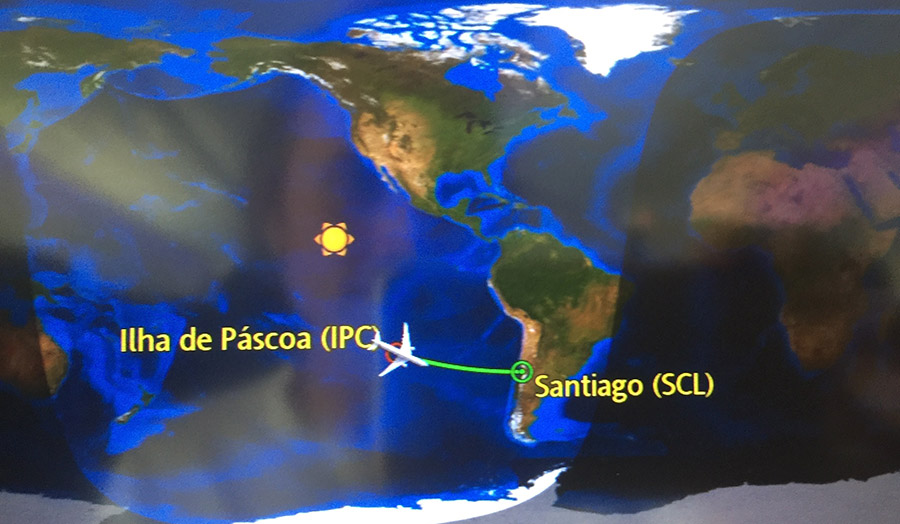
After I got back to Minneapolis, I spent several weeks in a bizarre Twilight Zone similar to what I had experienced last year after my trip to Japan. After that trip, I had spent a solid three weeks waking up every morning absolutely, 100% convinced I was still in Japan. This probably sounds like “oh ha ha, funny, vacation’s over bub, time to return to regular life sleepyhead!” but it was actually one of the most surreal things I’ve ever experienced. Every morning I would wake up and had absolutely no idea where I was. I wouldn’t recognize my bedroom at all and would assume I was in a hotel. I’d spend several minutes thinking about what day it was and how I had to get to work, but how in the hell am I going to get to work from Japan?
One night I had a dream that I was exploring a cave in Japan, fumbling around in the dark, feeling the cave walls in the pitch black. Eventually I ran my hand across something strange on the wall of the cave. It was a switch of some kind. I flipped it and suddenly I was at home, standing in my bathroom. I’d been sleepwalking, for the first time in my life. Weird.
Eventually I realized that some part of my soul was still doing work in Japan. Maybe it had to do with contacting Kobo Daishi over there, or maybe it was a continuation of my Bear Medicine experience in Nagasaki. My body had come back to the US, but a good portion of my energy was still over there for whatever reason. I’d had the experience before in my life that some nights my dreams didn’t seem to be dreams, it seemed clear that I was off somewhere else in spirit form, doing something I only vaguely remembered. Was I in the afterlife? Or somewhere else in the physical world? I was never sure.
There is the idea that we need sleep because this is our soul’s chance to exist in its true form, as our higher self that knows who we are and what we’re doing here. A chance for the soul to recharge after being forced into the limited experience of life in a body all day. Something had opened up in my awareness during my experiences in Japan to where I was much more conscious of these experiences now. The process of waking up every morning was like an extremely rapid and disorienting transition between whatever the hell I was doing in Japan at night and my daytime gig in the US. The first few times it happened I thought I might be losing my mind, but eventually I came to understand the process better and made peace with it.
Now I was experiencing the same thing after returning home from Easter Island. Every morning, where am I? How am I going to get to work in Minneapolis from Easter Island? I’m going to be REALLY late. What hotel is this?
I’d have vague memories of having been on the island only minutes before. This time the experiences carried on every morning for over a month. I found it interesting that this only happened after my trips to Japan and Easter Island, which were by far the two most spiritual trips I’ve ever taken. On both trips I contacted something deep beyond my previous understanding, something that shifted my very concept of who I was. I seemed to have strong past-life ties to both places, and I wondered if that was why my soul took its time returning fully back to the US, long after my body had.
Nothing like that had happened at all after my trips to North Korea, the Southwestern US or Turkmenistan between those two trips. So now I’m curious which future trips will just be trips and which will fall into that new “the very fabric of reality warped” category.
The other door this trip really opened up for me is realizing what an avenue to awareness the emotions can be. I’ve always spent my spiritual seeking searching for concrete mental understandings, clear visual memories, etc. But all of that is so subject to the mind shutting things down, and our beliefs, both conscious and unconscious, preventing us from having experiences we don’t think we’re capable of having. But the emotions bypass this system entirely, and my time on the island showed me over and over again that there is a ton of understanding and awareness available to me through this huge gateway I’ve never fully explored before.
Now that I can see this it seems silly that I’ve been so locked in my head in my pursuit of understanding up until now. But it makes sense when I look at our culture and what we’re taught to value. Our educational system is geared toward developing the mind, to the complete exclusion of the emotions. I can’t recall a single class in my entire educational history that had anything to do with the emotions at all. Even classes that study behavior, like psychology, ultimately tie it back to the mind in an almost mechanical fashion. This might seem like a silly thing to point out, like it’s absurd to suggest that school should teach us to explore how we feel and what it means. But I think this is just a symptom of how pervasively our culture adopts this mindset and teaches it from birth. It’s one of those “that’s the way it is” things so completely ingrained that you really have to take a step back to even see how odd it is.
It reminds me a bit of when I was studying music and struggling to develop absolute pitch, the ability to hear a note and recognize that it’s an A or a C sharp. This seems like a magical ability that only a few lucky people are born with, a freak gift, until you realize that we can all do this with colors. Virtually everyone can look at a color and tell you it’s blue or red. This is the same thing, just taking a wavelength and being able to put it into a category you’ve memorized. But our culture is far more visually-centered than it is auditory, so we respond by teaching and developing this ability in one realm but not the other.
The more I delve into emotional awareness, the more I see what a huge bias there is against this in our culture. This is fascinating to explore. To one set of people, talking about and exploring the emotions is weak and soft. As a boy you completely shut that awareness down and demonstrate your toughness and strength by proving you can ignore how you feel, lest you be ostracized on the playground like a zebra that’s not gonna make it the next time the lions come around.
But even the majority of the people who have evolved beyond this weird “emotions are for girls and girls are weak” mindset still tend to shut down their emotional awareness, because the emotions seemingly aren’t logical. They’re subjective and fuzzy and as a rational, modern person, you can’t take them too seriously. That’s for hippies and hysterical women and superstitious people, not for anyone you really respect. Sure, the emotions need to be dealt with on some level so you don’t snap one day and shoot up a car dealership, but good God man, they’re not real. They’re just some chemical reaction in the brain so take this pill and get on with it. Have a beer and watch this movie and eat this junk food that numbs you out of feeling anything. The emotions only matter when they’re getting in the way of you being a productive member of society, at which point they’re grudgingly tolerated until a solution can be found.
How much of this is just the way we’ve evolved and how much is a social control? I’m not into conspiracy theories but I can’t help but notice that everything that leads to greater self-knowledge is actively discouraged in popular culture. Maybe this is all of us collectively avoiding looking at what we don’t want to see in ourselves. Or maybe it’s imposed to make us easier to control and profit off of. I don’t know. I suppose ultimately the cause matters less than what we do about it.
And so I sit. One of the first things Kobo Daishi said to me was “go into your heart.” And so I sit and put my attention on my heart and feel whatever comes up. Every time an uncomfortable feeling comes up, we’re so good at immediately doing whatever it takes to not feel it. We reach for whatever our tried and true distraction is. If it’s not one of those activities that numbs us, it’s some action that temporarily convinces us that the feeling isn’t true. “I’m not good enough? Well watch this, I’m going to accomplish something! Take that!” “I feel guilty for even existing? Look, I just did something nice for someone else! What a good and justified person I am for the next ten minutes until that feeling comes back.” To just sit and feel whatever it is, uncomfortably and completely, without seeking any relief, is kind of a radical step.
The more I just exist with these feelings the more I realize we carry them forever until we sit with them. Once you delve into the feeling and experience it completely, it releases. But for as long as you push it away, it’s a millstone you carry forever. Elderly people are walking around carrying feelings from when they were five years old. It’s a fascinating and sad part of being alive.
Our capacity for avoiding self-awareness is endless. I recently took a few weeks off from watching TV and movies. I was starting to realize that I was self-medicating in a way, and living in this strange paradox where I’m yearning to be more aware and working tirelessly in that direction, and yet at the same time I have these habits and routines that are like willfully going to sleep and hitting the chapter skip button to jump head two hours closer to the end of my life.
After a week or two of no TV, I realized I was spending hours and hours reading articles and random nonsense online. It was compulsive in a sense, feeling that painful spark of boredom and being magnetically drawn to click and open another browser tab, on and on down the rabbit hole. I had just replaced one timesuck with another. So, after a couple of painful false starts, I managed to give this up too. Great. Way to go Sean. Only, after a week or two I noticed I was working insanely late every single night.
Shit. I’ve just replaced one thing with another, with another. I reflected on how much I love to get absorbed into projects. I can completely lose myself and not realize hours upon hours have passed. There’s some kind of magnetic pull to this, almost like a drug. It feels great! Hmm. Kind of like that rabbit hole of internet links. Kind of like when I used to make a game of seeing how many movies I could watch in a single weekend. Hmm. It’s all the same.
I’m realizing that life is just a long series of ways that we avoid self-awareness. My mind is great at telling me I’m not doing this. That whatever I’m doing is actually positive and constructive. Of course I needed to stay up all night working on this project, look at how much work I got done! What a good employee I am. Actually, it’s good that I read random Wikipedia articles for four hours straight. I’m so much more informed now. Look at all this knowledge. And I needed to watch that movie, because what’s life without some entertainment? I don’t want to be a robot who just works all the time, jeez.
But all of it is stepping into that sweet oblivion of not having to be aware of myself, not having to be alone with my feelings. Pushing the moment when I truly encounter those emotions further off into the future. When I think about it, what is entertainment, really? Distraction? We say that like it’s undoubtedly a good thing. Everybody needs a break, right? But what if our entire lives are elaborately constructed breaks from facing ourselves?
And so I sit. How do I feel?